GKY PLUIT
Meyer Sound makes its mark with Ultra-X Singapore: MICA (P) 031/05/2022 PPS 1644/05/2013(022954)

BASIC SIGNAL ROUTING CHOOSING A PTZ
THE PLATFORM WITH THE AMPLIFIER ON BOARD. AV LIGHTING SOUND REINFORCEMENT RECORDING STAGE SOUND BROADCAST May–June 2023 AV ON THE NETWORK TROUBLESHOOTING DMX

ON BOARD. Unica is the next-generation cloud based amplifier platform designed to provide a safe and consistent user experience for any size application, whatever your installation requirements and efficiency goals might be. Unica cloud based amplifier platform. Unlock the power of consistency.
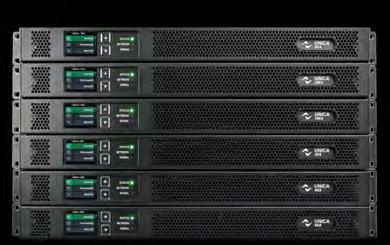
AMPLIFIER
THE PLATFORM WITH THE DANTE EMBEDDED MORE INFO
Don’t just hear it. Hear it right.
You’ve heard us amplify with perfect clarity. You’ve heard us in standing ovations. You’ve even felt us, in the standing hair on your arms. And now, get ready to experience all the ways we deliver honest sound. meyersound.com
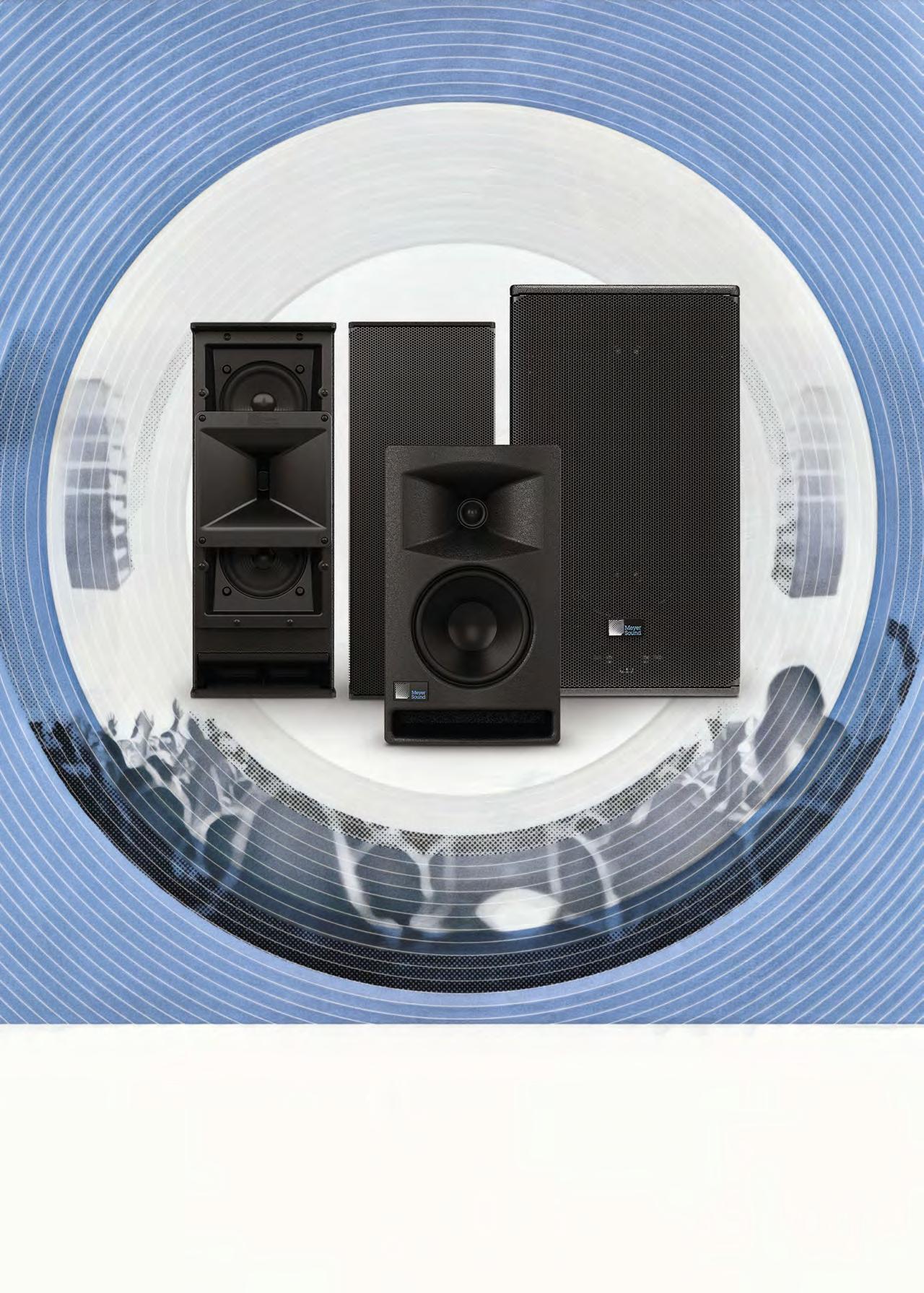
The year seems to be flying past already – the holy month of Ramadan is underway and Easter is around the corner. It won’t be long before HOW tech teams will be starting to plan for Christmas!
Richard’s latest monthlong trip around Asia has resulted in a collection of HOW installation stories from the region. In Indonesia, he visited GKY Pluit which turned to PT Kairos Multi Jaya to install a Meyer Sound setup in the church’s two campuses – the first consecrated in 1984 and the second located on the third level of the newly constructed Gedung

to northeast Jakarta, Richard also visited Impact Community Indonesia (ICI) church, which has converted an upper-level car park into a modern and vibrant church. Here, ASIIS has installed an Audiofocus loudspeaker system for the wide, yet shallow asymmetrical auditorium.
I’d also like to welcome RF Venue’s senior applications engineer, Don Boomer, who, in this issue, highlights how to get a signal that is at least 20dB stronger than the interference level at your venue.
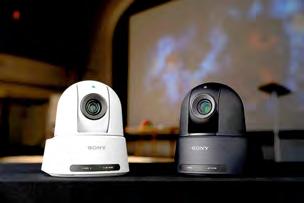

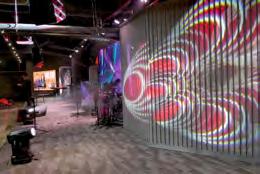

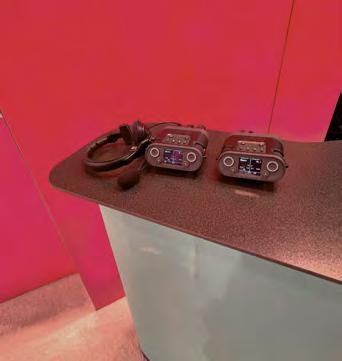
I hope you enjoy the issue.

Follow us on social media @WorshipAVLMagazine





May–June 2023 WORSHIP AVL 3 LICENCES: Singapore: MICA (P) 031/05/2022 PPS 1644/05/2013(022954) CIRCULATION: circulation@worshipavl.com All rights reserved. No part of this magazine may be reproduced or transmitted in any form or by any means, electronic or mechanical, including photocopying, recording or by any information storage and retrieval system, without prior permission in writing from the copyright owners.
Contact us Contents May–June 2023 Issue 80 Email: kwallace@worshipavl.com PUBLISHED BY: 18 Upper Grosvenor Road, Tunbridge Wells, Kent TN1 2EP, United Kingdom Tel: +44 (0) 1892 676280 Web: www.worshipavl.com lstonell@worshipavl.com Richard Lawn General manager rlawn@worshipavl.com Caroline Moss Contributing editor cmoss@worshipavl.com Nick Smith Digital media manager nsmith@worshipavl.com Adrian Baker Production manager abaker@worshipavl.com Carolyn Valliere Sales associate cvalliere@worshipavl.com Simon Luckhurst Senior reporter sluckhurst@worshipavl.com Sue Gould Advertising director sgould@worshipavl.com Chris Yardley Video editor cyardley@worshipavl.com Marne Mittelmann Circulation manager circulation@worshipavl.com COVER: GKY Pluit PRINTER: Times Printers Singapore COMMENT PROJECTS KNOWHOW TECHNOLOGY PRODUCT SPOTLIGHT TECH VIEW 10 Dunamis International Gospel Centre 12 Bridge Church 14 GKY Pluit 18 First Baptist Church Woodstock 20 Impact Community Indonesia 24 Cathedral of the Nativity of Christ 26 Christian Fellowship Church Zurich 28 AV on the network 30 Choosing a PTZ 32 Troubleshooting DMX 34 Digital mixing for hybrid worship 36 Basic signal routing 38 Three-point lighting guide 4 Azizi Ala, Robert Soo and Don Boomer 58 AVTECH Integrations 43 The industry’s most comprehensive product news 40 Blackmagic’s ATEM Television Studio HD8 Editor’s Letter NEW PRODUCTS 20 24 26 30 38 43
Maintaining signal integrity

AS I MENTIONED IN MY previous article, the main objective for a visual system is visuality, which consists of two parameters: namely visual acuity and visual quality. To reach these objectives, various factors need to be considered during the design process. There are three essential components – source, switcher and display – that need to be considered. Each component has its own role and function so that the signal integrity from the source to the display is maintained and the best visual outcome is achieved using dedicated cabling. In this latest article, I’ll touch on the themes of system design and common equipment used for visual systems in mosques.
Design criteria
Technically, every design needs to start with a concept based on the features and applications required by the user – such as a recording function or streaming/ broadcasting capability – before the desired native video resolution is decided for the design. The higher the resolution, the clearer the video and it should be remembered that the choice of resolution will be proportional to the overall cost. The result of this decision will lead to which equipment will be selected, in other words the chosen equipment must comply with the chosen resolution to guarantee that the native resolution can be maintained in the signal chain from the source to the display. Full HD and UHD 4K are nowadays the most common resolutions, as low-resolution options such as VGA are slowly fading out of use. Both resolutions commonly used HDMI as an interface rather than SDI,
of a scheduler and countdown timer and is primarily used as a prayer reminder through a visual notification on the display. In Malaysia, prayer times are different between regions or states –taking this into consideration, the Islamic informative media is automatically updated and synced with the Department of Islamic Development Malaysia server to maintain the accuracy of prayer times based on the location of the
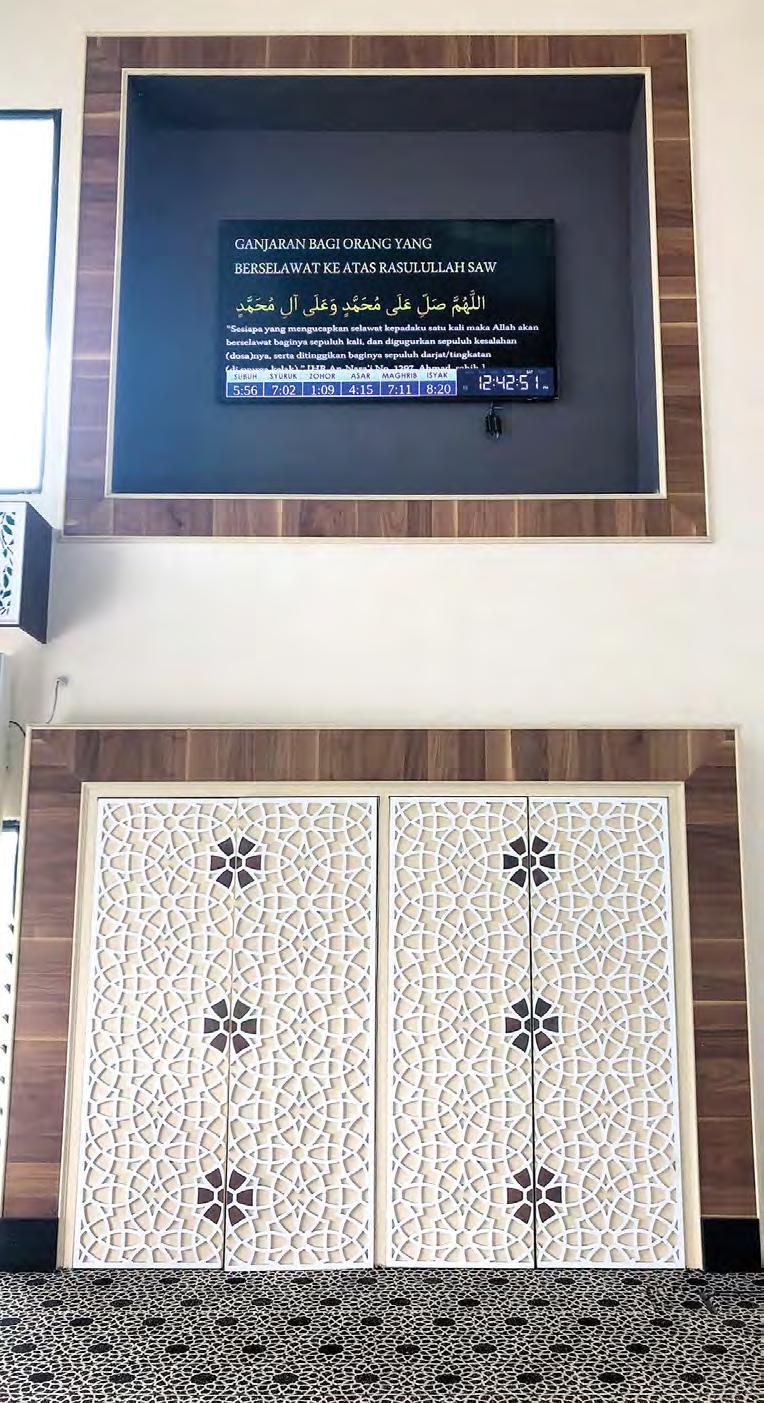
Second, a camera is used to capture images/videos of the preacher during a sermon. It’s usually installed on columns or a beam structure and can be either a fixed view or pan-tilt-zoom (PTZ) camera. A fixed camera is a cost-effective option but lacks controllability compared to a PTZ, which is much more flexible and can be steered using a remote camera controller. Nonetheless, it’s crucial to know the correct focal length specifications for which camera type you are using, based on details such as camera distance to subject, desire subject width or height and CCD (charge coupled device) image size, to guarantee images/videos are sharp
Last but not least, the wall plate input panel is used to accept any video input source externally through a dedicated interface, such as HDMI, DP and VGA. In terms of installation, it can be wired straight for a short-distance installation and, conversely, become an AV transmitter or encoder for longdistance installations.
In the next issue, I’ll continue on the same theme of system design but with more explanation on equipment selection for visual systems in mosques. Until we meet again, take care.
4 WORSHIP AVL May–June 2023
COMMENT
Azizi Ala considers the importance of choosing your required video resolution before choosing your equipment
Azizi Ala
Founder and technical director at Acousticon Sdn Bhd
Display unit (TV) with prayer reminder times on the screen
Introducing the world’s most portable all-in-one television studio!
The new ATEM Television Studio HD is a professional live production switcher built into a broadcast control panel so it can be used for high end work while being extremely portable. You get a powerful switcher with 8 standards converted SDI inputs, 2 aux outputs, 4 chroma keyers, 2 downstream keyers, SuperSource, 2 media players and lots of transitions! There’s even an ISO model that records all 8 inputs for editing!

Easy to Use and Fast to Learn!
There’s never been a switcher that’s easier to use, as you simply press any of the program row buttons on the front panel to cut between video sources. You can select from exciting transitions such as dissolve, or more dramatic effects such as dip to color, DVE squeeze and DVE push. You can even add a DVE for picture in picture effects with customized graphics. Then you can live stream the results!
Self Contained Broadcast Quality Switcher
ATEM Television Studio HD combines a switcher and control panel into the same unit, so it’s extremely portable. The front panel includes buttons for selecting sources, triggering transitions and setting up video effects. You also get a built in t-bar for manual transition control! The front panel even has an innovative audio mixer control area with live metering on a dedicated LCD.
www.blackmagicdesign.com/sg
Record to Internal Network Storage!
ATEM Television Studio HD8 ISO supports recording all video inputs to optional M.2 internal flash storage! The internal storage will then be available to share over the local Ethernet network so you get a whole post production workflow! This means people can work on post production tasks such as editing, color correction and graphics preparation while recording new live shows!
Built In Fairlight Audio Mixer
With a built in Fairlight audio mixer, ATEM Television Studio HD makes it possible to do complex live sound mixing. The internal mixer features enough channels for all SDI inputs, as well as extra channels for the XLR, RCA and MADI inputs! Each input channel features the highest quality 6 band parametric EQ, compressor, limiter, expander and noise gate as well as level and pan controls.
ATEM Television Studio HD
From S$4,045
Learn More!
SRP is Exclusive of Taxes.
Let’s do it better! Livestreaming worship services
Robert Soo looks at the ways churches can improve the quality and overall online experience for their stay-at-home worshippers
WELCOME BACK TO ANOTHER
edition of “Let’s do it Better!” which aims to elevate church AV to a new level of excellence. It’s been three years since the pandemic caused an unprecedented global movement of churches to stop all in-person worship services and move to online streaming to keep the faith alive. Fast forward to today, though the world has pretty much opened up and transited to an endemic phase, many churches are continuing the practice of livestreaming their worship services for those who either cannot attend in-person or, for various reasons, choose to participate remotely. As such, these churches are constantly seeking ways to improve the quality and overall online experience for their members. So, in this third edition, I will be touching on the finer points of streaming a worship service.
When it comes to considering which elements to focus on, the two that usually get the attention would be the audio and video systems. However, there are actually five elements involved, with the three less considered being lighting, supporting IT infrastructure and the people behind the streaming operations. So, let’s talk about each element, starting first with audio.
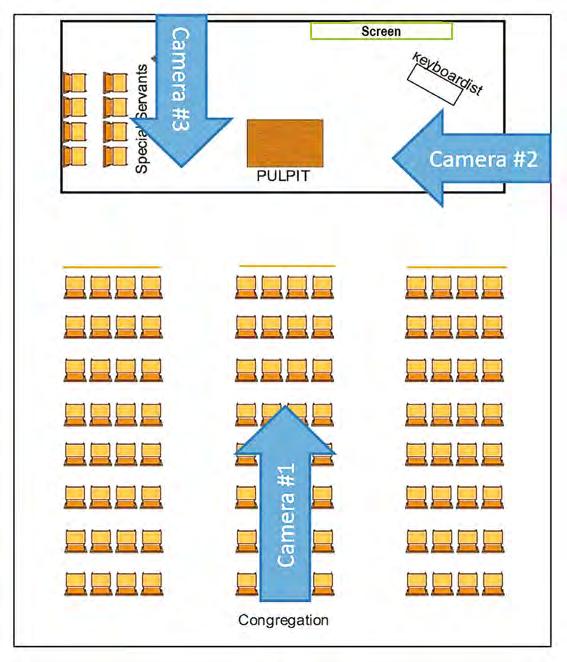

In the May–June 2022 edition of Worship AVL, I covered in detail the essential audio system requirements as well as good practices in my “What’s Audio got to do with Church Worship?” article, which should still be available online for anyone who has missed it. Without dwelling on what I have already expounded on previously, here is a quick summary on how to deliver the right sound experience to online worshippers:
• Set up an independent audio mix for the stream, as a direct tap from the main FOH mix just wouldn’t
sound balanced for the online listeners. It is important that this setup is isolated or completely sound insulated from the worship sanctuary, as the sound spill will only interfere and influence the way you mix for the stream. Also critical is the use of accurate reference studio monitors or headphones to ensure your sound mix translates correctly.
• If a separate mix is not an option, two areas need to be well managed – stage noise must be kept as low as possible to reduce any influence on the mix balance and, secondly, the FOH loudspeakers need to be tuned appropriately to correctly translate mixes to home listening devices.
• Add a touch of immersive realism by enhancing with digital effects, sound staging and including the congregation in the mix. This will provide the online worshipper with a more engaging “in-person” experience.
• Technically, a mobile phone camera and a streaming app is all it takes to livestream a worship service, but the overall delivery and viewing experience for people online may not be great. Here are some quick pointers on what it takes to improve the video element:
• Invest in at least one camera with a good image sensor and extended optical zoom range. Expand to at least 2/3
song lyric display during worship segments.
• Stream at 1080p or at whatever resolution the internet speed allows to give online viewers clearer and more dynamic images.
Having a good video system is essential but capturing quality images is still dependent on proper lighting. Do check out my earlier article published in the September–October 2022 edition for more details on recommendations for church stage lighting, but here are some excerpts from it:
• Overhead or down lighting is usually not ideal for video capture, but a stage lighting system equipped with profile and Fresnel fixtures will provide a suitable illumination.
• Frontal lighting angled vertically at 45° would be ideal. Rear lighting is not a must but would be nice to have for creating image depth.
• Colour temperature of around 3,200K provides a good comfortable colour for skin tones and overall video capture. Colour washes are not necessary but are nice to have if certain subject highlighting effects are desired.
• It is strongly recommended to match the colour temperature of the house lights to the stage lights so there won’t be a huge difference in the white balance when a camera pans between the stage and the congregation.
6 WORSHIP AVL May–June 2023
COMMENT
Additional cameras provide a more visually engaging experience
be used for livestreaming work to avoid issues with Wi-Fi speeds and interference, and to ensure a smooth and stable stream quality.
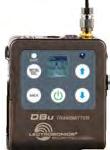
• Remove unnecessary devices and connections from your network to prevent overcrowding and
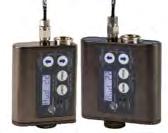

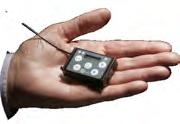
Transforming a church AV ministry into a production house
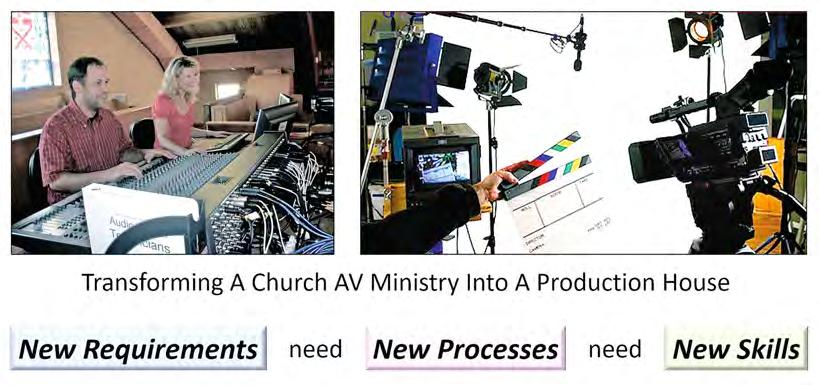

key element would be the AV crew running the streaming operations.
services demands techniques applied to broadcast or recording, which are actually very different from mixing for a live, in-person congregation. The video crew now has to manage
internet plan and service provider is able to cater for this before you embark on your next video streaming.
The fifth element (not the movie!) which I always considered as the
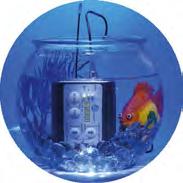
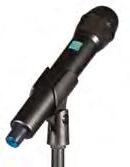
lighting, image displays, monitoring transmission quality – the list goes on – practically operating almost like a broadcast station. This is so unlike running live FOH duties and, in many ways, is much more complicated and demanding. Without the necessary guidance, training and skillset, a
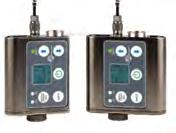

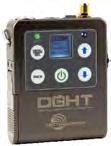
top-notch AVL system would at best be just an uncut diamond waiting for a craftsman to unveil its true potential. So, while it is important to have the right system setup, I can’t emphasise enough that it ultimately lies in the hands of the AV crew who have to do what is necessary to deliver God’s message and blessings to all online worshippers.
Again, this is a really huge topic to cover within a very short article but I hope it will still be helpful for you. There is much more that I would like to share, so do look out for my next article. Till then, take care and God Bless.
May–June 2023 WORSHIP AVL 7 Transmitters... ...for every purpose USA 1-800-821-1121 In Canada, call 877-753-2876 In Europe, call +33 (0) 78558 3735 In South America, call +57 310799 4564 ai165047642158_Transmitters for Every Purpose_half_horz_WorshipAVL copy.pdf 1 4/20/2022 11:40:29 AM
COMMENT
New requirements need need New processes New skills
Why and when do you need antenna distribution?
WE ALL KNOW THAT OUR receivers need two antenna sources for the diversity system in our wireless mics to help protect us from dropouts. So why is simply plugging a pair of antennas into each receiver such a problem if each antenna is providing us with signal?
To understand this, we need to consider just what signal we are feeding our receivers. And that signal is both the signal from our transmitter and from all the other interference that surrounds us everywhere. Our goal is to get a signal that is at least 20dB stronger than whatever the interference level is at our venue. No one is immune to that interference, whether you are in a city or a rural area. It is invisible and present everywhere on the planet. When a receiver sees a signal that is at least 20dB above the noise floor, it locks onto that signal and ignores everything else. Additional sources of interference include local TV stations and anything with a computer chip, anything with a motor, LED stage lighting and videowalls (displays) and cosmic junk from outer space. 5G cell phone service is also a new villain.
So, there are two ways we can get that 20dB signal-to-noise ratio: we can increase the power or we can decrease the noise floor. Raising the power would be easy; however, in the US the Federal Communications Commission limits our power to 50mW (without a licence) and raising the power causes an increase to the noise floor if you are using more than one wireless mic (or ears). Therefore,
each other and cause a rise in the noise floor.
When a radio signal crosses an antenna, it generates a current in the antenna that goes to the receiver and we have a radio. However, when the current flows through that antenna, it also causes a magnetic signal to be created in that antenna. Paddle and Whip antennas should be placed at least three wavelengths
the received signal and that will also leak into nearby antennas. Here’s where an antenna distro system comes to the rescue. Just plug your A and B antennas into the distro inputs and connect the distro’s outputs to your receivers. Generally speaking, antenna distros can be cascaded together to form larger systems when necessary. There is no limit as to how many receivers can be fed
in a multichannel system, raising the power would cause additional new problems. So, our target is to decrease the noise floor.
The easiest way to decrease the noise floor is to use fewer antennas. In a typical room (that could hold up to about 1,000 people), ideally you would want to only use two antennas (an A and a B) which means we need to be able to distribute the signals from that pair to all of our wireless mics. Multiple antennas interfere with
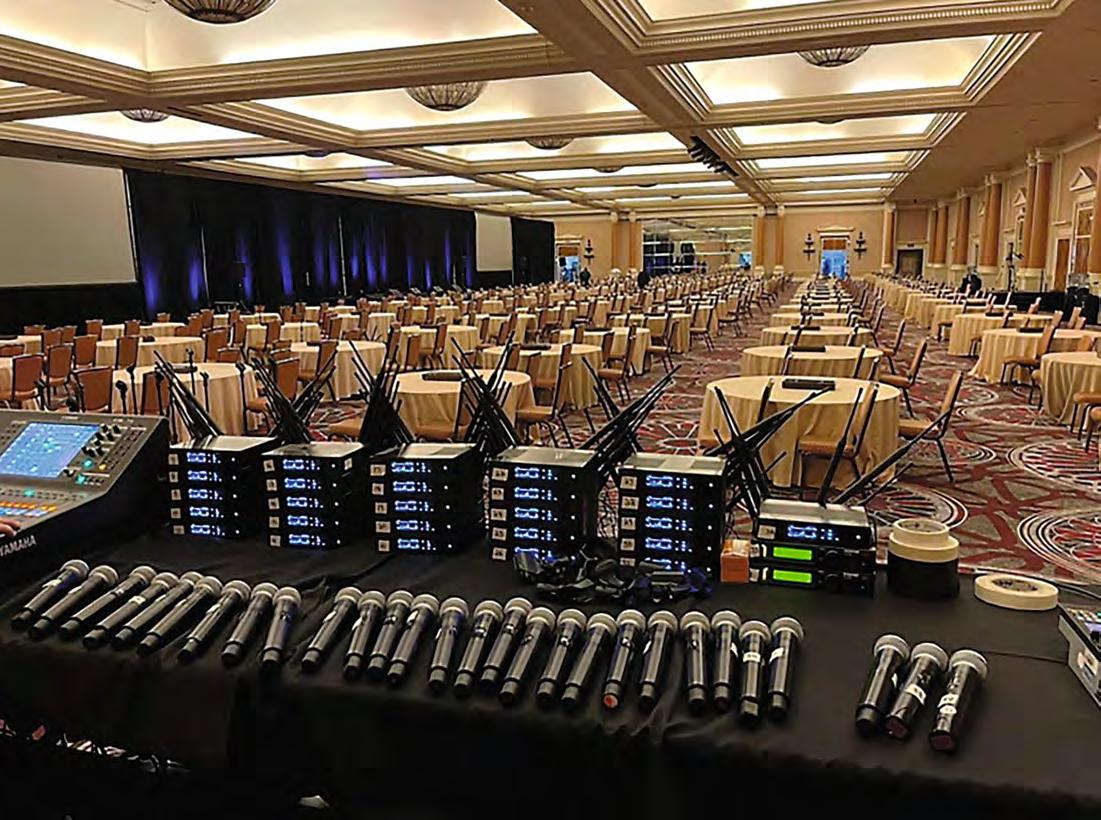
apart (about 1.8m). Otherwise, magnetism will leak into the surrounding antennas and cause a rise in the noise floor. Also, when conventional antennas are close together, they form arrays (much like when you stack speakers together to create a “line array”). Unfortunately, if not spaced apart at specific mathematical distances, they generally will create hot and cold spots across your stage. If all that wasn’t bad enough, your radio also re-broadcasts about 10% of
from a single pair of antennas. Most distro systems can also supply dc power to operate your receivers, eliminating the need for wall warts (which can also contribute to a rise in your noise floor).
And for an easy way to calculate if your system can have a 20dB dynamic range, take a look at our free system performance calculator at www.rfvenue.com/rfvenue-calculator.
www.rfvenue.com

8 WORSHIP AVL May–June 2023
COMMENT
RF Venue’s senior applications engineer, is at least 20dB stronger than the interference level at your venue
RF Venue’s DISTRO4
On your markdata - go!

Modular system for customized infrastructure solutions
Wide range of modules for fully networked media technology concepts



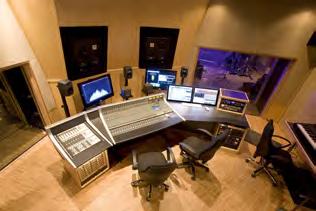
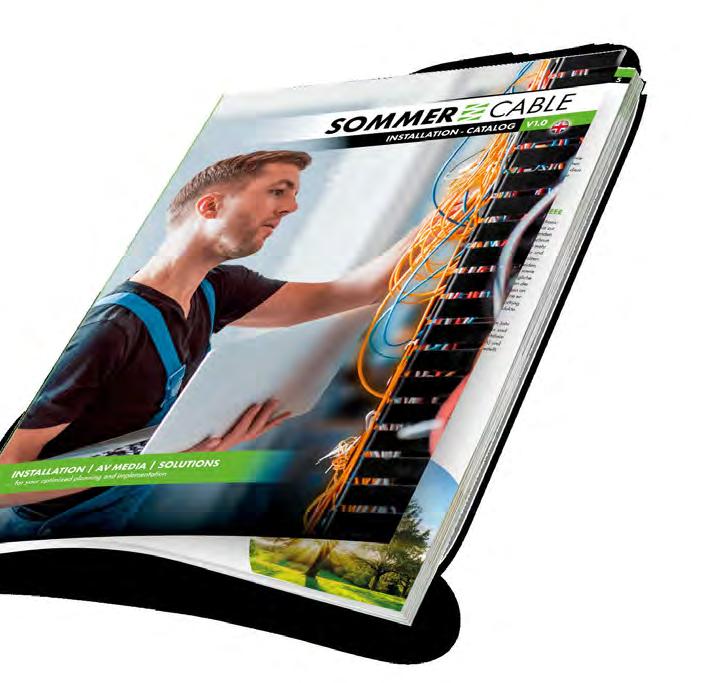

Classified cable-bulkware according to EU Construction Products regulation (EU CPR)





Ready made Network and Fiber Optic Systems for mobile and installation applications
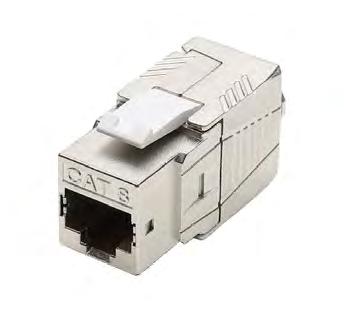
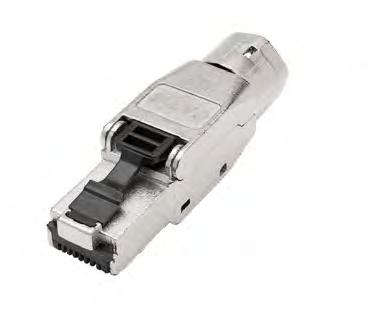
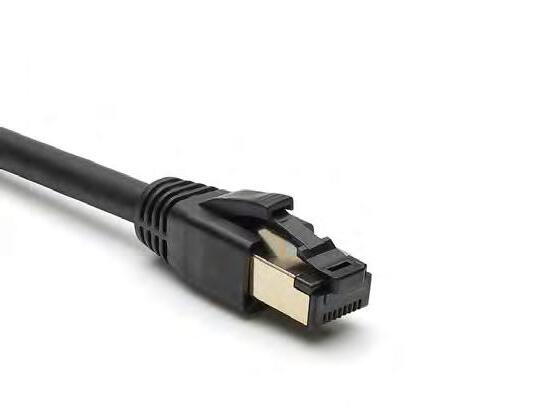
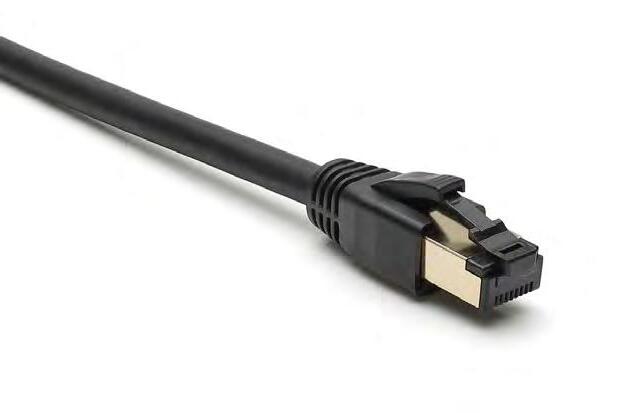
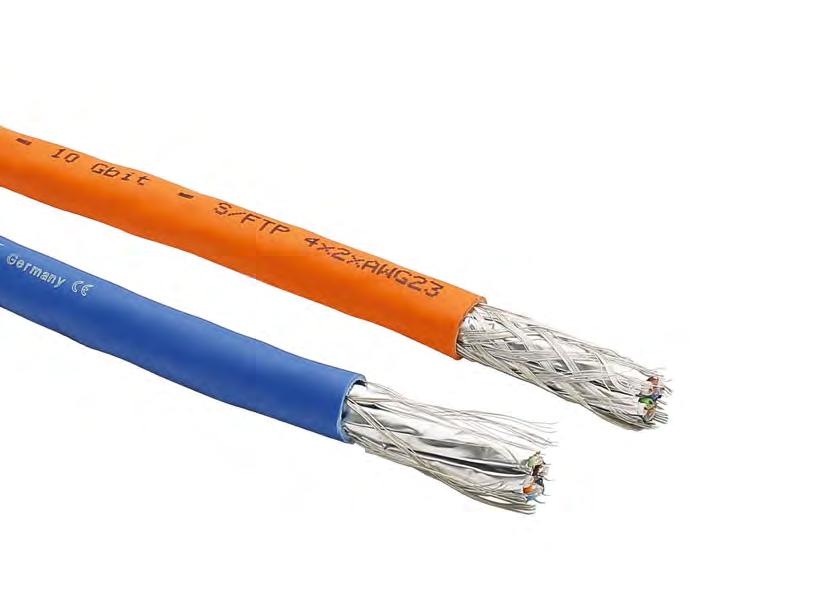
SOMMER CABLE based in Straubenhardt/Germany was founded in 1999 and is now one of the leading suppliers of professional high-quality cable and connection technology with a focus on the audio, video, broadcast, studio and media technology sectors. The product range including the in-house brands HICON, CARDINAL DVM and SYSBOXX covers cable bulkware, connectors, connection cables, individually adaptable distribution systems and electronics. A B2B shop with over 25,000 products is available 24/7.

25.04.
REQUEST INSTALLATION CATALOG FOR FREE ! NEW 2023 Installation & Conference Broadcast Solutions Professional Studio Event Technology x01735 High-quality,
components www.sommercable.com • info@sommercable.com
- 28.04.2023 Hall 12.1, Booth B32 Frankfurt a. M. / Germany
certified connection
CPR-rated CAT.7 & CAT.8 installation and connection cables
When dreams become reality
The 100,000-capacity Glory Dome at the Dunamis International Gospel Centre in Abuja has taken delivery of an extensive FBT speaker system
DUNAMIS INTERNATIONAL
Gospel Centre (DIGC), located in Abuja, Nigeria, was established in 1996 and is led by senior pastors Dr Paul and Dr Becky Enenche. Dunamis originates from the Greek word for power. The church’s first two Sunday services were held at the Abuja Center for Arts and Culture before quickly moving to the Abuja Sheraton Hotel & Towers for the next six months. In 1997, DIGC moved again into its own worship arena in Area 1, beside the Old Federal Secretariat; however, it soon became apparent that the building was too small to contain the crowd that gathered for each service. A location was found along the airport road and, on 14 September 2014, a ground-breaking ceremony for the new premises took place, presided by Bishop David Oyedepo. Finally, in 2018, the church moved into its current home – the 100,000-seat Glory Dome.

A few months ago, FBT distributor for Nigeria, Showgear, was tasked with
putting an end to the audio problems that the church had been experiencing since it moved into the new premises. The multiple line array stacks were not correctly time aligned and there were blind spots in the under-gallery seating areas. The PA system was also producing low SPL coverage and a poor frequency response.
The Showgear team selected an FBT demo system that was supposed to last for a week, although the integrator had to use Muse 210LA speakers as the MYRA 214L was unavailable at the time. The final setup consists of 12 MYRA 214L biamped three-way line array speakers with two MYRA F214 fly bars, two MYRACK touring racks, six ProMaxx 114 two-way 14-inch passive speakers, two Modus 4820LA active line array speakers for side-fill, six CLA 406.2 active column arrays for stage-fill by the altar with six Vertus VT-F 406.2 fly bars and three Vertus VT-J 406.2 joint bars, and 60 J8 passive speakers featuring an 8-inch
as the stage and FOH mix, with a DiGiCo S31 for the broadcast mix. The wireless microphone system consists of Shure SLX-D24D/B58, ULXD24/K8 and QLXD24/B87 models. Showgear also provided a PGADrumKit7, SM58s for talk back, SE215 over-the-ear earphones and a UA844+ antenna distribution system from Shure. Other equipment includes a Behringer P16 mixer, a Nord Stage 3 keyboard and a Roland Fantom 08 synthesiser keyboard. When the church experienced the quality of the temporary system, which had been designed to reduce turbulence and eliminate nonlinearity, it realised that it was the sound the church members had always dreamed of. The demo period
was then extended until the FBT speakers arrived to be permanently installed.
“We had positive feedback from the senior pastor and founder of Dunamis International Gospel Centre, Dr Paul Enenche,” says Victor Salu from Showgear. “He was very impressed with the sound. Having walked around the auditorium, testing the sound at every point, he confessed the sound was infinitely better than before.”
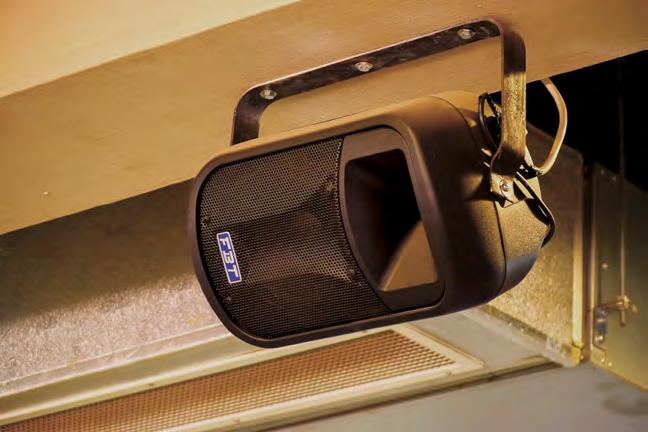
10 WORSHIP AVL May–June 2023
dunamisgospel.org www.showgearonline.com
PROJECTS
FBT J8 speakers have been fitted under the gallery and in the walkway
XS Wireless IEM
About time to level up
Make the move to personal monitoring with Sennheiser’s new XS WIRELESS IEM. Defining new standards for simple, flexible, and reliable wireless in-ear monitoring, this system is designed to help you level up your sound –regardless of your experience level. Whether a rehearsal or live performance, on a club stage or for a worship service, benefit from renowned Sennheiser sound and solid wireless reliability packaged into a convenient system – letting you focus on playing your best.
www.sennheiser.com/XSW-IEM
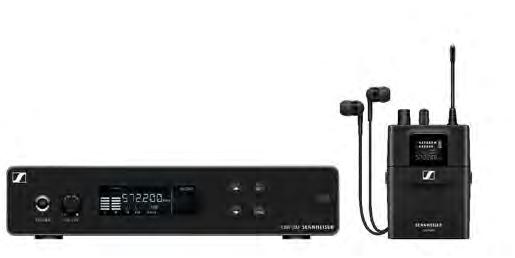

Bridging the gap
SAW has enhanced the worship experience at Bridge Church following a renovation at its Alberton sanctuary
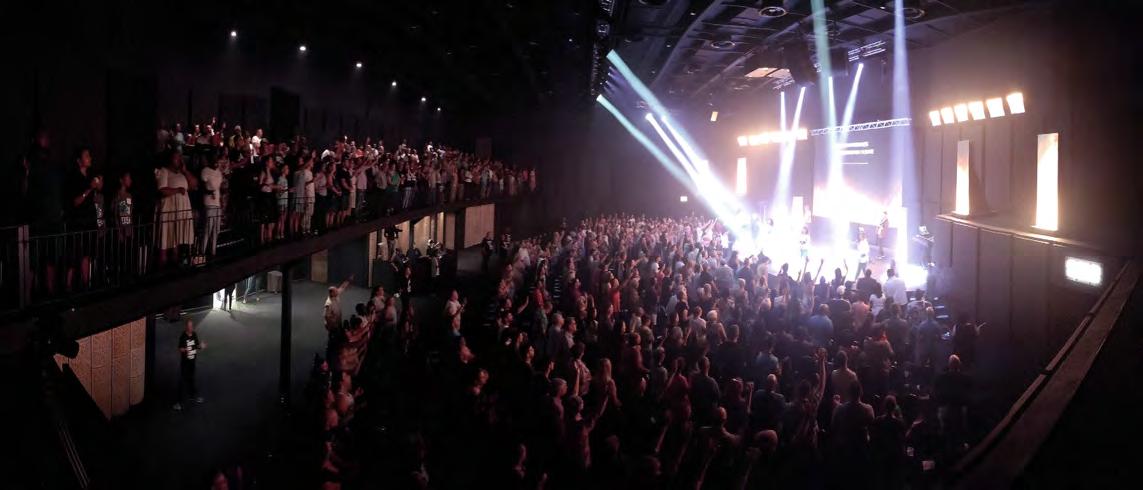
BRIDGE
CHURCH IN ALBERTON,
Johannesburg, is a contemporary church that strives to be a catalyst of positive social change within the local community. The congregation has grown considerably in recent years, causing the church to undergo a renovation, increasing its capacity from 400 to 900. As part of this renovation, Stage Audio Works (SAW) was brought in to design, supply and deliver a complete audio overhaul plus a turnkey house lighting solution with additions to the existing stage lighting, complete with flexible control for all of these systems.
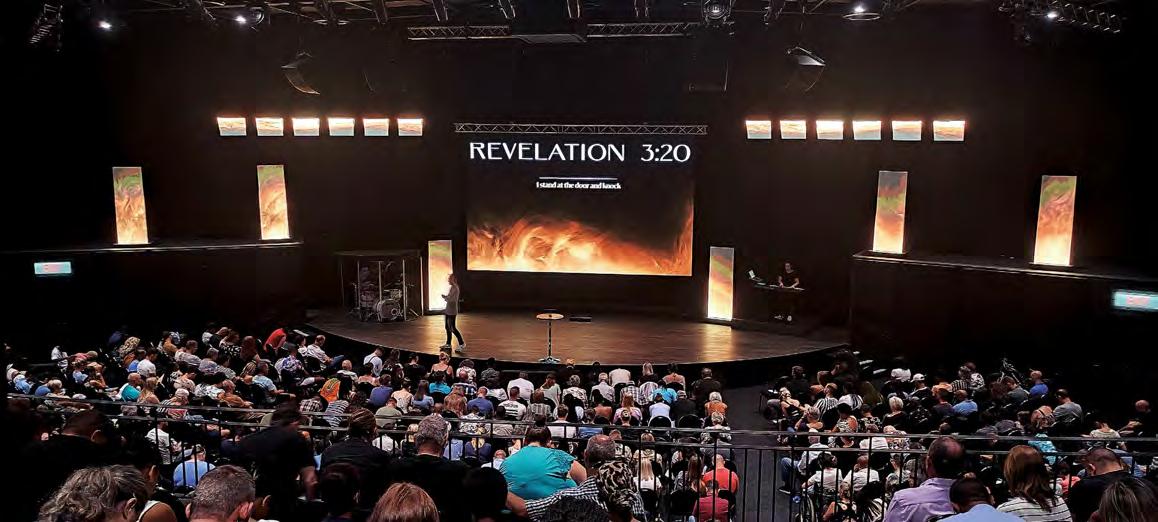
SAW was actually referred to the project by Lee Thomson, a SAW project sales manager who is also a member of the church. Having observed what he felt were successful deliveries of many similar solutions, he recommended the company, which has an extensive HOW project portfolio, to help take Bridge Church’s system to the next level.

“This project was especially important to me as it is one of the initial Plus Audio installations that we’ve carried out in the house of worship market. It’s great to see the technology being put to good use,” explains Thomson. “They get a new system providing the required headroom, coverage and even intelligible audio reproduction within a very reasonable budget. I can help my church operate and provide in situ training, and SAW can add another satisfied customer to the list – a win–win for everyone.”
SAW’s primary brief was to provide a significant upgrade to the church’s audio system. The integrator completely replaced the existing point source solution with a Plus Audio system to accommodate for a larger audience and bolstered front of house with a new Yamaha CL3 console with Rio stageboxes providing more inputs and outputs. The church also required an overall control solution for the house lighting, LED switching and air conditioning.
“After hearing the brief and inspecting the site, we specified a Plus Audio line array solution comprising eight PA14i boxes with a curvature of 15° and a further
four with a 30° dispersion. These were arranged in two L-R hangs and supported by four powerful sub-bass loudspeakers on the low end,” adds SAW CTO, Nathan Ihlenfeldt. “We went with a Plus Audio solution as it simply delivered the best performance for its price point. With this arrangement, we were able to engineer a system that provided the required coverage and SPL level, while maintaining a very high standard of fidelity.”
To help with the acoustic treatment of the church, SAW enlisted the assistance of Bruce Gessner, a reputable acoustician, who has worked with SAW on several occasions. He provided his
expertise for the duration of the project.

SAW also implemented a sophisticated control system, based around a Q-SYS Core. This system grants staff total control over the facilities in the building’s main areas: the auditorium, foyer, café, deck and the toilets.
Tackling the house lighting element, SAW integrated 36 Stage Plus RGBW LED lights with integrated convection cooling. The stage is covered by six Acme wash lights, fixed to a trussing solution provided by Total Fabrications. Both solutions are connected to and controlled by the Q-SYS network.
12 WORSHIP AVL May–June 2023
PROJECTS
used as a regular venue every in, so it’s definitely something


“We’re really happy with the upgrade. on board who understands the system.





ALTAIR WB-200 Series

PROJECTS
Turning 50, demonstrating vintage
GKY Pluit has turned to PT Kairos Multi Jaya to install an audio system into its new purpose-built premises
LIKE THE NORTH JAKARTA community it has grown up amongst, Gereja Kristus Yesus (GKY) Pluit has enjoyed a rich and fulfilling journey since preaching the Bible from a garage in its formative years. As the church steels itself for its half-century anniversary in 2024, it has welcomed increasing numbers of worshippers across all age groups through its distinctive arched entrance. Having endured challenging times including the 2013 flooding of its sanctuary, the consecration of its new purposebuilt premises opposite its 1984 property heralds a new dawn. With age, comes wisdom.
Having consistently turned to PT Kairos Multi Jaya for fulfilling its pro audio requirements, Pluit’s ministers had no hesitation in awarding the renowned Jakartabased distributor to design, supply
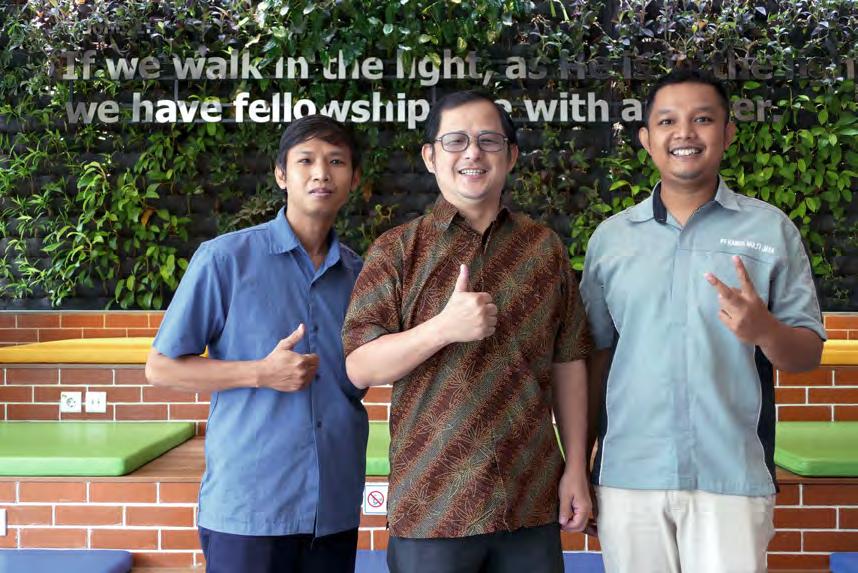
Before the works could commence in the new building, however, the PT Kairos Multi Jaya engineers were commissioned to upgrade the ageing audio components in the older church building.
Sunday services are conducted from both buildings on the Jalan Pluit Permai Dalam. “We practise a more classical and less contemporary style of Christian service,” confirms GI Tommy Chendana. “A grand piano is our main instrument, but we sometimes add a choir and some strings. Owing to the lack of acoustical treatment in the old sanctuary, and because of the room shape, the audio levels do not need to be output to high levels.”
The stage of the older church is adorned with a central podium with a fixed Shure Microflex 18-inch
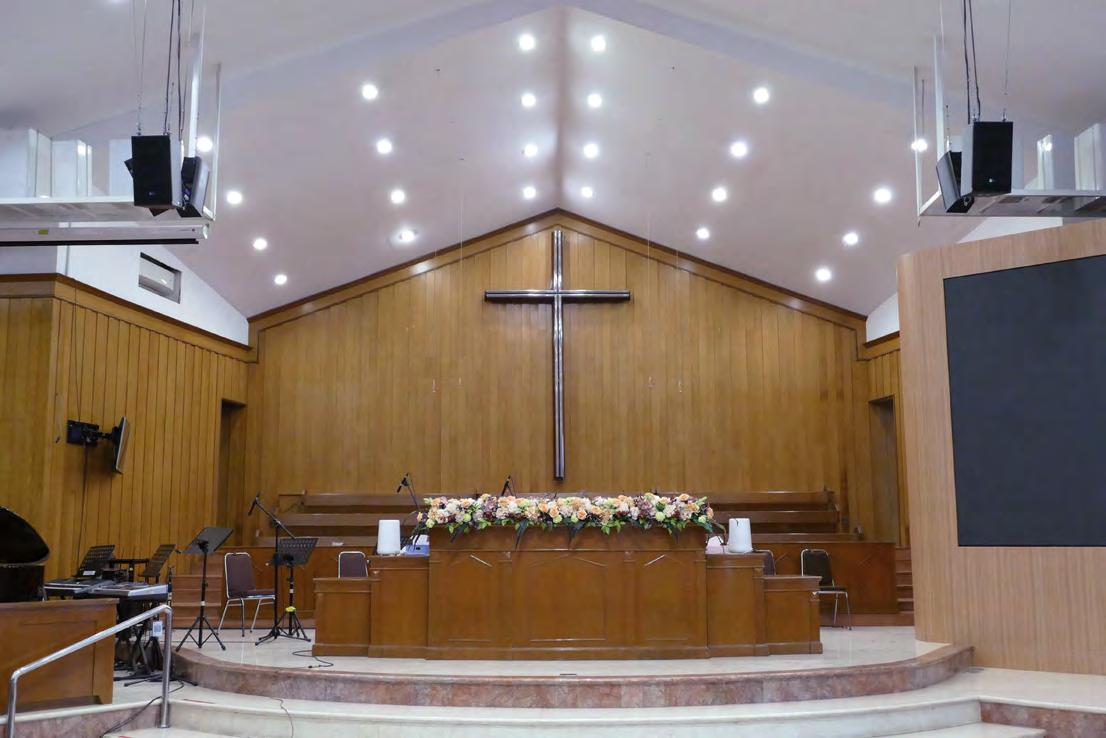
14 WORSHIP AVL May–June 2023
PROJECTS
The older 1984 sanctuary is now reinforced with a Meyer Sound Ultra-X point source series loudspeaker system
L–R: GKY Pluit technical operator Varid and GI Tommy Chendara are joined by PT Kairos Multi Jaya engineer Harry
(WxL) room. To the pastor’s right, a grand piano is played during recitals and a fixed LED screen to his left provides visuals streamed from a PC, prayers and hymn lyrics. Located on the wooden pulpit, two Genelec 8030 monitors assist the pastor during the service. The point source design was specified for its high power and speech intelligibility capabilities. As such, the upgrade comprises Meyer Sound Ultra-X42 cabinets as the main L-R loudspeakers. Delivering a smooth response across its entire range and directional control across the entire vocal range down
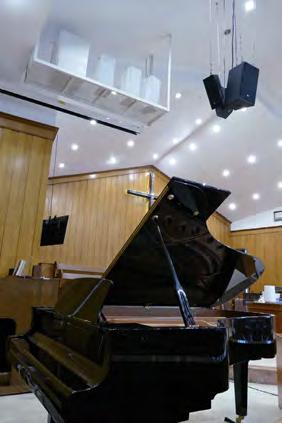

Mosque Sound made clear. Pray with faith.


2-Way Weatherproof Loudspeaker TZ-200 / TZ-400



to 400Hz, the compact, concentricdriver configuration combines two 8-inch drivers with a rotatable 70° x 50° waveguide surrounding a 3-inch high-frequency compression driver. Further equipped with a three-channel Class-D amplifier, the self-powered design incorporates Intelligent AC for auto-selecting correct operating voltage, suppresses high-voltage transients and provides soft-start power-up. Both cabinets are suspended from four of the 11 available integral M8 points.
Reinforcing the dual Ultra-X42 cabinets, four Ultra-X20 dual 5-inch models have been ceiling

suspended further along the sanctuary as delays and fills for the rear and balcony seats. Serving as monitors, two additional X20 models have been fixed into position behind the X42 speakers should the choir be assembled at the rear of the stage behind the pastor. Mixing is performed on an Allen & Heath Qu-32 digital console located on the balcony.

These elegant 2-way column speakers provide highly intelligible sound, especially for speech but also for music because of their design which also incorporates a tweeter. Their strikingly slim design not only integrates into any interior aesthetically but can also be used outdoors as they are IP66-protected in a weatherproof housing and provide clear announcements over longer distances. With their wide horizontal and narrow vertical dispersion patterns, the speakers can also be installed in acoustically difficult environments.
L-R Ultra-X42 models provide the main reinforcement in the older 1984 sanctuary and X20 models provide choir and piano monitoring
We supply sound, not equipment.
PROJECTS
www.toa.eu | TOAEurope | TOA Electronics Europe
Suspended from the ceiling, Meyer Sound Ultra-X20 cabinets serve as delay and fill models in the older sanctuary
The view of the older sanctuary from the Allen & Heath Qu-32 mix position
May–June 2023 WORSHIP AVL 15
PROJECTS
Located on the third level of the newly constructed Gedung Antiokhia building, a 332-seat sanctuary practises a blended worship service on a Sunday. “The services are more musical in nature in the modern sanctuary,” confirms GI Chendana.
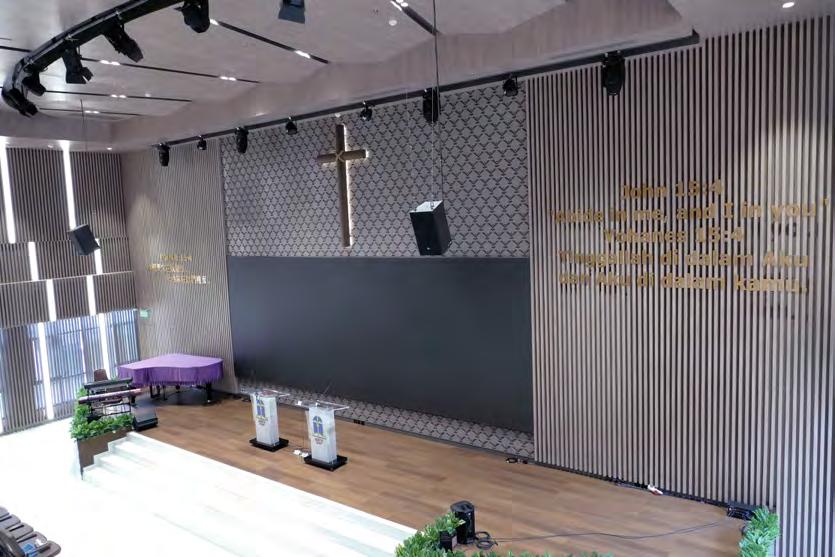
“As such, Mr Kianto [architect] opted for acoustic treatment, including absorbers and diffusers. For the new loudspeaker system, we stipulated a compact, discreet system that would combine high intelligibility with power.” Listening demonstrations from several suppliers followed, with Meyer Sound receiving the highest score.
Maintaining consistency with the older sanctuary, the Meyer Sound system promotes speech intelligibility for live musical performances, with Ultra-X40 cabinets providing the main reinforcement. “In terms of clarity and detail, the Ultra-X speakers demonstrate hi-fi definition and so we wanted to replicate this sound
in the new church.” Like the delays in the older sanctuary, the left and right balcony seating areas in the new church are served by dedicated Ultra-X20 models.
The left-right rear seats on the balcony benefit from HD displays together with discretely installed UP-4slim models fixed horizontally on the low-level ceiling. Measuring 404mm x 109mm (WxH), the front fills are also served by a further pair of UP-4slim dual 4-inch enclosures. Installed out of view under the 1m-high stage, dual Meyer Sound 750-LFC low-frequency control elements extend the bass down to 37dB (–4dB). Like the Ultra-X point source speakers, the 519mmhigh, 15-inch subwoofers integrate Class-D amplification. KLOTZ AIS MC 5000 loudspeaker cabling has been exclusively used to connect the digital mixing outputs and the loudspeakers.
The Meyer Sound components were configured and optimised using MAPP 3D system design and prediction software. The settings are stored within an XTA DP448 loudspeaker management system, with system performance managed in real time from a PC. The DP448 receives AES signal inputs from an Allen & Heath SQ-5 digital console located in the balcony production area. The SQ-5 also outputs digital signals to dual AB168 16-in/eight-out portable AudioRacks and a TP Link 16-port switch over a Cat6 cabling network. The DP448 is stored with all the required audio presets. Onstage, musicians and performers can monitor themselves from RCF ART 708-A 8-inch selfpowered speakers in addition to Allen & Heath ME-500 personal
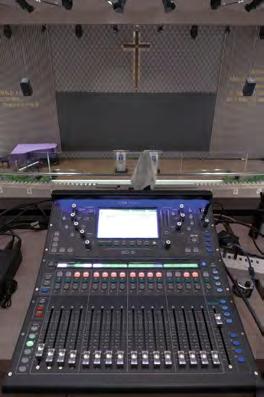
mixers that can receive up to 16 mono or stereo sources from the SQ-5. Microphone inputs are exclusive to Shure. The pulpit is equipped with a pair of MCX918 goosenecks, and the pastor and religious leaders utilise head-worn, lavalier or handheld transmitters paired to three channels of QLX-D wireless receivers.

A simple yet effective lighting design combines six Chauvet DJ Intimidator Hybrid 140SR moving head beams with four Sorot Pro 300W LED Fresnel spots and four Sorot Pro LED PARs fixed to two lighting bars. Mixing is conducted from the control surface of a compact LightShark LS-1 console adjacent to the SQ-5 audio interface in the balcony production area. Featuring four encoders, 10 master playbacks and a built-in display, the LS-1 is equipped with a complete set of RGB buttons. Integrated into the rear wall stage, a 5m x 2.5m (WxH) LED screen receives HD inputs from a laptop and a portable Sony 4K XD camera connected to a Hollyland transmitter.
There is a welcoming ambiance for worshippers entering the downstairs foyer and café area of Gedung Antiokhia. Here, the PT Kairos Multi Jaya engineers installed an EAW ceiling speaker solution that combines six CXT600 6.5-inch coaxial models with two CXT800S 8-inch subs for lowfrequency extension down to 80Hz (±3dB). A Powersoft Mezzo 322 A amplifier supplies the power to the eight-speaker network and digital processing is provided by a Symetrix Solus NX 4 processor. The provision of Shure ULX-D wireless units ensures announcements and speeches can be made.
Like any modern church design, the AV and lighting systems that have been integrated into the new architecture are networked, easy to use and futureproofed. “It’s virtually plug-and-play for our volunteers,” insists GI Chendana. Unlike church pews of yesteryear, the 332 seats have been built for comfort. For those worshippers in the rear seats, a Sunday snooze may have been tempting in previous times, but given the audio, video and lighting credentials that GKY Pluit commissioned, the congregants will most likely depart somewhat entertained and wiser after their instruction. www.kairosmultijaya.com
16 WORSHIP AVL May–June 2023
An Allen & Heath SQ-5 digital console in the balcony production area of the new sanctuary
The new sanctuary’s main audio system consists of L-R Meyer Sound Ultra-X40 and X20 speakers
The lighting fixtures are controlled from a LightShark LS-1 surface
Two of a kind For your
When a complex live stage needs to sound its best, you need mics that seamlessly combine to capture the true sound.

2012 Cardioid Mic excellent close-miking results on any instrument
2015 Wide Cardioid Mic amazing overhead ambient pick up of instruments
microphones.com/live
dpa
one-of-a-kind sound
Move to immersive
FBCW adds DMI-KLANG to create an immersive worship environment in its 7,500-seat sanctuary
came about as part of the same conversation that saw the immersive audio move with the PA. “With so many unique audio sources, the need to expand the soundfield to hear more distinction between the different voices and instruments is critically important. It was also equally important to maintain the high audio fidelity that the musicians have got used to having. With the native integration of KLANG into their DiGiCo workflow, the changeover was simple and immediately effective.”
“Basically, monitoring for the choir is like a FOH mix, with active changes as the music dictates, tailored for the choir’s needs. The monitors themselves are a line array system hung above the loft for the 150+ singers each Sunday.”
FIRST BAPTIST CHURCH
Woodstock (FBCW) is no stranger to major undertakings. Spanning three centuries, the church’s current 16,000-member congregation worships in a 7,500-seat worship centre in its 40,400m2 building on an 80-acre campus in the North Georgia town of Woodstock twice each Sunday. Last year, FBCW became the site of the world’s largest permanent installation of L-ISA immersive sound technology, which is paired with DiGiCo Quantum338 consoles at front of house and monitors. Now, the church has embraced immersive mixing with its addition of a DMI-KLANG module, supplied
by the church’s integration partner, Diversified.
FBCW’s monitoring landscape is certainly an ambitious one. Every Sunday, there are two completely distinct worship experiences. The first, starting at 9.30am, is choir-driven with a sizeable, individually mic’ed front line backed by a full band and orchestra. After the conclusion of that service, a second 11.00am service begins that is band-driven with a completely different set of songs, musicians and vocalists.
Nick Geiger, account executive, Worship Environments at Diversified, believes the move into immersive sound for FBCW’s stage monitoring
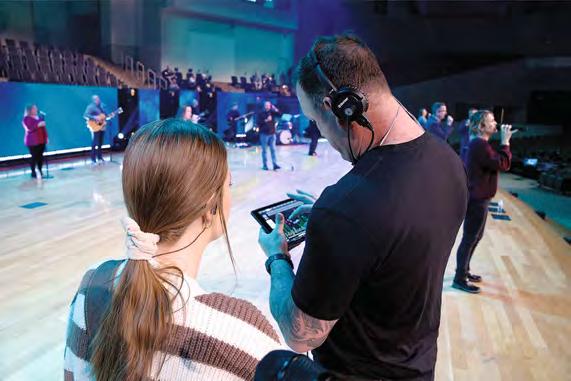
According to Geiger, KLANG also brought a practical solution to FBCW’s unique stage monitoring needs. “With the limited time each week to flip the stage, moving 16 of the monitor mixes to KLANG, where those musicians can adjust their own ears without the assistance of a monitor engineer, freed up time for the monitor engineer to focus on the mixes that are sourced from the monitor console. The overall efficiency of getting the stage monitors dialled in has increased tremendously with this change.”

“The church’s monitoring needs are on a scale I haven’t encountered anywhere else,” says Joel Hilsden, FBCW’s technical director and the church’s regular monitor engineer. Hilsden is one of three full-time audio professionals on staff there.
Each of the two worship services requires up to 20 unique IEM mixes. That’s up to 40 distinct mixes handled by a single engineer each Sunday. Beyond that, the vocalists and band are on a rotating schedule, rarely appearing on backto-back Sundays in either service. The audio team has been utilising every tool available to provide the kind of consistency that one might expect from a fixed cast or touring band.
“With limited rehearsal time, preparing the monitor console for rehearsals and services is its own challenge,” adds Hilsden. “There simply isn’t time to build every mix on the fly from a generic start file. We have always relied heavily on the console’s mix presets to be sure we’re beginning each rehearsal with a familiar personalised starting point for every IEM mix onstage. With our 11.00am band rehearsing mid-week, it’s mission critical that the console recalls everything precisely across all inputs and outputs during our 15-minute set change.”
18 WORSHIP AVL May–June 2023
PROJECTS
L–R: FBCW technical director Joel Hilsden, lead production director Josh Belokonky and audio associate Nick McClure
Stage manager Lantz Cleveland helps a vocalist dial in her IEM mix on an iPad running KLANG:app
Hilsden describes the introduction of the DMI-KLANG into the church’s weekly routine as “completely seamless. We thought we’d be adding complexity to our workflow, but since the console is able to store and recall KLANG settings in its mix presets and snapshot system, it functions like part of the console, not an added piece of outboard gear.”
The backline musicians each use an iPad running KLANG:app. For vocalists, the stage manager has a wireless pack assigned to KLANG’s cue output. He walks the stage during rehearsals with the iPad in show mode with cue-link enabled, assisting the 12 vocalists one by one with their IEM mix. “We trust our musicians and stage manager to be able to handle mix changes independently of the engineer, and KLANG gives them full control to do just that. If anyone is struggling, the engineer can quickly step in to help. It’s remarkably efficient,” furthers Hilsden. “The band talkback microphones, previously dominated by mix change requests, are now just a way for the band to talk to each other about music, rather than mix requests to the engineer.”
“Prior to having KLANG in our setup, we had to pause rehearsals for several minutes at a time to request mix changes,” continues Cliff Duren,
FBCW’s worship pastor. “Now we’re able to give our full attention to music. The band has full control and the vocal team has access to our stage manager to discretely and quickly get their mixes right without pulling focus or interrupting the flow of rehearsal.” FBCW’s DMI-KLANG is installed in one of the Quantum338’s two DMI slots, connected to an Apple desktop running KLANG software, which is securely hard-wired to the console for Console-Link, connecting to multiple iPads onstage over Wi-Fi.
Jake Holman, lead director of music for the 11.00am service, reports:
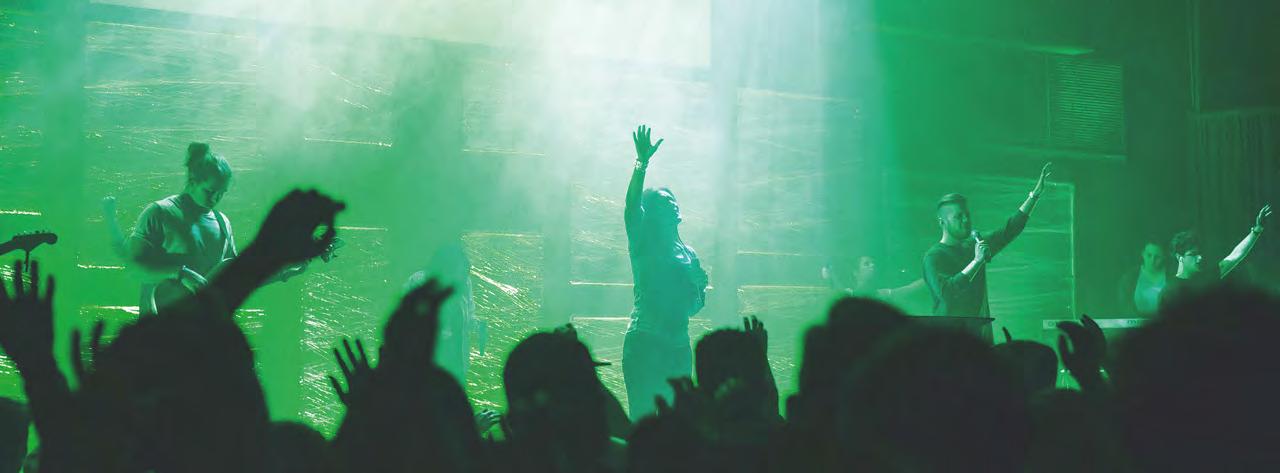
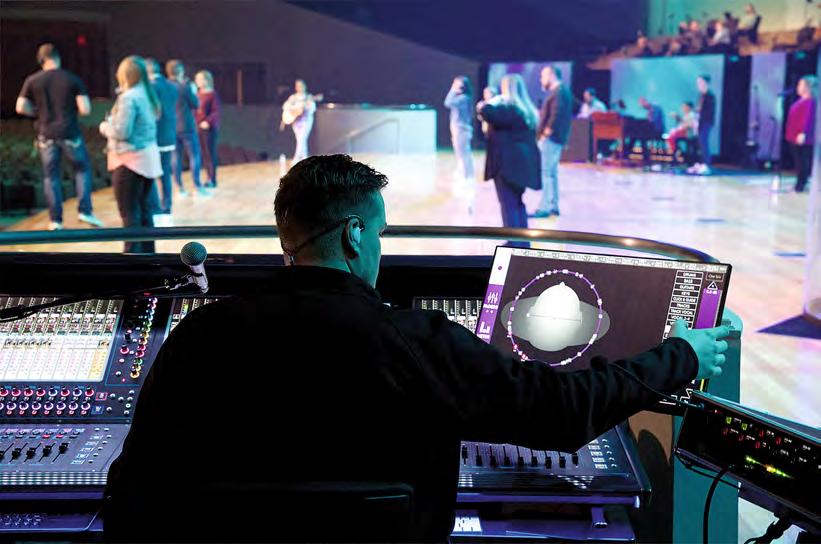
“The KLANG system required virtually zero training for the band because its operation is so intuitive. And everyone has taken to the binaural immersive aspect of it. In fact, we’ve tried giving vocalists the option of setting their own voice centred in the stereo space, where you might assume a singer would prefer to hear themselves, but the overwhelming response has been that it sounds more natural in the binaural 3D space centred in front.”
“Overall, what KLANG has done for everyone onstage is to make our rehearsals more efficient while also delivering a clearer, richer, more personalised monitor mix for our band and vocalists,” Hilsden concludes. “There’s a clarity to the sound that can’t be achieved with traditional leftright panning. It really has changed everything for the better. There’s nothing else like it on the market.”
www.klang.com
www.onediversified.com
New! Alta 4K Presentation Switchers
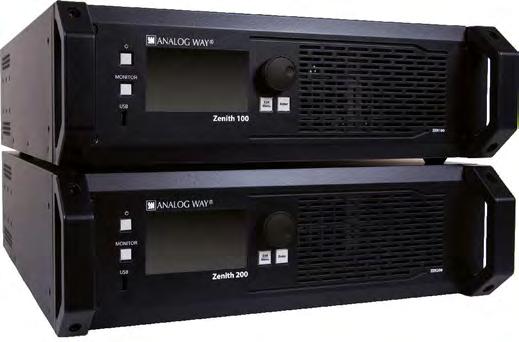
PROJECTS unmatched ease of use ® advanced audio processing ® livestreaming capabilities Captivate your congregation with powerful presentation experiences using Analog Way’s new high-performance multi-screen and multi-layer 4K60 presentation switchers. www.analogway.com info@analogway.com
Designed for houses of worship requiring the highest reliability and performance Image: Pexel.com/Georges-webster
Monitor engineer Bradley Hasty mixing on the church’s KLANG-equipped monitor console
Vacant lots filled with high-impact AV
ICI has converted an upper-level car park in northeastern Jakarta into a modern and vibrant church

INCEPTED IN 2007, THE YAYASAN

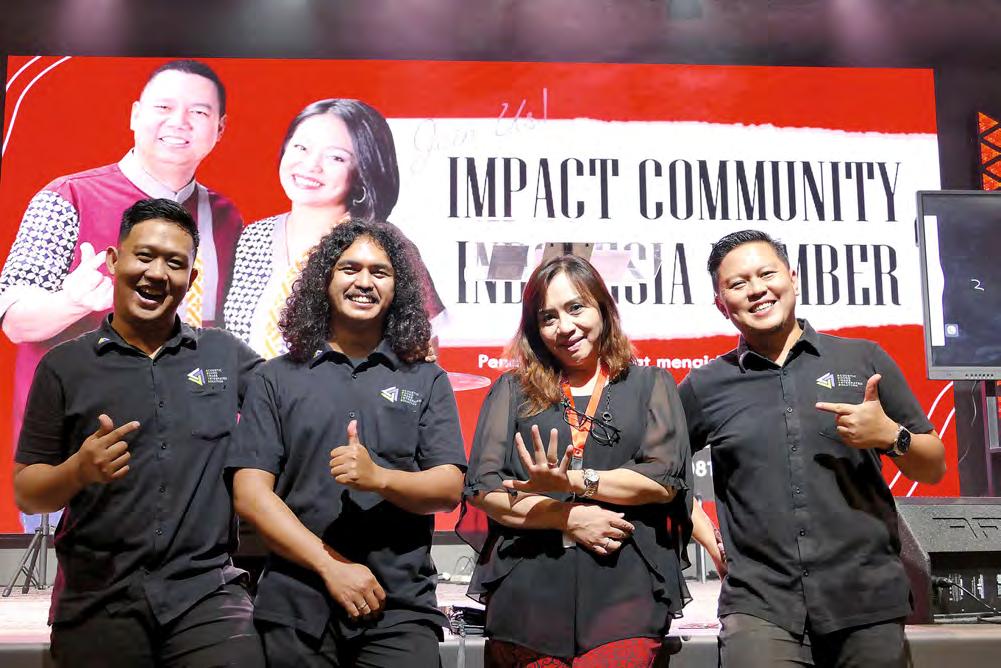
Tangan Pengharapan foundation provides education, medical care and food for thousands of poor Indonesian children from Sumatra to Papua. Brought to life by Yoanes and Henny Kristianus, the not-for-profit organisation was born from the married couple’s desire to build and change future generations of Indonesians for the better. Their subsequent creation of
that provides ICI with a real-world presence,” explains Ms Wemmy. “Both Pastor Yoanes and Henny Kristianus have committed their lives to providing a better life and education for over 6,000 children in over 85 locations in remote areas of our islands. Their online sermons teach ways of living according to the truth of God’s word and these proved to be very popular during the pandemic. They have acquired something of a celebrity status among their 1 million YouTube subscribers. Despite their rising popularity, however, the Kristianuses remain grounded and humble.” With the acquisition of a large section of an upper-level car park in northeastern Jakarta, ICI set about converting the space into a house of worship. “Having had our planning application approved in March 2022, ICI set a target of opening just four months later in July,” continues Ms Wemmy. “However, there were bad leaks in the roofing which took four months to fix, so we were behind schedule. I was called in at that point to coordinate the many professional contractors coming onsite from May 2022.”
20 WORSHIP AVL May–June 2023
PROJECTS
Tommy Hartono, Ebenhaezer Christo and Andy Mulya Sutikno from ASIIS are reunited with ICI’s Irene Wemmy (second from right)
FOH, monitoring and broadcast mixing are handled by a Waves 64-channel eMotion LV1 mixer
Use Freely and Cleverly
ACT-5800 Series Digital Wireless Systems
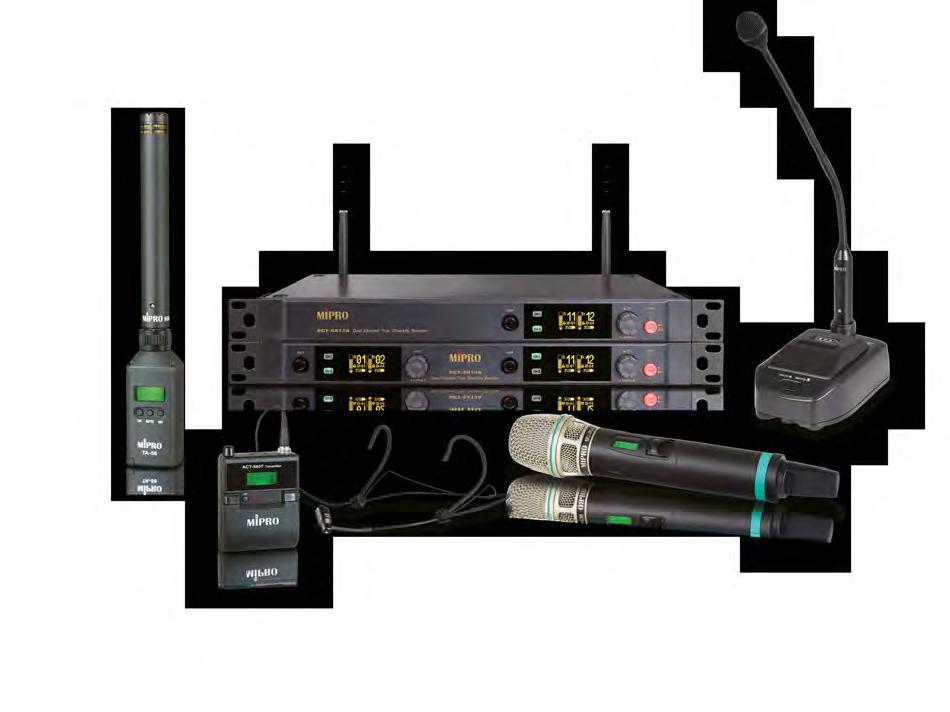



MIPRO ACT-5800 Series digital wireless systems operate in ISM 5.8 GHz license-free band so they can be used freely in any country. No ma�er presenta�ons, conferences, lectures, choirs or ensembles, ACT-5800 Series can fulfill your cable-free sound pick-up or recording requirements by offering various kinds of transmi�ers and microphones.

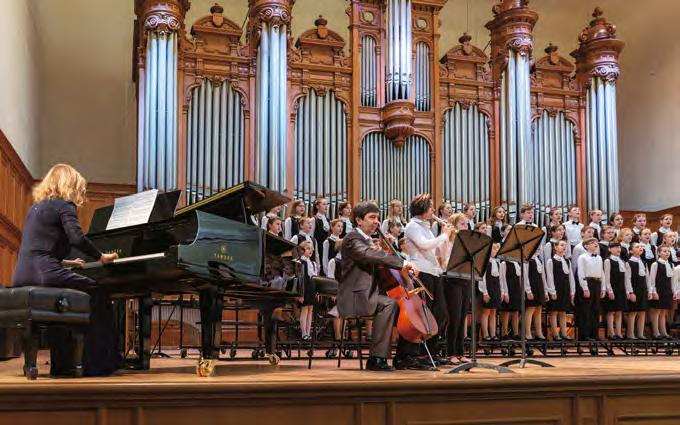


www.mipro.com.tw








100% Mad e i n Taiwan

Both full-time minister and Hillsong Bible College graduate Pastor Yoanes and his wife Henny fully appreciate the significance of a highly musical and charismatic service. “To better target their worshippers, the audio, video and lighting needs to be designed for a younger generation,” adds Ms Wemmy. “Millennial talents appear to gravitate to ICI as they appreciate the modern setup and feel more at home here. ICI wants to project a happening place with an open-door policy and a joyful ambience where everyone feels welcome and included. The AV and lighting system we desired needed to extend to that ambience.”
Their appreciation of the AV and lighting technology was heightened upon a visit to City Light Community Church (CLCC) in Bandung. Acoustic Sound Image Integrated Solution (ASIIS) has carved out a strong niche among Indonesian houses of worship over the past 15 years and this impressive reference in Bandung led to Pastor Yoanes and Henny requesting a meeting with ASIIS managing director Andy Mulya Sutikno in April 2022. Suitably impressed, Pastor Yoanes followed up the meeting with a visit to the ASIIS showroom in Jakarta.
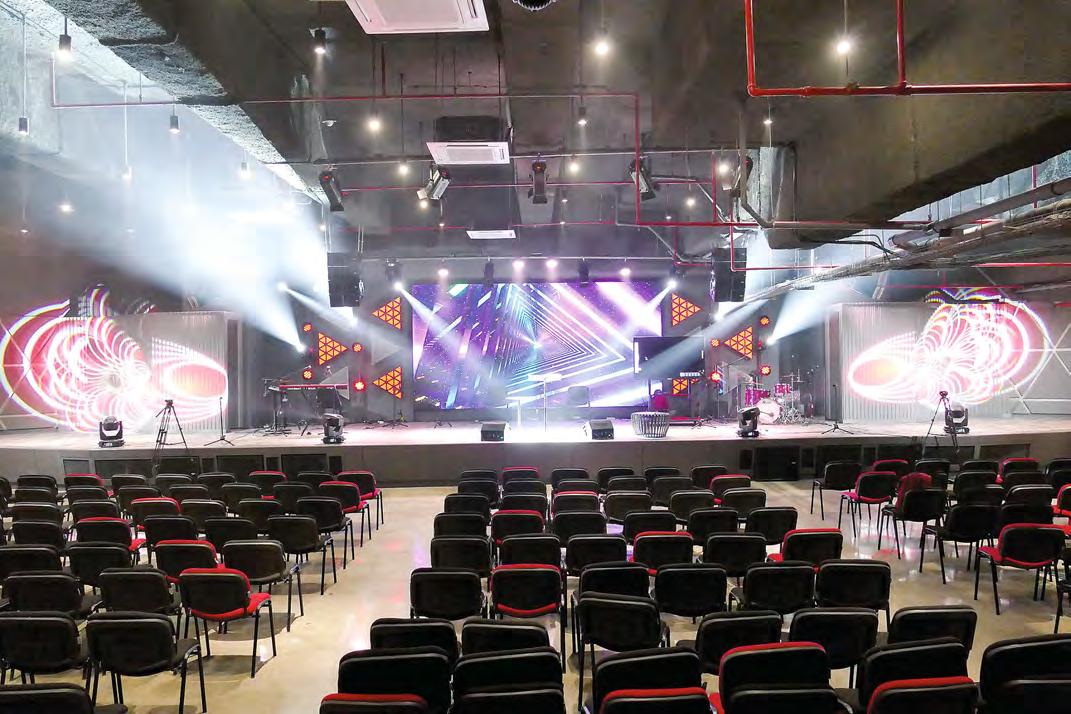
“We demonstrated an Audiofocus loudspeaker system together with a Waves eMotion LV1 64-channel mixer to Pastor Yoanes,” comments Sutikno. “I’m a big admirer of his work and was most impressed by his open-mindedness and artistic talents.” The demo made the sale and the Kristianuses appointed ASIIS to design, supply and install the audio, video and lighting components into their real-world ICI church. No longer resembling a vacant car park, the asymmetrical layout of the church sanctuary is unique.
shallow asymmetrical shape of the venue, I initially modelled an L-C-R configuration of Audiofocus Ares 8i loudspeakers. EASE software simulations confirmed an even left-centre pattern but highlighted a breakup towards the right. A simulation incorporating four arrays each consisting of four Ares 8i enclosures yielded almost perfect results, however.”
Suspended from the low ceiling, the dual 8-inch cabinets disperse a horizontal throw of 110° towards the lateral walls across the sanctuary’s wide listening plane rather than the rear of the venue. “To acquire this coverage, the lower speakers of the outer arrays have been splayed at a wider angle,” adds Sutikno. Providing low-end reinforcement and operating in
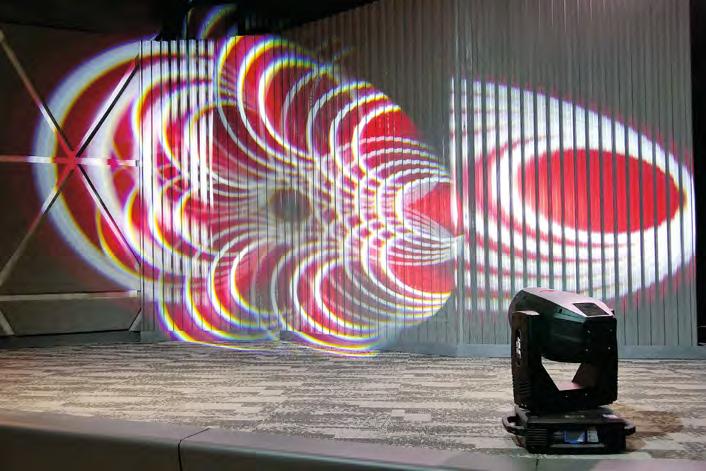
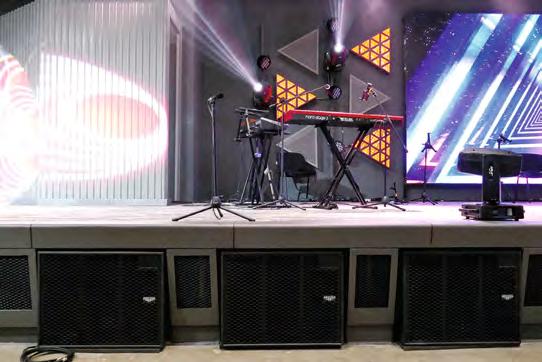
maximum SPL output of 139dB, ICI stated a preference for deep rather than punchy subwoofers and these single 21-inch subs do just that by extending the kick drum and bass down to 28Hz (–6dB).”
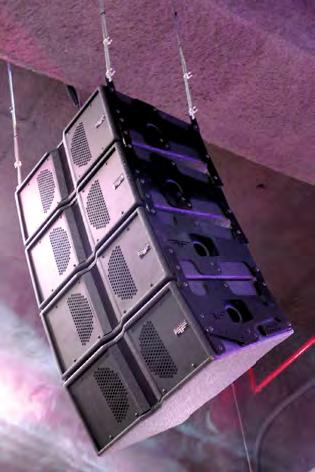
Onstage, the worship leaders can utilise four channels of Shure ULX-D wireless receivers with Beta 58 handheld or headworn transmitters. Sermons and speeches are monitored by low-profile Audiofocus CM 12a self-powered 12-inch coaxial wedges, while the singers and musicians use earphones connected to a Shure PSM 1000 personal monitoring system. The entire loudspeaker system is powered by a total of six Class-D CVR DSP 1504 and 2004 four-channel amplifiers.
Front of house, monitoring and broadcast mixing is conducted on a Waves 64-channel eMotion LV1 mixer equipped with compressors, gates, expanders, limiters and other DSP functionality. Added plugin processing comes from a Waves SuperRack
consisting of an Axis One host and Extreme-C server networked via the SoundGrid Ethernet protocol. Hosted on a computer, the MultiRack plugin software supports both Native and SoundGrid processing. “The Waves setup adds more colour, scenes, saturation and harmonics to the mix,” explains Sutikno. “In addition, its footprint in the production area is very compact and small.”
Prior to installing the equipment, ASIIS ran all the cables and conduits including the Cat6 infrastructure. The Waves eMotion LV64 64-channel mixer and SuperRack receive their microphones inputs from two Waves StageGrid 4000 32-in/16-out stageboxes via this Cat6 connection. The broadcast feed is routed to a smaller-scale StageGrid 1000 eight-in/ four-out stagebox. “For broadcasting transmissions via YouTube, we installed the Waves Extreme-C SoundGrid server and a Cisco switch. In addition to a MADI connection, a Dante card can
PROJECTS
22 WORSHIP AVL May–June 2023
Located below the stage, the six S 21i’s offer huge space and weight savings compared to dual 18-inch subs
Four hangs each consisting of four Audiofocus Ares 8i speakers provide even coverage across the sanctuary
The PLS lighting system provides a high impact at ICI
be inserted in future for enhanced management and control across the IP network.”
The LED wall at the rear of the stage draws the initial attention of the entering congregant with its powerful visuals. Consisting of 102 individual P2.5mm panels, the left, centre and
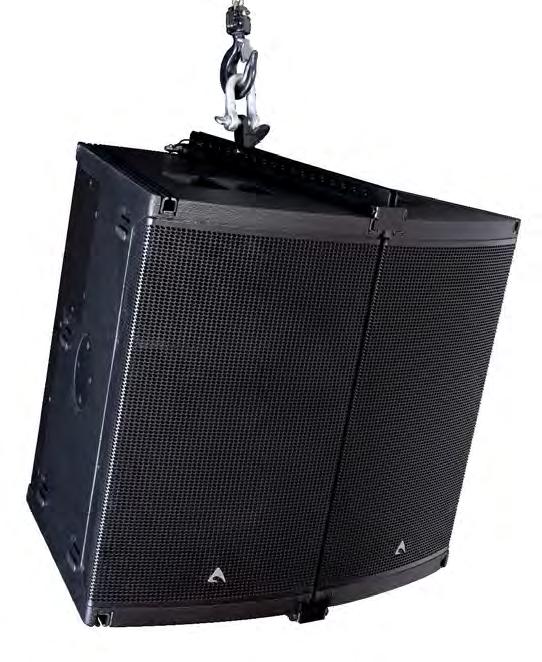
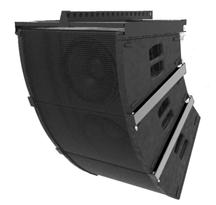
right displays measure 3.84m x 1.92m, 5.76m x 2.88m and 3.84m x 1.92m respectively. Providing a straightforward installation, the individual 640mm x 480mm aluminium die-cast cabinets were selected from the DLW Contractor Series. The various HDMI and SDI inputs are fed through a Colorlight X12 processor before being output to the LED wall and smaller HD displays throughout the building.
Like the audio and the visuals, the lighting was designed to create a high impact. A combination of 12 PLS BSW 350 moving heads, 13 PLS Fresnel LEDs, 18 PLS LED PARs and two Chauvet Datastreams are controlled from a PC touchscreen connected to a ChamSys MagicQ Stadium Connect programming wing. “Ease-of-use is always an important factor for houses of worship,” explains Sutikno. “By loading scenes, cues and presets, the lighting console is very intuitive. The volunteers can create powerful dynamic services in an efficient manner thanks to the timeline built into the console.”
The entrance foyer includes a reception area and café. Wall-mounted Quest HPi110 full-range loudspeakers provide BGM in this zone, including a broadcast feed from the main sanctuary during Sunday services. The adjacent children’s room is equipped
with a Behringer Wing console, a Midas DL32 console and Quest HPi loudspeakers and subwoofers powered by DSP1004 digital amplifiers.
A Blackmagic Design ATEM Mini switcher is central to the video operations and the singers and speakers on the smaller stage are

furnished with RØDE M5 cardioid condenser microphones.
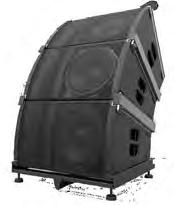
Once a vacant car park, ICI differs markedly from other churches. As a result, the newly consecrated church draws in a very different group of worshippers, explains Ms Wemmy. “They come to hear and understand the powerful sermons, so the audio, video and lighting need to match those sermons. As these are young congregants, ICI holds its Sunday service at 3pm as they don’t want to come with a sore head at 10am. Nor is it just another Sunday service as Impact really does want to make an impact during their 90-minute services. You really do not feel that you are at church – it is more of an extension of your home, whereby you come with joy rather than a sense of duty.”
ASIIS may attract a smaller YouTube audience than ICI and the Kristianuses, but its word-of-mouth referrals are becoming increasingly viral. After all, few AV and lighting contractors can testify to installing a digital state-of-the-art loudspeaker system, a 13.5m-wide LED wall and moving head lights into an upper-level car park.

www.asiis-indonesia.com
impactcommunityindonesia-org

Constant Curvature Array Element
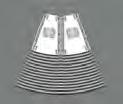

PROJECTS
Build Up your Horizontal, Vertical, Down firing or Stacked Array, in 20° building Blocks ONE SLICE MANY POSSIBILITIES Seamless Transition Waveguide STW www.axiomproaudio.com AX1012
The pastor and ICI leaders monitor themselves on Audiofocus CM 12a coaxial wedges
Egyptian engineering
THE CONSTRUCTION OF THE NEW
Administrative Capital some 40km outside of Cairo has led to the creation of many new and wonderful sites. When it comes to religious constructions, the majority of new buildings in the area are unsurprisingly mosques. The arrival, therefore, of a landmark new Christian place of worship gives the impressive building even greater focus.
Officially called the Cathedral of the Nativity of Christ, the huge domed building is set to be the largest church in the Middle East and was officially opened in the presence of Egyptian President Abdel Fatah al-Sisi and Pope Tawadros II. The new capital now shares the dual accolades of housing both the world’s biggest oriental orthodox church and mosque within its boundaries.
The vast site upon which the church sits was landscaped to include wide, open spaces and verdant greenery. It houses the cathedral, papal headquarters, a smaller church, a multistorey underground car park and a community service centre –all designed to be architecturally compatible with the cathedral. The design of the main building emulates Noah’s Ark, reflecting a Coptic tradition of the church as a lifeboat that transports believers to the safe harbour of eternal life. In addition to daily prayers, the Cathedral of the Nativity of Christ is used to host the most important events in the Christian calendar, such as Midnight Mass on Christmas Eve. Its high-profile services are regularly filmed and broadcast out to a wider audience. Sprawled over an
up to 8,200 worshippers in total. During the planning and simulation stages of the project, it was already apparent that the imposing building would create several challenges for systems integrator Audio Technology Egypt, which, having been invited to tender for the project, was tasked with managing sound reinforcement in the tricky space. Due to the cathedral’s huge dome, high vaulted ceiling and smooth walls and floors, the 135,000m3 interior has an extremely long reverberation time averaging 11s, making speech intelligibility for the congregation problematic. Additionally, the distance from the choir to the far end of the main nave spans more than 120m in length. For these reasons, Audio Technology favoured a beamsteering solution that could direct
audio energy into the desired areas, selecting a Fohhn Linea Focus system. This latest generation of line source systems benefits from electronically steerable beam characteristics that are capable of creating direct and precise sound coverage, thereby aiding speech intelligibility by minimising unwanted reflections.
“Over the years, Audio Technology has supplied and installed sound reinforcement systems for numerous houses of worship,” explains Emad Adly, chairman of Audio Technology. “We also provided system calibration and design services for the Episcopate’s Saint Mark Cathedral, which led to us being invited to bid for the new capital’s Cathedral of the Nativity tender.
“This cathedral is very important to the president,” continues Adly. “He needs the very best quality and this was not easy in such a large place. We presented our technical offer together with the acoustic study of our design.


The acoustics of the cathedral were extremely challenging, so we had to get the best sound intelligibility results and also respect the speaker position with the Coptic altar design. The technology of array steering in order to cover the large area, especially the front section, which was around 60m, was vital.”
The Audio Technology team deployed 14 Linea Focus systems in total, with two lines of seven DLI-430 installed along the sides of the sanctuary to serve as the main PA system. These line source systems – which are over 4m in length – have been specially developed for long-reach applications. Two further DLI-430 cover the choir area. Along the nave, eight Fohhn DLI-230 cabinets form four delay lines, while two additional DLI-230 reinforce both side aisles. AFMG’s EASE Focus acoustic simulation was used to determine the ideal positions. “A lot of details in the design of the church had to be studied and simulated before installation,” says Adly. “It took us
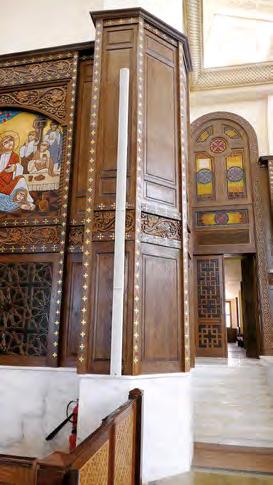
24 WORSHIP AVL May–June 2023
A Linea Focus DLI-430 cabinet
The large domes created issues for audio intelligibility
two months of hard work and several EASE modelling revisions.” Once the design was complete, the installation, commissioning and tuning took the team approximately one month.
A 48-channel Soundcraft Vi1 console with CSB 32/8+8 compact stagebox has been integrated to handle audio mixing duties. This takes inputs from a CD player and a selection of wired and wireless microphones from Shure that include SM series wired mics, MX400 gooseneck microphones and a Shure SLX wireless system with a UA844+SWB-E antenna distribution system, before being fed through the Fohhn Master AM-40 AIREA intelligent audio processor and passed off via Cat cabling to the column speakers. The AIREA can accept signals from a variety of sources and delivers that signal plus control and power out to the cabinets, which all receive their own individually controllable and processable signals.
“The Soundcraft VI series was selected for live and broadcast audio purposes as this is the biggest cathedral in the Middle East,” notes Adly. “The church is therefore mostly used for big events where lots of media are involved.”
A selection of JBL CBT Series passive, controlled-coverage columns provide
not fully covered by the main Focus cabinets, in addition to the smaller chapel, auditorium and multipurpose hall. These are all powered by CDi DriveCore amplifiers from Crown.
“From the front to the back of the sanctuary, the sound inside the cathedral now is just fantastic,” comments a representative from the cathedral. “It’s not a very easy space to manage, acoustically, but everyone coming here is very happy with the quality. Audio Technology have also been very polite and cooperative. If we needed anything from them, they would immediately get it completed.”
“Covering this big space with only 14 digitally steerable line array units was no simple task; however, the measured Speech Transmission Index (STI) with the new system achieves on average a reading of 0.6,” concludes Adly. “The comments from the team there are that the cathedral has the best sound quality in Egypt. Since it’s opened, the president has also issued an order to build the biggest mosque in the Middle East stating that, ‘I need a clear sound just like we have at the cathedral’. There’s no better commendation than that.”
Sound systems for churches


For modern church services modern media technology is needed. This includes a loudspeaker system that guarantees speech intelligibility and at the same time is suitable for powerful music. Fohhn manufactures these systems near Stuttgart, Germany and has been equipping small and large houses of worship all over the world for 30 years.
Fohhn loudspeakers are at home in projects like Gedächtniskirche Berlin or the Coptic Orthodox Cathedral in New Cairo. Many smaller houses of worship also rely on Fohhn.


Get in touch with your personal Fohhn contact via Email at info@fohhn.com or phone: +49 7022 93323-0. You can also find us on the Internet at fohhn.com/churches

PROJECTS May–June 2023 WORSHIP AVL 25
Peripheral areas are covered by JBL column speakers
The Audio Technology team
Keeping the faith
ALREADY A THREE-TIME winner of a Swiss Location Award (in 2019, 2021 and 2022), stateof-the-art events centre The Hall in Zurich plays host to a variety of different events, including concerts, conferences and live productions. It’s also been home to International Christian Fellowship Church (ICF) since 2017 when the venue first opened.
ICF was founded 25 years ago in a small chapel and has rapidly expanded in and outside of Switzerland. Today, the church has over 50 branches across Europe, mostly in Swiss and German cities but also in Austria, Brazil, Cambodia, Croatia, Czech Republic, Israel, Italy, Poland, Ukraine and the Netherlands. Services are held in three languages: Swiss German, high German and English. On a regular Sunday, the church will bring together around 1,200 live in-person and online worshippers, increasing to 3,000 views after a week of the service being posted online and up to 1 million views after a month.
The church’s relationship with Blackmagic Design and local systems integrator EventAg extends back to 2012. “EventAg contacted me and showed me some of Blackmagic’s new cameras,” explains Marco Rychlik who joined ICF in 2008 as technical director for video. “We tested and rented a lot of their equipment but it was our move into The Hall in 2017 when everything came together. Before that, we had a portable
flightcase for video production that had to be built up and torn down every Sunday. Moving into The Hall was a big step for us – they trusted me to scale up the system and we invested around 300,000 Swiss francs for a control room, cabling, switches and server room equipment. In the basement we have rooms that we rent permanently but we only rent the auditorium on Sundays.”
When The Hall was built in 2017, EventAg fitted the venue with live production and camera hardware

from Blackmagic Design. For the first nine months of its residency, ICF was attempting to livestream with an URSA Mini 4.6K but the delay was proving too distracting on the screens within the venue. “I remember as a Christmas gift we received an URSA update which reduced the frame delay and it was a great moment when we realised we had made the right decision and invested in the right equipment. The update allowed us to scale up from two cameras to more than five cameras.”
During the pandemic, the venue needed to meet the increased demand for studio space and streaming capabilities. “That included the installation of a virtual LED stage with XR [extended reality] capabilities built on Unreal Engine and DeckLink 8K capture cards,” explains Simon Bachofen, project manager and product manager video at EventAg. During this planned conversion, the church also replaced its URSA Mini 4.6K with 11 URSA Broadcast G2 cameras for live production.
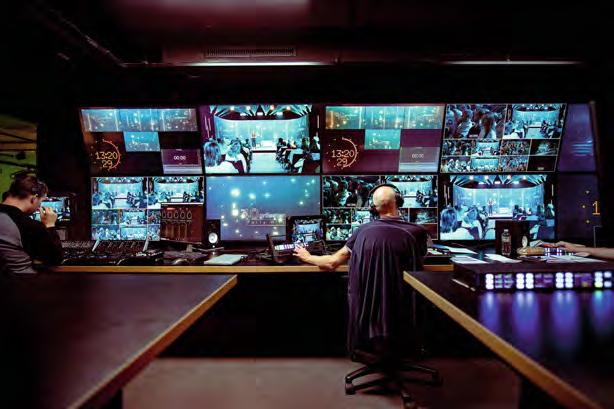

ICF has remained faithful to Blackmagic Design’s products to help reach its growing number of in-person and online worshippers
26 WORSHIP AVL May–June 2023
PROJECTS
The basement studio
The control room has been equipped with two ATEM Constellation 8K live production switchers
“We were able to hit the ground running during the pandemic,” continues Rychlik. “We’d oversized the system in 2017 so that when Covid arrived, everything came together – every piece of equipment was put to good use. After one week of everything shutting down, we were streaming every day from a little studio in the basement and we learned so much in that time. The G2s give us more dynamic range and provide us with the ability to stream our services in a higher quality.”
The live camera feeds are routed to the venue’s main gallery, which has been equipped with two dedicated ATEM Constellation 8K live production switchers. “The URSA Broadcast G2 delivers a modern film look with nice colours and less noise,” adds Bachofen. “Likewise, the interchangeable lens mount and option to record using USB-C drives make these cameras and the space more versatile.”
The main venue space also features a new 3D cable camera system. Rigged with an URSA Broadcast G2, the EagleEye uses fibre for all video and CCU signals plus control. For the church’s Sunday services, video content is streamed and recorded, then played out on a 120m² 4K LED wall running from a Barco E2 Event
choice for the latest upgrade. Its solutions are also easily scalable, and new components can be added anytime.”
The church, which has purchased most of the camera equipment, is financed by donations. “That’s why
they were looking for a solution that offered good value for money,” confirms Bachofen. “But since other event organisers who use the venue can also rent those systems out, anything we recommended had to be versatile enough to support
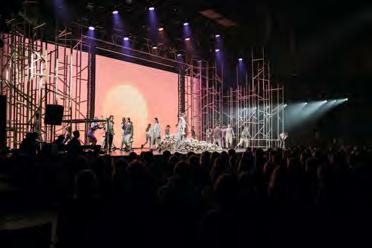
both studio and live production. For example, a television studio rented the space recently for a show and used the same production systems as ICF, underlining the solution’s
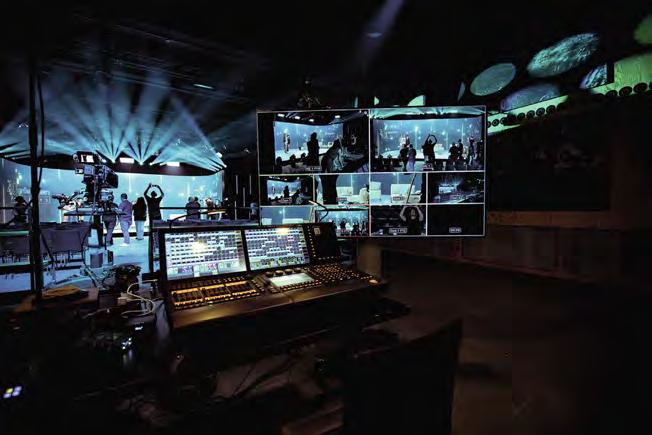
Yet Rychlik still has other Blackmagic items on his shopping list, including the recently released 6K Studio Cameras with built-in tally. He’d also like to be able to stream images over the internet to the switcher so that the church can stream from anywhere in the building, such as the foyer or the balcony. At present, the church records add-ons including messages and news for the beginning and end of the livestream but this is currently restricted to the basement. “But we’ll have to wait until there’s enough money in the budget,” he concedes.
www.eventag.ch
www.icf.church
SI SERIES P10 und S210
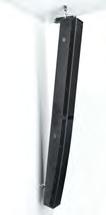
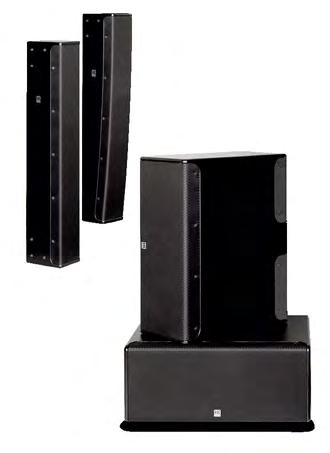
VERSATILE INSTALLATION TOOLS

With the new SI SERIES HK Audio has unveiled a family of speakers tailored to meet the needs of today’s installation market.
The two new S210 V and S210 P subwoofers complement the P10 column speakers in the low-frequency range. For use in particularly demanding outdoor environments, both the P10 and S210 P are tested and certified with IP 66 protection class.
The combination of dustproof as well as water proof mid/high unit and subwoofer is unique worldwide and delivers uncompromising audio quality even under the most difficult environmental conditions.
Certified for voice alarm (EN 54-24:2008)
Master processor to various monitors installed inside and outside the multipurpose venue space. For signal management, the AV solution employs multiple Universal Videohubs, as well as three 40x40 12G Smart Videohub. DeckLink and UltraStudio capture and playback cards are used across the various computers for fill and key signals. ICF also produces smaller livestreams throughout the week, using an ATEM Mini Extreme ISO and multiple Pocket Cinema Camera 6Ks. “ICF productions rely almost exclusively on volunteers, and the team members supporting these are constantly changing. The solution, therefore, has to be simple to set up and easy to use,” says Rychlik. “The existing ecosystem has been successfully used since 2017, so Blackmagic products were a natural
Certified ingress protection class IP 66 (EN 60529, applies to P10 and S210 P)

Certified ball impact proof (DIN 18032-3)
P10i/j: low impedance (16 ohms), 300 W (RMS), 128 dB SPL (10 % THD)
Extensive
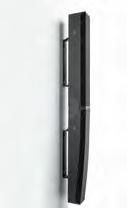
PROJECTS May–June 2023 WORSHIP AVL 27
PROFESSIONAL
hkaudio.com hkaudio.com hkaudio.com hkaudio.com
P10i/j TR: 100/70 V transformer, 3 power taps (150 W max.), 125 dB SPL (10 % THD)
HK_Audio_SI-SERIES_Anzeige_2022_Family_en_160x139.indd 1 10.05.22 08:51
mounting accessories for walls, ceilings and for flown installations
The small FOH setup in the basement studio
AV on the network

stable phase. While there are still valid use cases for connectorspecific applications like HDMI and XLR, many of the products revealed at ISE eschewed those legacy-style connectors in favour of only RJ45 or USB-C. But while connecting devices to the network is increasingly approaching plug-andplay functionality, there’s still a lot of planning and consideration needed to run AV over the network successfully. Creating a converged network, with AV and data running side-by-side, was the holy grail back in the day. IT teams often refused to add AV to the network for fear of causing bottlenecks or disruptions. Now, we’re seeing a trend in that direction as AV devices evolve as good network stewards. There’s still a perfectly good use case for separate networks, especially if you’ve got a high level of AV traffic that needs to be managed, and it’s a significant part of your bandwidth.
One of the biggest challenges is the large number of manufacturers and myriad ways they implement networking. A classic fix for the interoperability challenge is the “walled garden” approach. The advantage is that the products work well together, but the disadvantage is that you’re limited to that one brand. If the manufacturer doesn’t have what you need or stops making something you like, then you’re stuck, unless you
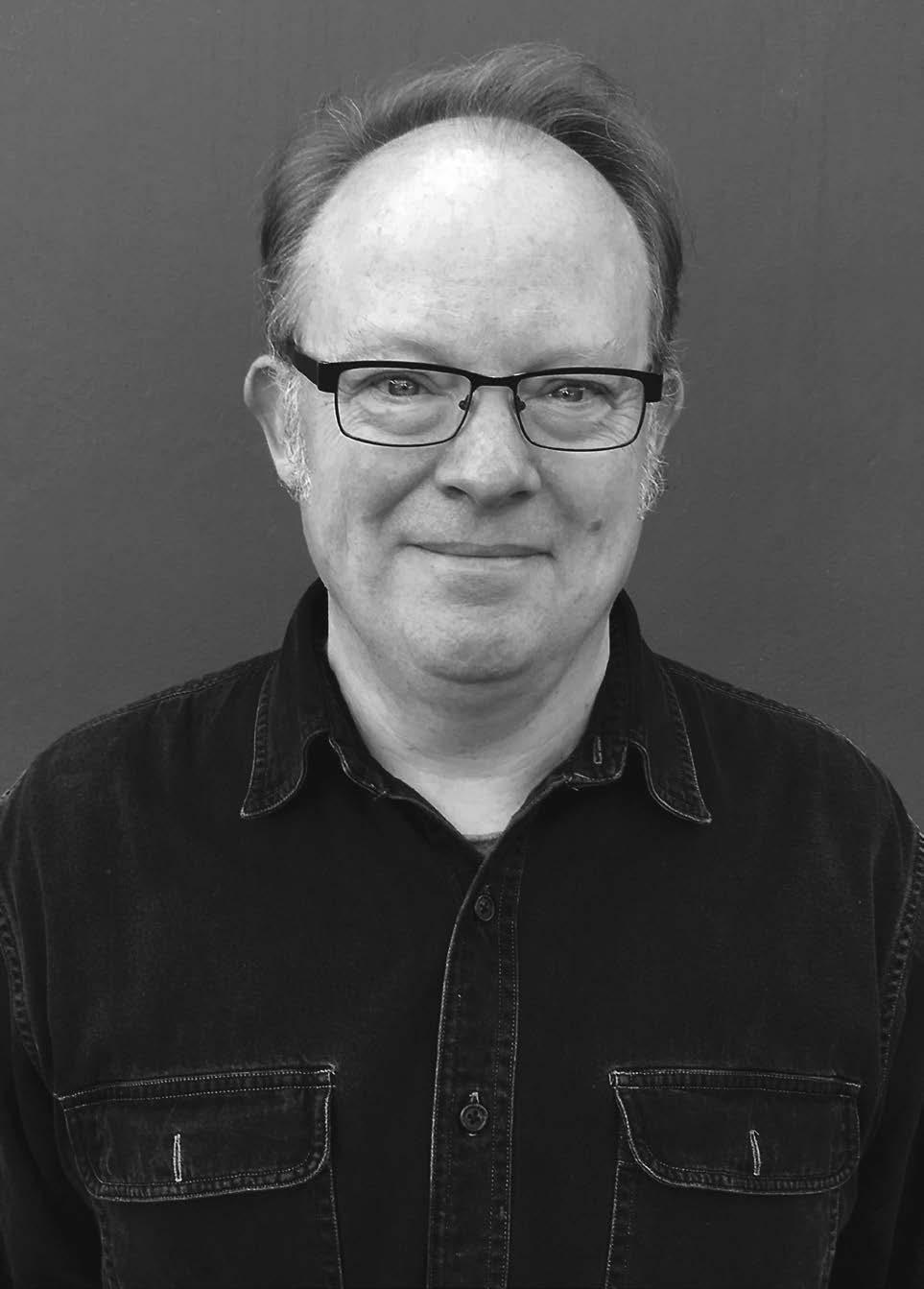
Another potential fix for interoperability is the establishment of standards. Standards create agreedupon technology elements, but they don’t provide the implementation or support of the underlying technology. No measure of quality is inherent in the standard. Many also leave the door open for enough interpretation to cause interoperability issues. An alternate case for interoperability is having a third party develop a fully supported holistic transport solution. The advantage is that if something goes wrong with the implementation, there’s a company that supports the platform, has a deep understanding of the technology and wants to help integrators and manufacturers alike. The point of synchronising audio and video is to time-align what we hear with what we see. The human brain can withstand some mismatch watching people speak or play instruments, but only up to about 200ms before being impacted. Audio and video are often treated as separate streams because they have different processing requirements and are sent to different endpoints. But having separate streams and transport pathways greatly increases the chances of asynchronous AV delivery. The primary advantage of a converged network is everything runs over the same cable, and you can use fewer software instances to
Designers need to draw out the system, note where the switches and the subnet boundaries are, and then consider how they’re going to manage multicast inside the areas of the network using an AV-over-IP system, ensuring there’s enough bandwidth in the trunks (switch-to-switch connections) to prevent a choke point. In a typical bespoke design, the trunk connections are 10Gb or faster, while the downstream connections are 1Gb. Today’s endpoint connections are primarily 1Gb and, while audio
is an entirely different story. An uncompressed 4K60 stream with HDR is approximately 35Gb/s, so nearly all networked video is compressed in some fashion. Different applications use different compression codecs, each with pros and cons for implementation and transmission. Streaming codecs like H.26x are often easier to implement and support much higher compression rates but at the risk of introducing visual artefacts. H.26x is great (good enough) for lots of applications since end users are used to it, and it’s inexpensive to implement because it’s been adopted everywhere for medium-fidelity video. Many video products use that technology, but not because it’s the best for a network. It has much higher latency and is much less predictable but is very efficient. Because of this, Audinate introduced Dante AV-H, software designed to run on systemson-a-chip to give them access to Dante control and management. Converged networks are gaining popularity as AV devices behave more intrinsically like IT endpoints. But creating a converged network and managing it effectively are two separate issues. One of the biggest keys to the success of any large, converged network is how easy it is to manage, so take the time to choose wisely.
www.audinate.com
KnowHOW
28 WORSHIP AVL May–June 2023
Brad Price
Audinate’s Brad Price explains why you can’t think about audio networking without considering video

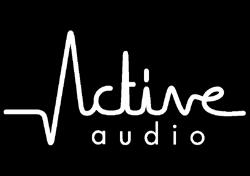



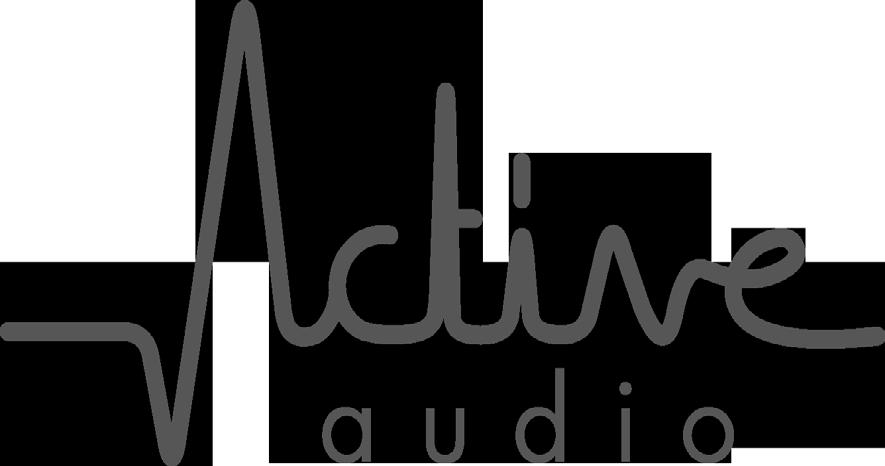

 Active Audio an Arbane Groupe brand
Active Audio an Arbane Groupe brand
Choosing a PTZ
FIRST OFF, LET ME DEFINE WHAT
a PTZ camera is. “P” stands for Pan, “T” stands for Tilt and “Z” stands for Zoom. It is a single camera unit that can pan, tilt and zoom via a remote control – usually via some kind of joystick. PTZ is not the same as a “remote head”. This is a device that you fit a normal broadcast camera onto that will do most of what a PTZ camera can do regarding the movement –panning and tilting and also allow you
remote control of things like focus, zoom, etc. These types of devices are very useful if you have a broadcast camera set up already but want to introduce some kind of remote control into your production. The disadvantage is that you will spend more money than if you go for the “all-in-one” system. There are many different brands and qualities of PTZ cameras and you will be able to find something to fit whatever budget you have. It’s also
worth knowing that this is an area experiencing a lot of tech development at the moment – so things are evolving and improvements are happening all the time. Of course, one truth remains – the more money you pay, as a general rule of thumb, the better quality of unit you will get. Or, as a friend of mine says, “You get what you don’t pay for.”
I would, however, always err on the side of purchasing a PTZ camera from a company with a reputation for making cameras rather than a company specialising in robotics. The reason for this is that you get higher technology in the areas that matter most in terms of quality – chips, lenses and so on – because these manufacturers take technology from other camera systems and use it in their PTZ systems. There are three main reasons to consider going the
Budget – as mentioned above, there are cameras to match most budgets and they will likely work out cheaper than a manned camera system. If you want high-quality images, you will need to pay a higher price. With PTZ cameras, you are paying a considerable amount of money for the “mechanism”,
so a similar-costing camera that isn’t a PTZ will produce higherquality images as all the budget is going into the sensor and lens, for example, and not to the “robotics” side of things.
Team – if you do not have enough people to run manned cameras (often a big issue for churches –particularly smaller churches) then a PTZ camera system could be worth looking at. You can have one person running several PTZ cameras so it can be a great way to have a multi-camera setup without lots of volunteers. For me, this would be the main reason I would favour them.
Placement – where space is at a premium and you don’t have room for a manned camera (with a tripod and cameraman), then a PTZ camera can give you a good solution. You can also “attach” them to things such as columns and walls and can hide them away where the aesthetics of your church are important.
How should you use a PTZ camera?
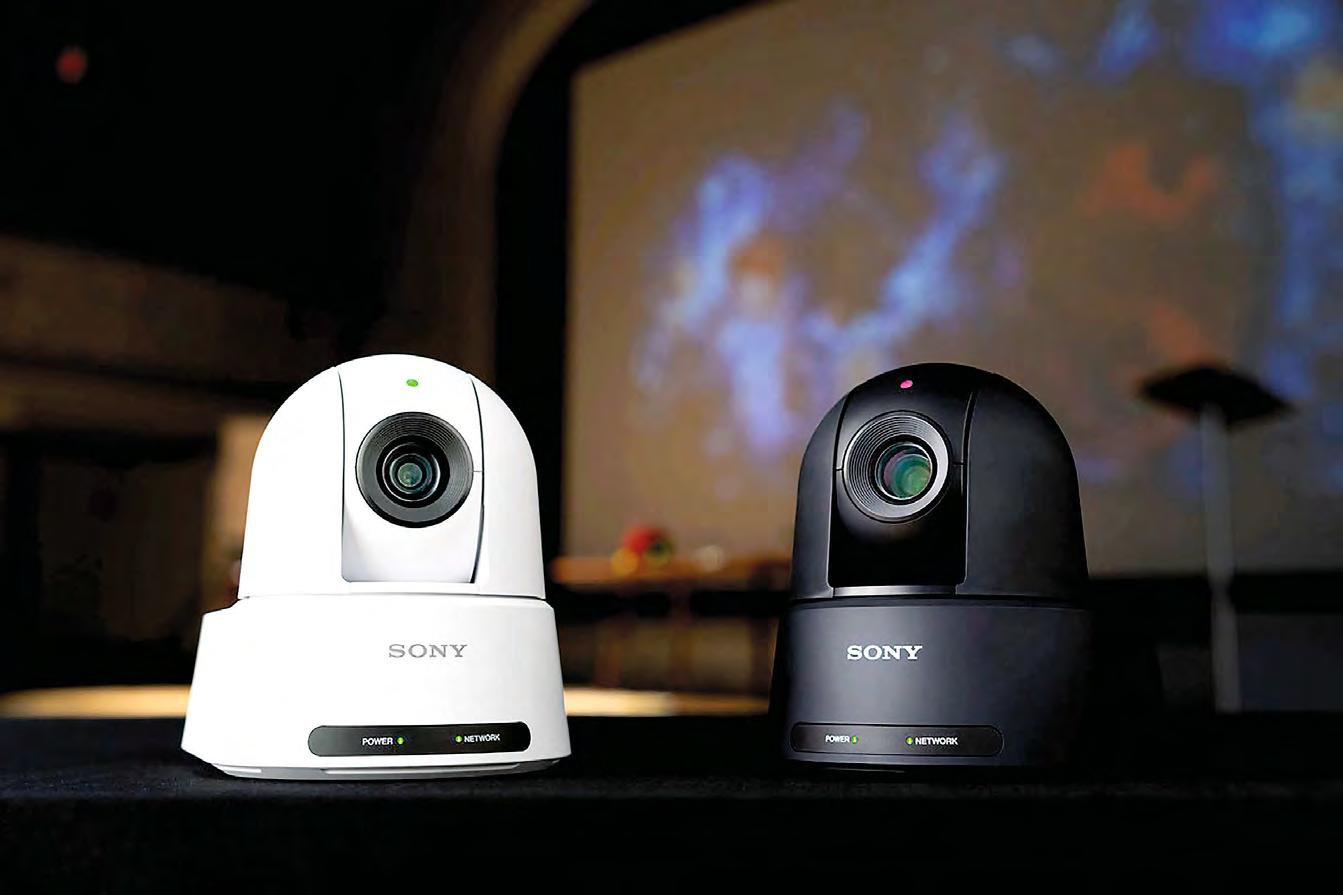
A PTZ camera is particularly good for a “static” setup where you don’t have much movement – for instance,
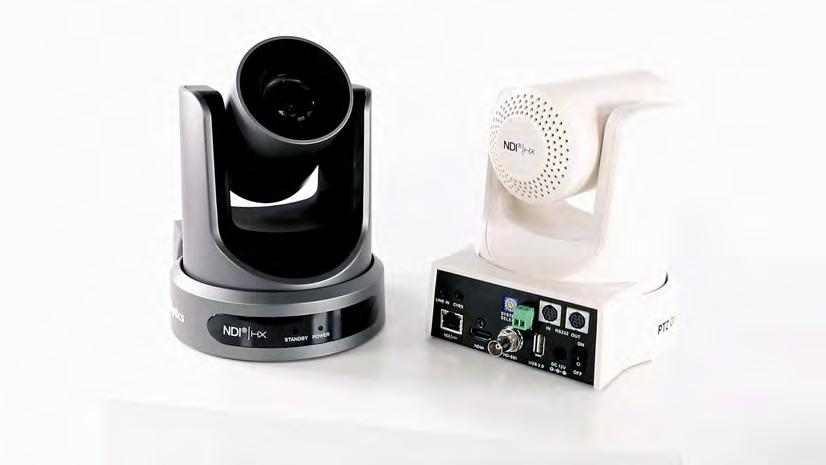
30 WORSHIP AVL May–June 2023
PTZOptics cameras with support for NDI|HX
The SRG-A40 in black and white from Sony
PTZ cameras are becoming more common in church production setups, says Graeme Spencer, founder of Media Mentoring. However, it is important to understand their limitations and how best to use them
if your preacher doesn’t move much and your band is fairly static. You can then programme different shots and framings on the cameras that you can cut to via presets, enabling you to swap shots with speed and make the production look good.

You can also use them for angles where you can’t get a camera operator to get the shot. Onstage around your drum kit can be useful and, again, you can preset a variety of shots too.
PTZ camera setup
I also am a fan of integrating them with manned cameras. You don’t have to do an either/or. I would use them for wider static shots and then still have a manned camera as your close follow. The key is to think through what you are trying to do and then utilise the best option (camera choice) for each camera position.
If you go down the PTZ route, one thing to consider carefully is your lighting. PTZ cameras, in general, require much better lighting (they are less forgiving) than other cameras. I’ve seen countless comments about how people who purchased these were disappointed with the image
quality – almost all of them due to a poor lighting setup.
Where should you put your PTZ cameras?
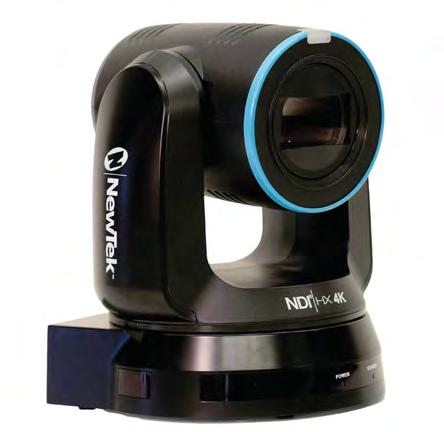
We touched on placement earlier.
Often churches will put them “out of the way” and while that may work from a space perspective, I still believe that PTZ cameras are best placed in the same locations as manned cameras.

That’s where you will get the best shots.
One final thought on placement – don’t be afraid to move them. You may find that you need to make changes for different types of production and so you should. Do you pre-record elements rather than stream live?
If so, move the cameras to where works best for the pre-recording and then back for the live stream. When
you are installing the cameras, I would recommend thinking through all the places you may want them for different shoots and run cable to each location.
A few final things to consider for you. I mentioned the idea of integrating PTZ cameras with other “manned” cameras can give you some great options. But you need to consider matching issues. It is best to match all your cameras to whichever is the lowest spec camera and get everything looking as good as you can from that basepoint. Again, getting your lighting right will be critical here. Also, watch out for camera shake. Placing them in or attached to balconies for example can be problematic. You can find ways to
eliminate some of these problems but avoiding putting them where shake could be an issue. Often when an installation is being done, you don’t have the same production conditions, so you can’t know what the impact of people on a balcony will be on possible camera shake, but I propose you plan for the worstcase scenario.
Connections on PTZ cameras
One final thought – a lot of these cameras now work via NDI and IP, which makes cabling simple but can also introduce latency issues into your programme. Make sure you think this through as you don’t want out-of-synch video and audio on your livestream or on your IMAG.
The main reason I would use a PTZ camera is a lack of camera people, but keep in mind that camera people can be great assets for any team and often go on to be great directors or lighting people – I always recommend having some camera people on your team so you can be training them up for the future. PTZ cameras should be used as part of a strategy, not as the sole strategy.
www.mediamentoring.net



The team at DWR Distribution look forward to assisting you with the sale of sound, staging, rigging, power, audiovisual and lighting equipment, backed up with advice and great service. We also offer professional installation services.

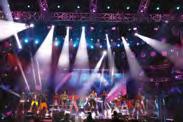
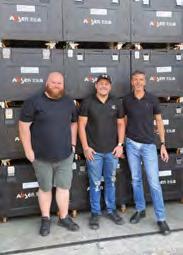

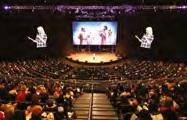



KnowHOW May–June 2023 WORSHIP AVL 31 DWR Distribution, Block C, Unit 1, Kimbult Industrial Park, 9 Zeiss Road, Laserpark, Honeydew, 2170, Johannesburg, South Africa • Tel: +27 11 794 5023 • Fax: +27 11 794 5702 • www.dwrdistribution.co.za
Looking for a professional audio
Stage and Touring • Theatre and TV Studios • Events and Leisure Discotheques and Clubs • Architectural Lighting • Worship • Schools
visual solution?
NewTek’s NDI PTZUHD
Troubleshooting DMX
WE’VE ALL BEEN THERE. WE hang an LED or automated instrument, cable it up, get back to the console to test that we can fully control it and nothing happens (or something happens but not what we expect). Or, you’ve had a rig in place working properly for a few weeks or longer and then, all of a sudden, one of your LED or automated instruments stops working.
In the world of conventional instruments, troubleshooting is quite simple – check lamp, check power, check patch. Conventional instruments really are not much more than large, high-wattage floor lamps that you would find and be able to, more or less, troubleshoot fairly quickly. In the world of LED or automated instruments, however, troubleshooting becomes a little bit more complicated.
If you’re a seasoned lighting technician or a lighting professional, troubleshooting DMX is fairly straightforward. But if you are a lighting volunteer who shows up to turn lights on and off once a month, troubleshooting an LED or automated rig can quickly become a daunting task.
• Is the instrument display screen or DMX presence indicator light flashing? Though not the same on all instrument brands or models, most will have some visible method to communicate the presence (or absence) of DMX. In my inventory, I have some instruments that have an LED indicator light that flashes when DMX is not present and then changes to solid when DMX is present. I have others that will flash the entire display screen when DMX is not present and then stop flashing when DMX is present. This is particularly useful as I can easily see this in my rig from a distance. Look through your product manual and learn how your specific instruments may indicate to you the presence (or absence) of DMX. If you experience that DMX is not present, it may be that there is a DMX cable and/or distribution problem that you need to resolve.
doesn’t respond as you would expect?
• Is the instrument behaving erratically or abnormally? For example, does the instrument strobe, flash randomly or make sudden unexpected movement? If so, this most likely will indicate to you that yes, the instrument is receiving DMX, but there is a problem with the DMX signal that it is receiving. If you are experiencing this type of abnormality with your instrument, there may be a couple of possible causes that we’ll look more at.
While these are not the only “symptoms” you may experience, they are some of the most common issues that you can identify first by looking up at the problem instrument. If you skip this step, you may find that you spend a lot of time replacing or checking cables, digging into the console program, resetting the instruments themselves and then continue experiencing the problem. Proper diagnosis and seeking to understand what is actually happening is half the battle when it comes to troubleshooting DMX.
So, once you have diagnosed what you are seeing, you will then have an idea for how to go about troubleshooting the instrument. Let’s take a look at each of the questions and scenarios that were posted in Step 1.
Scenario 1: the instrument is not receiving DMX
In this article, I’m going to provide some quick tips to hopefully help you troubleshoot your LED or automated instruments, specifically with regards to DMX. If you aren’t familiar with these types of instruments, you should know that they require
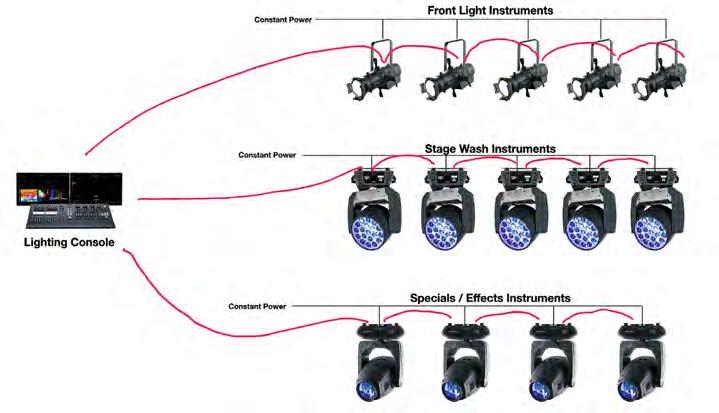
(1) a power source and
(2) data to control the instrument. This article is not going to look at troubleshooting the power source –I am going to assume that your instrument(s) is receiving power. Rather, we will be looking at DMX, which is the control data that tells your instruments how they should behave.
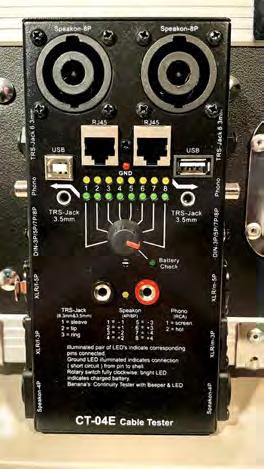
Step 1: what are you seeing?
Taking a minute to pause and look at the problem instrument can actually tell you a lot about what the issue at hand may be and help direct you towards an approach for problem solving. What are some things that you should look for? Ask yourself the following:
• If DMX is present, is the instrument responsive at all, or is it just responding unexpectedly? If the instrument is not responsive at all, it may be that the instrument is incorrectly patched in the console. If the instrument is responding, but not as you would expect, it may be that the instrument is patched incorrectly at the console or the wrong “personality” is used for the instrument. For example, does it seem that the pan and the tilt are reversed, or some other function
If your instrument is not receiving DMX, it is highly likely that there is a bad cable somewhere between the instrument and your console. Especially when you have many instruments in your rig, it is best to start troubleshooting from the instrument and work your way backwards. Here are some of the things that you can do:
• Check the DMX cable connected to the DMX input of the instrument. If you have a cable
KnowHOW
John Black provides some quick tips to help troubleshoot LED or automated instruments, specifically with regards to DMX
32 WORSHIP AVL May–June 2023
Scenario 1 – working backwards through DMX connections
Scenario 1 – cable tester to check cable fidelity
tester, connect both ends of the cable and make sure that there are no faults in the cable itself. If you don’t have a cable tester, an easy way to check a cable is to plug it into another DMXenabled instrument. If the “new” instrument receives DMX, then the issue is with the original instrument, not the cable.
• If this DMX cable has no faults, plug it back into the instrument and make your way to the next cable in the signal patch getting closer to the console. Continue with this process of checking for faulty cables until you are sure that all of the cables between the instrument and the console have been checked.
• Depending on your system, you may distribute DMX through networked nodes, splitters or other distribution equipment for getting DMX signals from your console to all of the lighting positions in your space. While I will not go into detail about troubleshooting those devices, know that if they sit between the problem instrument and the console, you may also have to test and make sure that those devices are also working properly.
Scenario 2: the instrument is receiving DMX but is unresponsive or responding unexpectedly
If you can confirm that the instrument is receiving DMX, it is highly likely that the issue lies either with the instrument itself or with the console. In this scenario, I recommend first starting at the instrument and then moving to the console. Here are some of the things that you can do:
• Check to make sure that the instrument address (set on the instrument itself) is what you think it ought to be. This starting address needs to match what is patched on the console. The best way to keep track of instruments and their addresses is to maintain proper lighting paperwork, whether a light plot, instrument schedule, patch schedule or some kind of paperwork that you and your team can use to reference the real instruments that are hung.
• Check to make sure that the instrument “mode” (set on the instrument itself) is what you think it ought to be. Many LED and automated instruments can
be controlled in a number of different modes that consume more or fewer control channels.
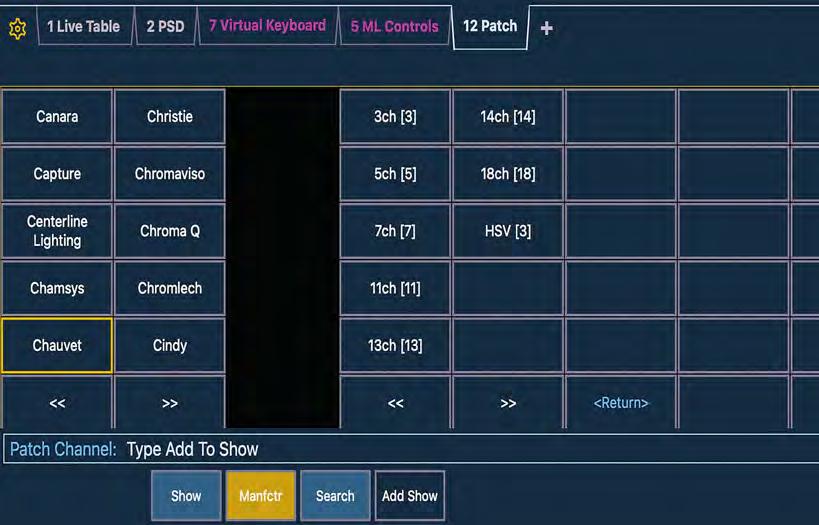
If, for example, your console patch uses “personality B” but your instrument is set to “A”, this may result in the instrument responding unexpectedly because the console controls may not match the controls of the instrument itself.
• Check the console patch for the instrument. This is done on the console and should match the starting address and personality of the instrument as set on the instrument itself. If the starting address of the instrument patch does not match exactly, then you may experience unexpected
responses from the instrument. The same is true if the personality is set incorrectly.
• If an instrument is completely unresponsive, it may be that the patch is completely wrong in the console. If you have a lot of instruments in your rig, it may be that your system uses multiple universes of DMX, in which case you also need to make sure that when you patch, you include the universe information.
Scenario 3: the instrument is strobing, randomly flashing or moving erratically
These types of experiences happen when DMX is being received by the instrument, but there is some other problem. This can often be the hardest problem to solve, but it doesn’t need to be. Here are some things that you can do:
• These behaviours often occur when the limitations of DMX have been exceeded. For example, a DMX chain is limited to 32 devices. If you have more than 32 individual instruments on a single DMX chain, you may experience these symptoms. DMX is also limited to 512 control channels per universe, and if an instrument’s starting address is set such that subsequent control channels for the instrument exceed 512, you may experience these symptoms.
• In cases where I have experienced this behaviour, it has mostly been due to mis-assignment
of instrument addresses. For example, I have some conventional LED wash units that are set in a four-channel mode. If the first instrument is set at channel 1, then the second should be set at channel 5, the third at channel 9 and so on. If, for example, the third instrument is set at channel 7, then this behaviour is seen because the third instrument’s starting address conflicts with a channel in use to control a parameter from another instrument.
• It may be that this is experienced when a DMX cable is close to a power cable or extension cord and is experiencing electrical interference. In this case, move the DMX cable or the power cable so that they are physically spread apart more.
• Last, check the soldering on the connector pins. If there is any chance that solder or strands of the cable are touching and not isolated to their correct pins, that may also cause the instruments to behave in this way.
While this certainly does not go into great depth or detail, I hope that these simple troubleshooting tips can help you feel a bit more comfortable when dealing with problem LED or automated instruments. As previously mentioned, seek to diagnose the issue first before conducting any troubleshooting to make sure that you are addressing the right problem.
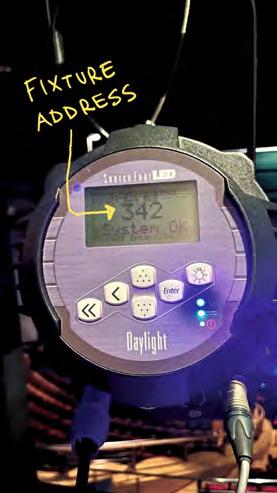
KnowHOW May–June 2023 WORSHIP AVL 33
Scenario 2 – check the fixture address
Scenario 2 – patch variations of a Chauvet Ovation 915FC
Digital mixing for hybrid worship
WHEN MIXING FOR LIVE AND streaming/broadcast, two separate mixes are needed: one for FOH and one for streaming. These two listening environments require very different mix approaches. Front of house is mixing for an extremely dynamic live experience that must factor in room acoustics, natural reflections and decay times, while simultaneously managing factors such as feedback. The listening environment for streaming requires a mix with much less dynamic range. An additional element is that the listener is not experiencing the acoustic energy of the live space. This has to be recreated in the mix through use of spatial effects processing and the use of audience mics, while managing factors such as PA bleed.
To balance the two mixes simultaneously, the best approach is always going to be to have separate engineers operating the different mix positions. But that’s not to say that if absolutely needed, it can’t be handled
by one engineer effectively. The real challenge in this case is monitoring two mixes simultaneously: can you effectively make mix decisions for one purpose without monitoring it, or monitor a streaming mix in the middle of a room with a live PA?
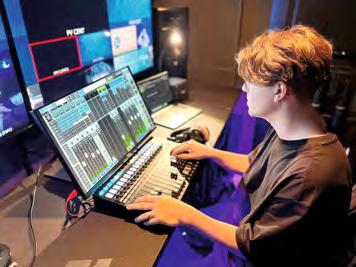
To manage two simultaneous mixes effectively requires a lot of offline trial and error in order to establish a template and some known relationships between the two mixes that you can abide by. One must consider how the relationship between vocals and the band differs from one environment to the other and how much more or less spatial processing is needed in the mix, etc. You need to figure these things out ahead of time and build your session in a way that follows the parameters you determine and then translate them as effectively as possible in the moment.
To accommodate these twin applications, a console must have, first of all, a flexible bus structure. There are different approaches to
building multiple mixes from the same desk, whether that’s through auxiliary busses, mix groups, matrixes or some combination of those options.
You must be able to route channels or groups of channels to multiple desired outputs while maintaining independent mix relationships or, in some cases, relative mix relationships. A console must also provide the ability to monitor and cue elements of both mixes separately.
For example, the Waves eMotion LV1 Live Mixer gives you 24 mono/ stereo auxiliary busses, eight stereo mix groups and eight mono/stereo 12-input matrixes. Every matrix input and auxiliary send has the ability to be independently sourced directly from a channel input, pre-fade, post-fade or post-pan. This gives you a tonne of flexibility in how you build a mix through various busses in the same desk. You can also add additional processing through Waves plugins to any of the output busses to further shape a mix for its specific purpose.
One may ask if it is possible to accommodate all three applications, live mix, streaming and monitoring simultaneously with a single console. It is definitely feasible; however, it ultimately comes down to how many overall busses and outputs are required and if your console can accommodate those requirements.
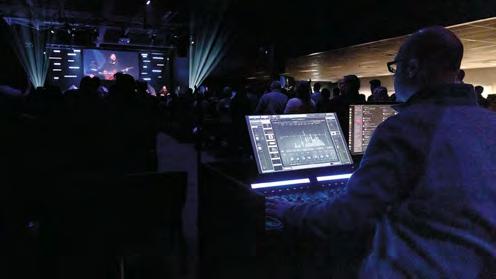

If you’re building your streaming mix through an auxiliary bus, does your mixer have enough busses to accommodate your onstage monitor mix requirements and an independent streaming mix? If not, can you effectively build an independent mix through a matrix?
It is not an uncommon practice, particularly in the HOW world, for a single engineer to be responsible for a house mix and for building monitor mixes for the band. The introduction of personal monitor mixing systems and monitor mixing apps can greatly alleviate the demands on the engineer.
TECHNOLOGY 34 WORSHIP AVL May–June 2023
Waves’ LV1 Live Mixer
Audio director Jesse Taylor with an LV1 setup at The Chapel Grayslate, Illinois
Jeremiah Clever, live/senior product specialist at Waves, shares what it takes for one mixer, and one console, to handle the audio mix for FOH and another for streaming in a hybrid worship paradigm
AV director Adam Geesamann with a Waves eMotion LV1 at Victory Church, Pennsylvania
For example, the Waves eMotion LV1 offers a free personal monitor mixing app, MyMon, that allows up to 16 users to manage their entire monitor mix from their mobile device or tablet with a great deal of control and ease-of-use for each user. The LV1 also supports the integration of many third-party hardware personal monitor mix systems. This frees the engineer up to concentrate on other tasks with minimal requirements for monitors.

At the end of the day, the relationship between the FOH and streaming mixes ought to be built ahead of time. You have to give yourself the proper time and listening parameters to make effective mix decisions and understand how that will translate during a live worship service. Any decision you try to make during a live service, without having established that understanding, would be a guess at best.

Once a worship service begins, the responsibility of the front of house

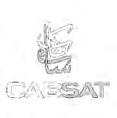
engineer is to ensure a conducive environment for the message being communicated from the stage. Often, that translates to hitting queues or reacting quickly to solve technical issues to avoid distraction. You don’t want to be second guessing your mix or mixes in the moment. Tools like virtual sound check are there to give you the time you need to focus attention where it’s needed.
The ideal multifunctional console would address all the aforementioned points. In addition, crucial capabilities would be a flexible and easy-to-use routing and bus structure, the ability for onstage talent to manage their own monitor mixes through an app or personal monitor mix system and the ability to conduct sound checks, virtually to make offline mix decisions. A customisable user interface could also play a major role, enabling the engineer quick access to different zones of the mixer at any given time.

In those circumstances where you would consider having more than one engineer mixing on the same console, a configurable desk like the Waves eMotion LV1 has multiple mix windows, each with their own customisable fader banks. You can also assign a physical control surface to each mix window independently. This gives you a good deal of flexibility in how you manage
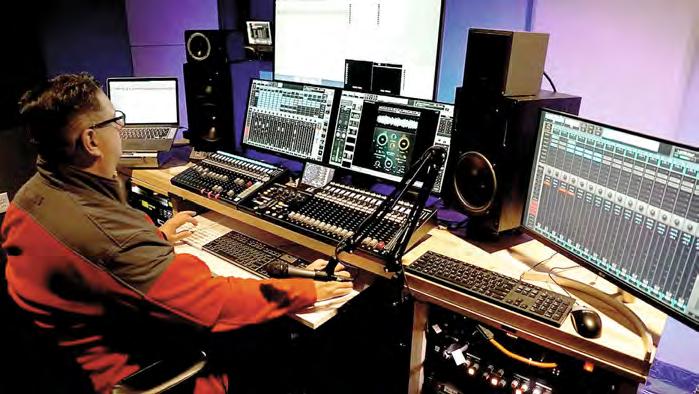
your mixes and opens the door for multiple operators on a single mixer. With flexible output routing, you can also set up independent monitoring for a second engineer. This workflow isn’t without limitations but, if managed appropriately, it can be effective.
As far as modular and networked audio goes, if the goal is to make a single console perform multiple tasks simultaneously, then connectivity is key. The ability to connect to third-party hardware for personal monitor mixing, the ability to multitrack and playback through a DAW for virtual sound checks, the ability to route audio outputs directly to embedders and software encoders for streaming – these are all necessary features. Modularity, like that provided with the LV1 platform, allows a console to be tailored for a multiple task use, with audio networking via Waves SoundGrid technology accommodating software and hardware solutions devised to bring real-time processing, distributed audio and the power of Waves plugins to any system, studio or live. This approach meets the high demands of today’s production environments with tasktailored control flexibility and without the need for multiple stages of conversion and over engineering.
www.waves.com







TECHNOLOGY May–June 2023 WORSHIP AVL 35
Mixer, producer and audio consultant Yamil Martinez with a Waves eMotion LV1 setup at Church on the Rock, Missouri
Basic signal routing
NO MATTER WHAT YOU DO IN building a video system, you are doing some sort of routing. Whether you are installing a backbone with a major router or whether you are simply running a cable to a monitor, you are routing a signal. Routing is essentially the same as plumbing. Let’s discuss some routing levels.
Basic routing
You might have a small enough system where you have it all wired up, you never have to change anything and that works for you fulltime. If that is you, congratulations! That is a nice place to be. But for most, some basic routing takes place regularly. This might be a cable you swap out each week so that you can accomplish one task, but then you restore that to its normal configuration. I can think of an example of this in my office right now. I have a Roku player that
TV to change connections (I am out of inputs), I have a coupler on the dangling end of my desk cable, and I barrel that to the HDMI cable that I unplug from the Roku. Now the connection at my desk to my TV is hot for me to test gear with. All of that is basic routing. You might have an A/B switch or a four-port HDMI switch in your setup. That is a basic router.
Moderate routing
I would consider moderate routing to be an installation where you have a small video switcher, splitter or combiner in-line in places. Perhaps you have a combination of multiple devices tied together like a switcher and several cameras and an output to a splitter for distribution to your screens or video recorders. Maybe you involve an audio mixer with embedders/de-embedders. These setups are very common
Acres in Tyler, he spent the past 25 years in broadcast television working for multiple television stations in the US. He has worked as a broadcast technician for a major telecoms company, managing national and international television broadcast signals over a switched fibre optic network. He also owned and operated an independent video production firm in Tulsa, Oklahoma for 10 years before returning to Tyler in 2016.
to operation. If you are still in the HDMI world without ever getting to the HD-SDI level, then you are not going to have many options for a true router, as that is primarily an SDI-level world.
Large routing
We have large routing at my church. We have a 64x64 Harris Platinum HD-SDI router. That means it has 64 inputs and 64 outputs. We have outgrown it and I really need a 128x128 version of the Platinum. Blackmagic Design makes a 40x40 HD-SDI router that is very affordable considering what it does. When you get to this level of routing, however, you have a completely different infrastructure. When you have a router design like ours, everything is centralised within that router. We never just wire up a camera direct to a switcher or a recorder or anything like that. Every source and
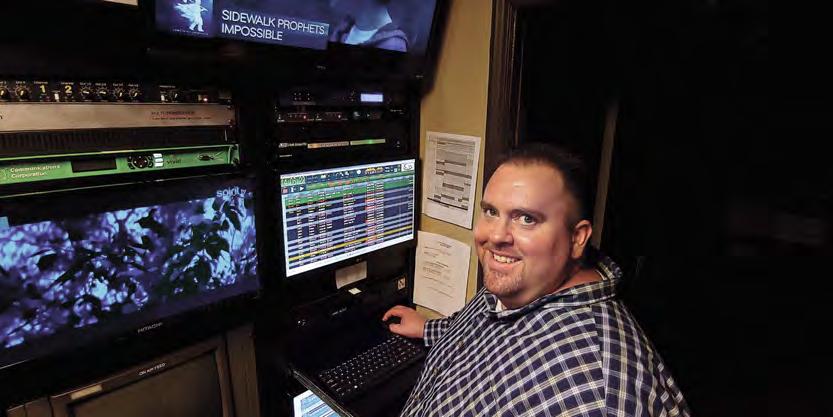
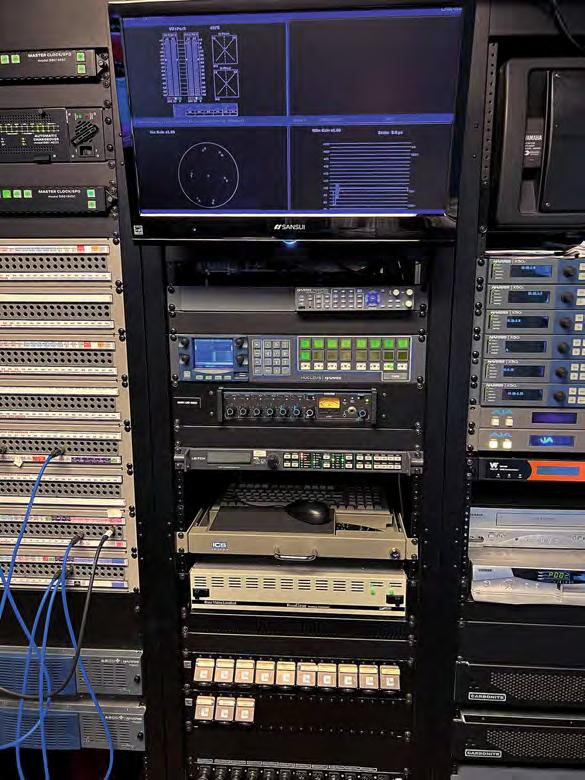

destination in our operation goes through that router and we have HD-SDI video and analogue audio p atch panels that allow us to override the router or re-configure it as needed, without moving any cables in the racks.
Even the inputs to our Ross Carbonite switchers are tied into the router. To give you an idea, in a small-to-moderate system as described above, camera 1 most likely feeds directly into the corresponding input on a video switcher. But in a large-scale system, the camera feeds into a patch panel (after first feeding the CCU directly). Its default path (when there is not a patch in place) would then feed into a distribution amplifier (DA) and a port on the back of the Ross Carbonite switcher. The DA output allows you to patch a source like camera 1 to any destination on the patch field, without disconnecting it from the Ross switcher.
TECHNOLOGY 36 WORSHIP AVL May–June 2023
Casey Hawkins looks at some of the different routing levels you might expect to find in your house of worship
GABC’s 64x64 Harris Platinum HD-SDI router
The main Harris router panel with video patchbay
Casey Hawkins
Once in the Ross switcher, then the show is produced using its multiple inputs and effects. Using the video switcher’s multi-viewer feature, we can route any switcher input to a spot on a monitor without moving a cable. We can change the layout of the multi-viewer to view different varieties of sources in different arrangements. We can also route the output of the Ross switcher to any destination in the Platinum router, such as a media recorder, a monitor, another building on-campus or to the IMAG screens, again, all without moving a single cable. That is because every destination and every source we have available goes through that Harris Platinum router. This is a very common setup in larger production facilities and television stations. All that said, that doesn’t mean that I am not in the racks occasionally to install new gear or remove old gear and then I am, of course, removing or relocating cables. However, daily and for all our services, we don’t have to move any cables. We do, however, make dozens of routes each Sunday, assigning the appropriate signals to rear confidence monitors in the Worship Center to accommodate
the worship and ministry team on the platform (stage), our large IMAG screens, media recorders, monitors, engineering stations, specific rooms in the building (such as the pastor’s office), the choir room and the hallway IMAG monitors out in the foyer of the Worship Center. At the push of a few buttons on the Harris
routing design I have ever seen or heard of. Let’s say a customer wanted to send video from Las Vegas to Washington, DC. Our then DS-3 sonnet-based network might have built that video feed like this: origin TV-1 local loop from a studio in Las Vegas as an input to a small analogue switch to a DV-45 encoder, then on
IP-based now and not DS-3s on a port-by-port switcher, but you get the idea: which is that routing can happen on a global scale, not just within your control room at your church or production studio.
So whether your setup is smaller and requires no routing once it is installed, or whether your setup is nothing but




Platinum router, we can re-route all those destinations with a different source. We even have router control panels around the control room that have limited but assignable router functions so that you don’t have to be at the main router panel to make a route.

Mega routing
I spent 13 years working for a telecoms company routing television broadcast signals all over the world and I can attest, that was the largest
reach everyone in the audience
a tie-line to a small 48-port DS-3 switcher in Las Vegas to a switch in Los Angeles, where it arrived as an input on a larger 456-port DS-3 switcher, then connected to an output of that same switcher to a DS-3 that went to Chicago on an input to another 456-port DS-3 router, then to an output that went to a 456-port DS-3 switch in Washington, DC as an input, then decoded from the DS-3 to analogue to a smaller analogue switch to a TV-1 local loop to the receiving studio. I haven’t worked there for a decade, so these feeds are all
hundreds of routers full of inputs and outputs that come from and go to other cities and states within the country and the world, routing is happening all around you.
If you currently don’t have a router for your church, I recommend working on a design that would allow you to include one. Being able to control what is feeding your IMAG screens, your LED walls, your hallway monitors, your record machines and your streaming encoder is very useful and creates for a highly functional and versatile environment.
MAUI® i 1
PASSIVE INDOOR/OUTDOOR INSTALLATION COLUMN LOUDSPEAKER
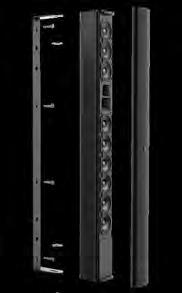
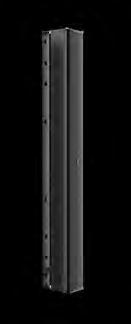
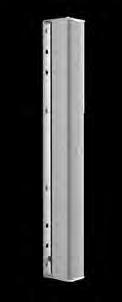
For acoustically challenging interiors where music and speech must be clearly understood, even in the rearmost rows, there is one solution - MAUI® i1.
For outdoor use, MAUI® i1 features weather treated cones, an aluminum loudspeaker grille and a weatherproof cover for the connection panel.
TECHNOLOGY
LD Systems® is a registered brand of the Adam Hall Group. DESIGNED & ENGINEERED IN GERMANY
ld-systems.com/mauii1
The main Harris router panel
Three-point lighting
Herbert Bernstädt, product specialist, light technology, research and development light at Cameo, discusses how to correctly light a subject with a common three-point lighting setup
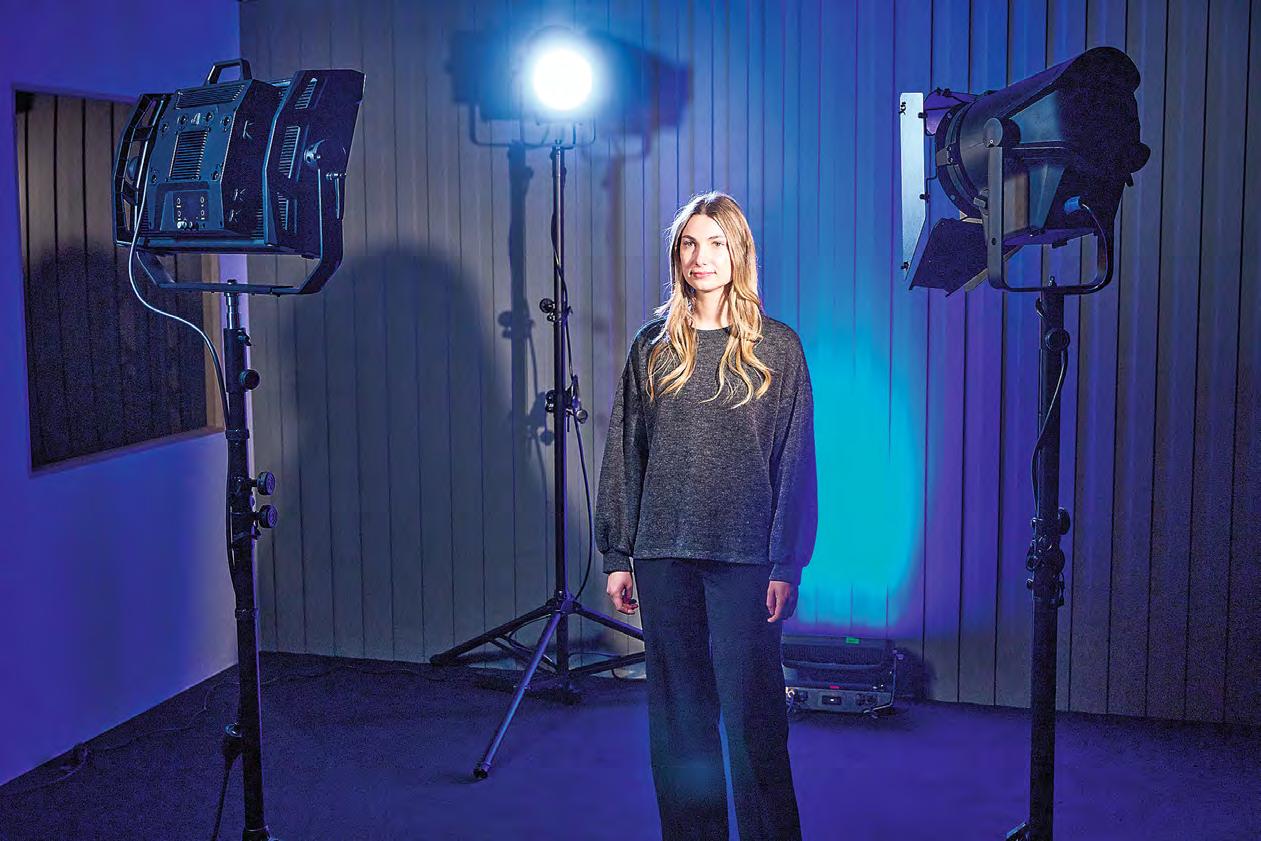

WHEN YOU’RE STREAMING your live event or church service, what makes the difference between a professional or amateur look? Is it the camera? Usually not, because nowadays you can create a fairly decent stream with a mobile phone. Most typically, it’s the light and the lighting – the way you put a person in the right light. The effect of good lighting is usually underestimated because most of what we see is registered and evaluated in the subconscious. A sympathetic or unsympathetic judgement can be made in a fraction of a second. In this article, I’d like to explain how to put a person in the right light with a common three-point lighting guide.
1. Guide light/key light
Since the beginning, humans have seen their surroundings with light from the sun. In the morning and evening, we feel most comfortable with the warm colour of light. We also take advantage of this in
TECHNOLOGY 38 WORSHIP AVL May–June 2023
Herbert Bernstädt
We now want to lighten these a little without erasing the profile created by the guide light. To do this, we use a fill light or a soft light. In contrast to the guide light, with the fill light you need a large illuminated area and
very diffuse light. With a soft light, all the shadows from the guide light are lightened and even the shadows under the strands of hair will disappear. It’s best to position the soft light on the other side of the camera at 45° so
that the guide light and soft light are at 90° and the camera between them at 45° each. In the vertical axis, you can position the light between 15° and 60°. The brightness ratio between the guide light and the fill light should be
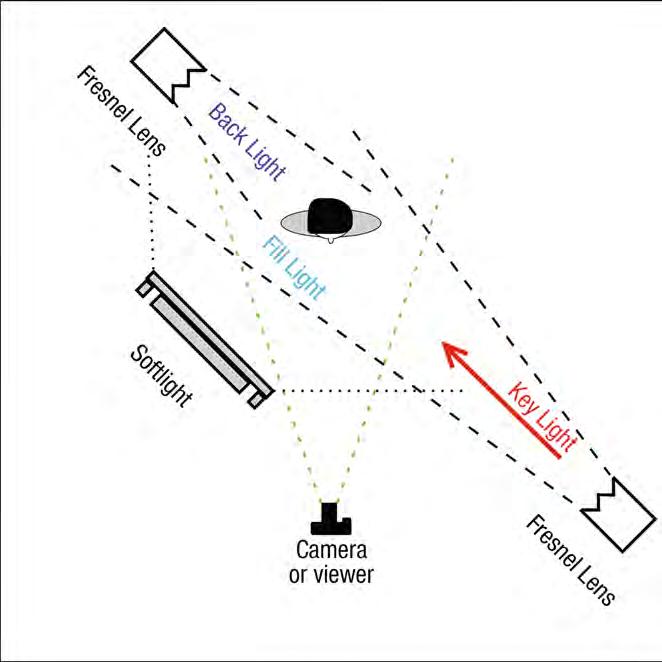
such that the shadows from the guide light disappear but the profile from the guide light is still maintained. As a general rule, one can assume 50% of the guide light or one f-stop less.
3. Back light
Now we have illuminated the person or object correctly, but the camera image is two-dimensional. To make the illuminated person stand out from the background, we resort to an optical trick. We create a corona of light around the body by illuminating it with a back light coming steeply from above. A back light, also known as a high light, is the opposite of a leading light. With this back light, the illuminated person is now detached from the background. The light intensity can be half to twice as strong as the guide light, depending on how much you want the person or object to stand out from the background.
With this simple three-point illumination technique, your productions will stand out professionally from other productions that are only using simple room lighting.


www.cameolight.com

TECHNOLOGY May–June 2023 WORSHIP AVL 39
Three-point lighting guide
Blackmagic reveals ATEM switchers and camera updates
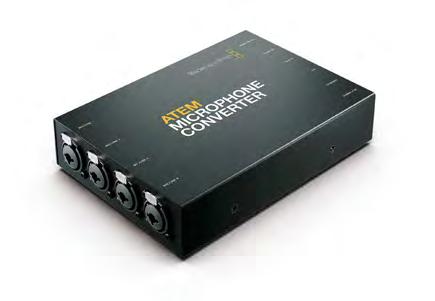
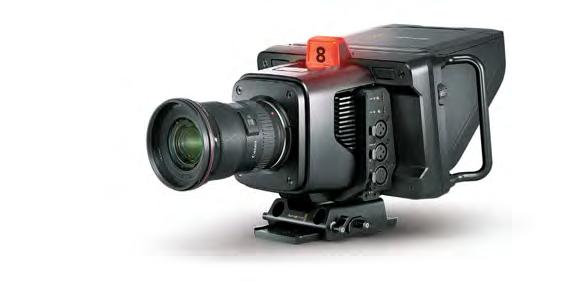
Blackmagic Design recently held a livestream to introduce a selection of new products: ATEM Television Studio HD8/HD8 ISO switchers, 6K and 4K G2 models for the manufacturer’s Studio Cameras and an ATEM Microphone Converter
THE ATEM TELEVISION STUDIO
HD8 is a professional live production switcher built into a broadcast control panel so it can be used for highend work while also being portable. The switcher comes with eight standards-converted SDI inputs, two aux outputs, four chroma keyers, two downstream keyers, SuperSource, two media players and a wide variety of transitions. Additional features include hardware streaming, recording, audio mixer, talkback, multiview and optional internal cloud storage. There’s also an ISO model that records all eight inputs for editing.
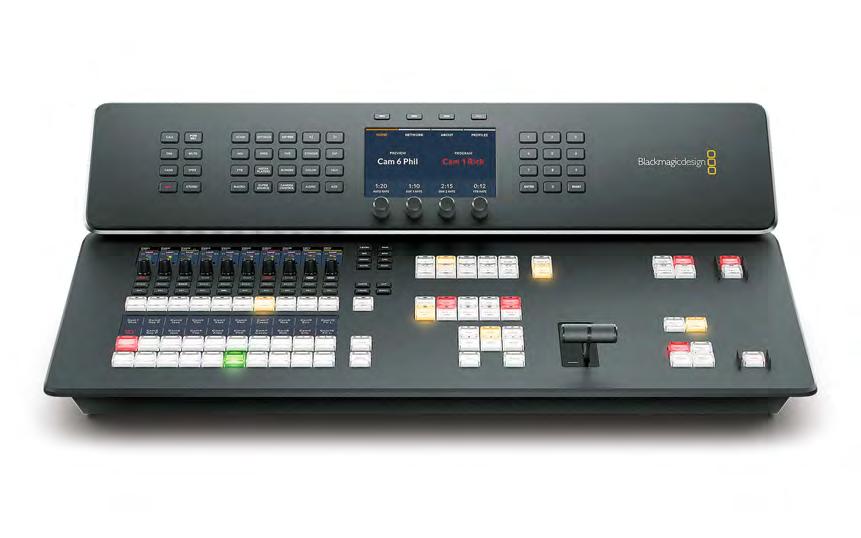
Most of the features can be accessed from the front panel, or customers can use the free ATEM Software Control on Mac or Windows. Users can select from transitions such as dissolve, or more dramatic effects such as dip to colour, DVE squeeze and DVE push. Customers can also add a DVE for picture-inpicture effects with customised graphics. There are also media players which let users store graphics with alpha channels for titles and graphics that can be used as live video inputs.
The Studio Camera 6K Pro is a more powerful version of the studio camera that features an EF lens mount, a larger 6K sensor for improved colourimetry and fine detail handling, ND filters and built-in livestreaming via Ethernet or mobile data. It shares the same compact all-in-one design of the Studio Camera family with a lightweight carbon fibre reinforced polycarbonate body, large integrated 7-inch HDR viewfinder and broadcast connections. The Studio Camera 4K Pro G2 is an updated model that also includes built-in livestreaming. Unlike consumer cameras, the Blackmagic Studio Camera 4K Pro G2 and 6K Pro models have SDI connections that include talkback so the switcher operator can communicate with cameras during live events. That means the director can talk to the camera operators to guide shot selection, eliminating the problem where all cameras could have the same shot, at the same time. The talkback connector is built into the side of the camera and supports standard five-pin XLR broadcast headsets.
The Studio Camera 6K Pro features high-quality, remote-controllable ND filters that let customers quickly reduce the amount of light entering the camera. Designed to match the colourimetry and colour science of the camera, the two-, four- and sixstop filters give customers additional latitude, even under harsh lighting. The filters are designed to filter both optical and IR wavelengths evenly, eliminating IR contamination of the images. The ND filters can be electronically controlled by the function buttons on the back of the camera. Because they can be controlled remotely by the camera control operator, the camera operator is free to focus on getting the perfect shot.
Finally, the ATEM Microphone Converter is an audio analogue-todigital converter (ADC) that lets users add additional microphones to ATEM switcher models such as the ATEM Television Studio HD8. Featuring a MADI connection, it means customers don’t have to configure any complex settings because the connection is a simple BNC cable. The design features a low noise floor
of –129dBV, a dynamic range of 131dB(A), low distortion of 0.002% and uniform tolerances across all channels. The design also features an HDMI monitoring output with scrolling waveform displays.
The ATEM Microphone Converter plugs into the ATEM Television Studio MADI port, so there’s no complex setup required, and additional units can be daisy-chained for more sources. Each converter has four analogue inputs that are mic/line selectable and have 48V phantom power. The design uses eight separate ADCs on each separate input that work together to extend the dynamic range. There is also an HDMI monitoring output with scrolling audio waveforms. The converter features combined XLR/TRS input sockets, allowing both XLR or jack cables to be connected. It also includes a MADI output with the converted audio, as well as a MADI input which allows multiple ATEM Microphone Converters to be daisy-chained so more than four channels of audio can be embedded into a single MADI connection.
www.blackmagicdesign.com
40 WORSHIP AVL May–June 2023
PRODUCT SPOTLIGHT
Studio Camera 6K Pro Lens
ATEM Microphone Converter
ATEM Television Studio HD8
INNOVATION AND IMMERSION THAT SPEAKS VOLUMES
Take your mixing to the next level with KLANG. Designed to provide musicians with a natural in-ear monitor mix. KLANG:kontroller offers musicians full control of their mix and is packed with distinctive
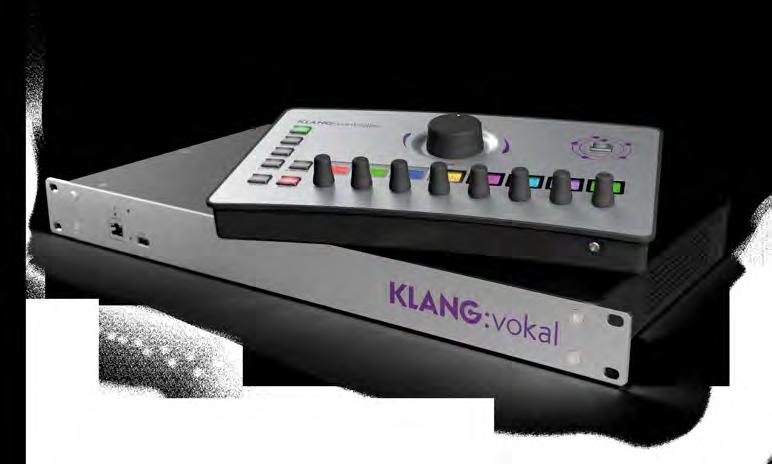
Immersive Personal mixing with tactile control

Dante connectivity/power over ethernet
Easy installation/integration
# SETTINGTHETONE
Scan to hear more
It’s where you want to be
Where Asia’s audiovisual professionals meet. Learn from one another. Discover what’s new. Reignite the spark that drives their business. At InfoComm Asia.



- Meet
and distributors from all over the world.
- Discover the latest in products, technologies and solutions.

- Gain educational opportunities with invaluable insights at Asia AV Leaders
Connect - keynote by Dave Labuskes, CEO, AVIXA on ‘Global Pro AV Market Trends in the Next 3-5 Years’.
- Boost your technical expertise with dedicated AV Training sessions
- Network and connect with peers from the Asia Pacific region, exchange ideas and discuss collaboration.
Organized by: A Project of:
See Summit Program Scan to Register Discover Solutions from Exhibitors
24 - 26 May 2023
Queen Sirikit National Convention Centre (QSNCC), Hall 3 & 4, Bangkok, Thailand
www.infocomm-asia.com
 Professional AudioVisual manufacturers
Professional AudioVisual manufacturers
punQtum provides digital solutions on a
single wire
punQtum solutions include beltpacks, headsets and speaker stations and support multiple communication channels along a single wire
PUNQTUM BY Riedel offers a plugand-play digital intercom system with a variety of communication channels on a single wire. Described as easy to install, easy to use and reliable, punQtum solutions include standalone beltpacks, headsets and speaker stations. The products can be integrated with existing systems via an IP switch, giving venues the flexibility to extend and customise existing systems on a budget. punQtum supports multiple communication channels along a single wire, which makes it easy for groups of people to communicate with each other exclusively, such as FOH or lighting crew, eliminating crossed lines of communication and minimising miscommunications during live performances or broadcasts. The system works straight out of the box, with default settings that can be quickly configured by a user-friendly software interface. Furthermore,
these user-friendly systems are backed by the expertise of the Riedel brand.
The Q110 beltpack is at the heart of the punQtum solution. It offers two channels of IP-partyline intercom with power supplied via a standard PoE switch. Designed from quality, durable materials, each beltpack can be daisy-chained up to eight times. In terms of scalability, the Q110 reportedly suits systems of any size, ranging from small events requiring just two beltpacks to however many are required for large, complex systems. No master station is required and the beltpack supports industry-standard headsets. It reportedly works with any IP switch and users can talk or listen to any two out of 32 partylines, choose one out of four program inputs and operate four out of 32 GPIO outputs.
The Q210 P speaker station provides increased control, with
four channels of communication, programmable buttons and the ability to trigger logic outputs. All functionality is designed to be instantly accessible thanks to ergonomically designed buttons and an easy-to-read colour display. The feature set also allows for any missed comms to be replayed in a “voice-mail”-style setup. The speaker station is equipped with a four-port network switch. Two of the ports are rated to provide POE+ power and every POE+ capable port can power up to four wired beltpacks. Features also include a microphone and headset connector, etherCON connectors, GPI inputs and outputs, analogue inputs and outputs, two public address outputs and two program signal outputs. Both single-ear and dual-ear headsets complete the offering, alongside punQtum’s own Q-Tool Configuration Software, which allows users to adjust the system to their
needs without any complicated features, even in complex production environments. Users can change the default configuration of the system; define roles; name partylines, public addresses and GP outputs; configure external audio inputs and outputs into the system, manage the program feed and audio stream; and add password protection.
The Q910 single-ear and Q920 dual-ear are lightweight intercom headsets with a dynamic microphone, XLR-4f connector and 1.5m cable length. Using AES67 as a solid technology cornerstone, the punQtum Intercom system integrates seamlessly with AES67compliant networks such as Dante and Ravenna. Furthermore, punQtum will shortly release a multiplatform editing software for easy configuration and management of systems.
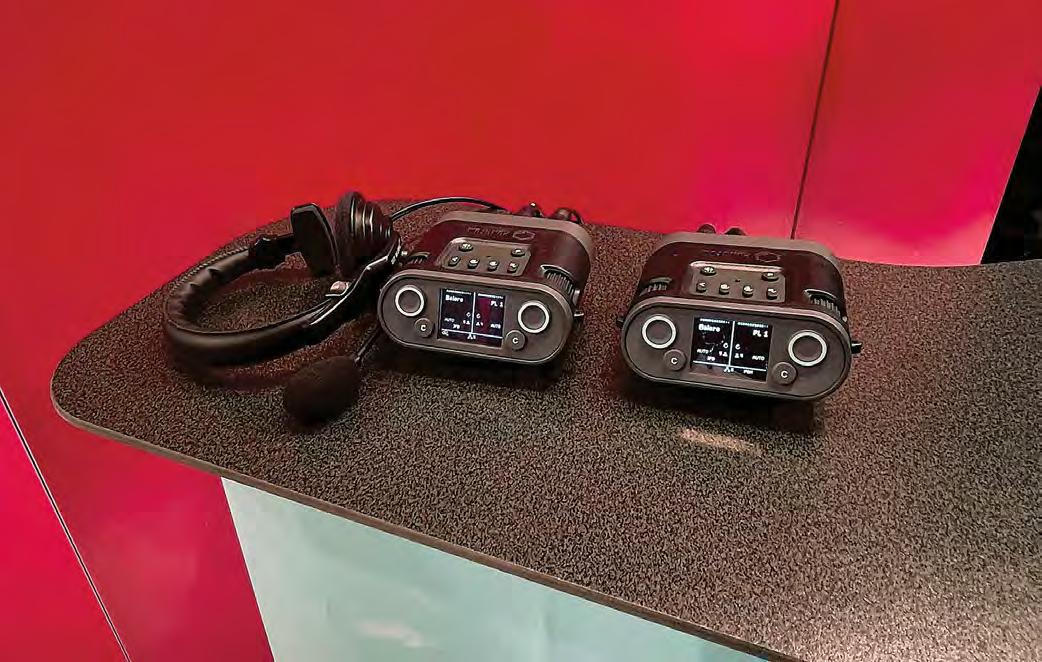
May–June 2023 WORSHIP AVL 43
www.punqtum.com A–ZCONTENTS XLPRO Series 50 BC543 / BC272 47 Midra 4K v3.0 54 Atmosphere AZMP4 52 AT8700 / ATS99 48 Cyris CX6 and C210S 47 Titan v16.0 / T3 54 Domino Wash 56 CR-N700 update 53 Ovation CYC 3 FC 55 V600:4 47 KF210 46 KL Panel XL 57 Vortex / Cosmic Burst 57 LightShark LS CORE iO 56 Hippotizer v4.8 54 TNA Active Line Array 44 GY-HC500UN 52 KOS 5.3 49 ESD8 / ESR106 46 L-ISA Studio 2.5 49 M2Ra 49 Magma Fog 1500 IP 53 Nebra 50 Obsidian Control Systems NX P / NX K 57 Pioneer DJ XPRS2 Series 46 Powersoft ArmoníaPlus v2.5 50 punQtum Q110 43 RCF Compact C 32 and C 45 44 RØDE NT-USB+ 48 Sony SRG-A40 53 Williams AV WAV Pro Wi-Fi Receiver 52 NEWPRODUCTS AUDIO • VIDEO • LIGHTING
Q110 beltpacks
RCF doubles up on two-ways
ITALIAN AUDIO
RCF has introduced a pair of multipurpose two-way point source speakers.
The Compact C 32 and Compact C 45 speakers both have lightweight wood cabinets which use a special polyurea coating and feature a robust powder-coated grille with protective foam. Both also feature mounting accessories to allow for wall or ceiling installation.
The Compact Series’ compression driver voice coil design has a titanium dome which RCF says allows it to lower the usual crossover point for better vocal performance at mid-frequencies, as well as improving coupling with the lowfrequency transducer. Meanwhile, its low-frequency transducer design gains more stability over higher currents, with less distortion and is said to be highly efficient in terms of heat dissipation.
The C 32 has a 3-inch neodymium compression driver (4-inch on the C 45) and a 12-inch neodymium woofer (15-inch on the C 45).
A constant directivity rotatable waveguide produces coherent 100° x 50° coverage with a 137dB max SPL on the C 32 and 138dB on the C 45. The C 32 features 600W RMS power handling, while the C 45 increases this to 700W. Both units are designed to perform in a wide range of near and middistance applications.
The manufacturer has also launched two ranges of power amplifiers: a range of three twochannel amplifiers and a pair of four-channel amplifiers. All five are rackmountable in 2U of space.
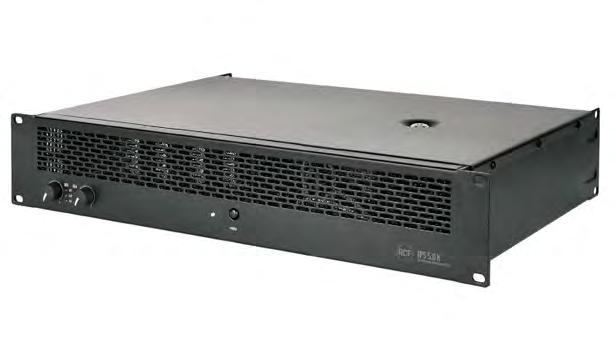
The IPS Series features twochannel Class-H amplifiers with
HH Electronics launches TNA system
THE TNA Active Line Array from UK-based HH Electronics is a modular system designed for smallto medium-sized applications. At the heart of the system are the TNA-2120SA, a multichannel active subwoofer with an integrated Class-D amp and two 12-inch low-frequency woofers, and the TNA-1800SA, a single 18-inch active low-frequency subwoofer.
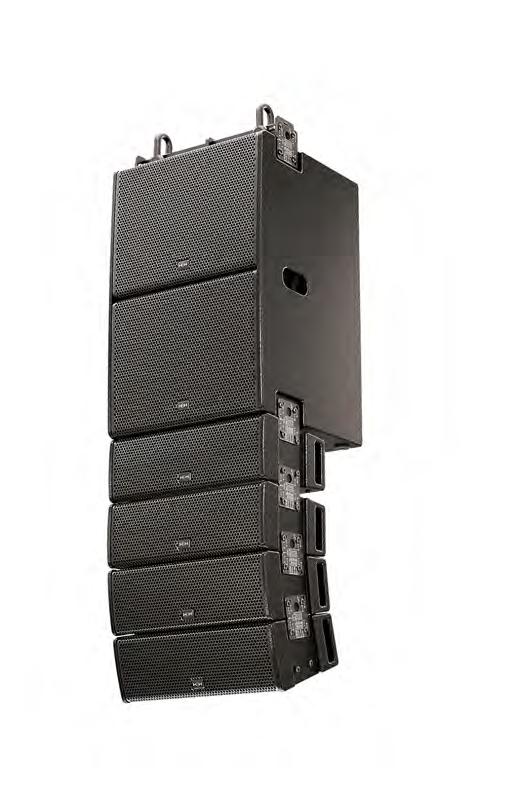
As well as three channels of amplification, the TNA-2120SA unit houses six optimally voiced, built-in DSP presets. These allow a complete system to be used in flown or ground-stacked configurations, while its integrated rigging hardware and optional suspension bracket and dolly board allow for straightforward installation.
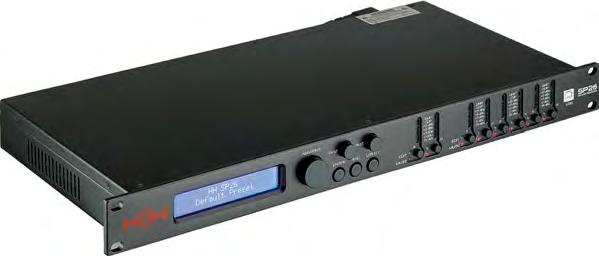
XLR input and output link, a mono/ stereo/bridge switch, as well as speakON and binding post output connectors. For reliability, RCF claims that all units in the range are protected against shorts and open circuits, and all feature highefficiency heat sinks and variable speed fans. The series consists of the IPS 1.5K (2x750W @ 4Ω), the IPS 2.5K (2x1,250W @ 4Ω) and the IPS 5.0K (2x2,600W @ 4Ω). Meanwhile, RCF’s QPS Series is a range of four-channel Class-HD amplifiers which all feature independent gain control, signal/ clip and fault indicators, channels A and C XLR output link, parallel/ bridge modes and speakON output connectors. Like the IPS Series, the QPS range includes the same protection circuits and variable speed cooling. The series consists of the QPS 6.0K which delivers up to 4x1,500W @ 2Ω and the QPS 10K which delivers up to 4x2,500W @ 2Ω.
It is capable of powering up to six satellite TNA-2051 passive two-way line array loudspeakers offering an installation solution without the extra expense of rack amplifiers and processors.
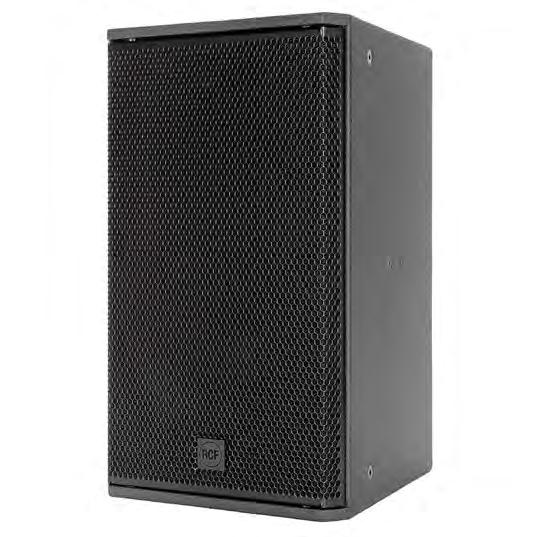
The TNA-2051 features dual 5-inch LF drivers and a 1.33-inch Celestion HF compression driver. Its outer
enabling the unit to be installed by a single engineer. The TNA-2051 can be used in traditional line array systems for long throw applications, or as a standalone fullrange point source system.
The manufacturer has also announced the launch of its SP26 and SP48 digital loudspeaker management systems. Designed for a wide range of applications, both units are pre-loaded with presets for use with HH Electronic’s TNA line array system, and also have integrated controls for local setup as well as a dedicated PC control interface for remote monitoring and configuration via USB or RS-485.
The SP26 comes with two analogue inputs and six analogue outputs. Each input channel provides parametric EQ, gain control,
dynamic low boost, noise gate, RMS compressor, internal white/pink noise generator and configurable delay. Each output offers up to seven parametric EQ and crossover filters.
For applications requiring more I/O, the SP48 provides four analogue inputs and eight analogue outputs. Each input channel provides a 30-band parametric EQ, gain control, noise gate, RMS compressor and configurable delay. Similarly, each output offers up to seven parametric EQ and crossover filters, with each output path featuring peak limiter, HP/LP filters and driver alignment delay. In addition, the SP48 supports a full matrix mixing mode where inputs may be routed/mixed in any ratio to any output.
44 WORSHIP AVL May–June 2023 PRODUCTS
Compact C 32
www.hhelectronics.com
SP26
TNA-2120SA and TNA-2051 flown
OUR RELIABILI

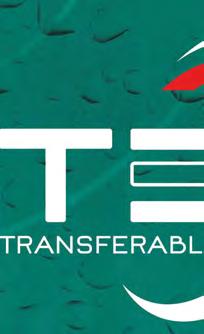
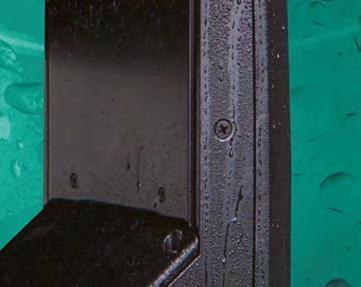
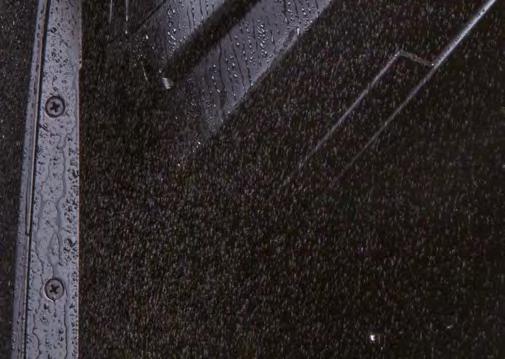



IN ALL WEATHERS



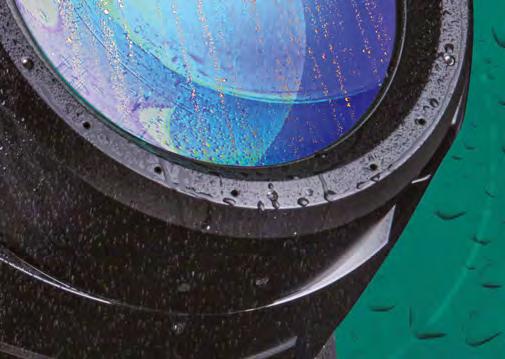




EAW unveils medium-format line array

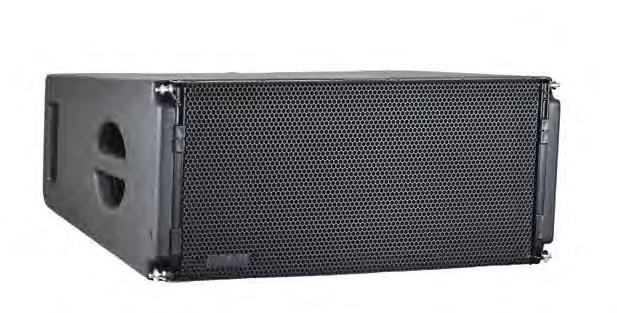
EASTERN ACOUSTIC Works has unveiled the KF210 two-way dual 10-inch line array cabinet. Offering a max SPL of 141dB, in addition to three-point rigging and built-in weather protection, the KF210 is mediumformat passive line array designed to support a wide range of applications. Despite its diminutive form, the manufacturer states there has been no sacrifice on output. Weighing approximately 27kg, the KF210 is a suitable option for small crews

operating out of medium or large houses of worship. The cabinet houses
KV2 Audio reinforces ESD and ESR ranges
KV2 HAS expanded its range of twoand three-way passive loudspeakers with the introduction of the ESD8 loudspeaker. The ESD8 is a compact, passive, two-way, high-output, fullrange loudspeaker which incorporates an 8-inch trans-coil woofer and a 1-inch compression driver coupled to a wide dispersion horn. Designed to present “exceptional” speech and music definition, the ESD8 can be used as either a main system speaker or as an in-fill for larger systems.
It can be set up on podiums, stands or suspended. KV2 reports that when combined with subwoofers – of which there are four to choose from in the ESD range – the ESD8 offers a highquality, full-range performance. The ESD family of loudspeakers ranges from the ultra-compact ESD Cube right through to the more powerful ESD15 and ESD36.
The manufacturer has also announced two additions to its ESR Series in the form of the ESR106 and its dedicated ESR2600D amplifier based on the manufacturer’s proprietary SLA technology. Like its siblings, the slimline ESR106 is an active-driven three-way system. It deploys a column array of multiple 6-inch woofers for high-quality vocal and music reproduction in challenging acoustical spaces and ambient environments. Utilising eight 6-inch woofers, two 6-inch mid-bass woofers and a single 1-inch high-frequency driver mounted on a wide dispersion horn, the ESR106 is constructed to represent one large point source, with each part of the system positioned so that it is proportional in size to the wavelength it produces, meaning that the radiated power of each band remains consistent and balanced throughout the system’s overall
ESD8
frequency range. The ESR106 has a controlled coverage at low and mid frequencies to reduce indoor reflections. The discreet, low-profile cabinet incorporates multiple fixing points for external brackets and flyware. However, unlike its siblings, the ESR106 may only be used vertically.
The ESR106 is controlled and driven by its dedicated ESR2600D amplifier, a two-channel (stereo) three-way, active control and amplification system housing all signal processing and amplification in a 4U module, as well as providing control and crossover functions for adding external subwoofer cabinets if required, utilising external amplifiers. In stereo mode, the ESR2600D powers two ESR106s and is configurable via the front panel or remotely using the KV2 Control & Diagnostics Tool. www.kv2audio.com
dual, symmetrically placed 10-inch woofers, delivering 90° horizontal
bandwidth, and a 3-inch voice coil compression driver mounted to the manufacturer’s patented Isophasic waveguide. Frequency response is 55Hz–18kHz.
The heavy-duty polyuria epoxy protects the cabinet’s Baltic birch wood construction from visible wear, while its IP55 rating means the KF210 can handle damp, dusty and wet weather conditions.
www.eaw.com
Pioneer DJ introduces XPRS2 Series
FOLLOWING IN the footsteps of the original XPRS Series, Pioneer DJ has added two active speakers and two active subwoofers suitable for houses of worship in both rental and fixed installations. The XPRS102 and XPRS122 full-range speakers feature Class-D 2,000W amplification, while the XPRS1152S and XPRS1182S subwoofers offer Class-D 4,000W amplification. Enclosed in black, protective plywood cabinets and suitable for harsh outdoor and indoor environments, the models come with a durable handle to support system portability and handling during setup and tear down. The XPRS2 Series also features rubber feet to create separation and shock absorption between surfaces.
The XPRS102 and XPRS122 contain four different DSP preset modes – Live, Music, Speech and Floor Monitor – to address the needs of different listening environments. Each full-range speaker also includes 16 custom user DSP modes – which can be saved with different names – so that EQ settings can be maximised for every scenario. The XPRS102 pairs a 10-inch woofer and
2.5-inch voice coil with a 1-inch exit compression driver and 1.75inch voice coil. It has a maximum SPL of 129dB and a frequency response of 50Hz–20kHz. The XPRS122 is the larger counterpart. Featuring a 12-inch woofer and 3-inch voice coil with a 1-inch exit compression driver and 1.75-inch voice coil, the XPRS122 boasts a frequency response of 48Hz–20kHz and a maximum SPL of 131dB.
The XPRS1152S and XPRS1182S contain three different DSP preset modes – Boost, Extended LF and Normal – to suit different listening environments.
The XPRS1152S employs a 15-inch ferrite woofer with a 3-inch voice coil with long excursion, while the larger XPRS1182S relies on an 18-inch ferrite woofer with a 3-inch voice coil with long excursion to produce accurate low frequencies. The XPRS1152S provides a frequency response of 45–120Hz and a maximum SPL of 129dB, while the XPRS1182S offers a 40–120Hz frequency response and 130dB maximum SPL.
www.pioneerdj.com
46 WORSHIP AVL May–June 2023 PRODUCTS
XPRS102
Compact Cyris gives more from less
A COMPACT loudspeaker series has been announced by Belgian manufacturer Audiofocus. The first two models are the Cyris CX6 coaxial 6-inch and companion C210S lowprofile double 10-inch subwoofer.
The Cyris CX6 delivers a peak SPL of 122.4dB in a compact format optimised for short-throw fixed installations or live events. It can also serve as a fill cabinet in larger settings. According to the
manufacturer, its naturally cardioid design allows it to be positioned close to walls or corners without reflection problems, while a flared vent manages low-frequency distortion. A mic stand insert and optional U bracket allow the cabinet to be deployed according to varying venue needs.
The C210S is a dual-vented bandpass subwoofer, housing a pair of 10-inch neodymium LF transducers that employ Tetracoil technology,
Alcons keeps the outputs high
FOR USE in both permanent and portable applications, the BC543 from Alcons is a self-contained, cardioidcontrol subwoofer system designed to be a low-frequency extension for any Alcons pro-ribbon system. Its frontand rear-located woofer configuration, in combination with integrated processing, offers selectable cardioid low-frequency pattern control that
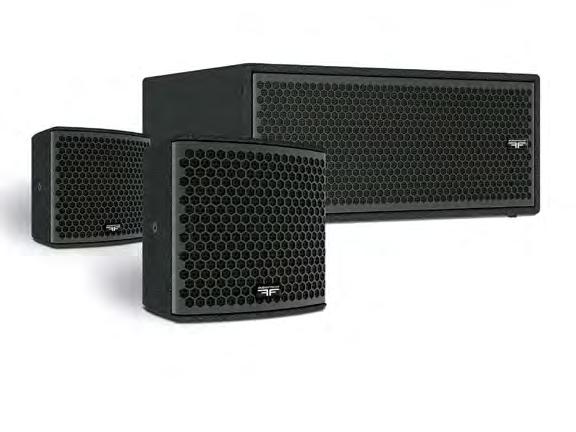
boasts rear rejection up to 42dB. The front drivers include a pair of 18-inch long-excursion woofers with 5.3-inch voice coils and vented triple-spider frame mounted in a direct-radiating configuration. Occupying more than 25% of the baffle surface, this port is designed to maximise the system’s breathing capacity while minimising port compression. The excursion
BC543
capabilities of the 18-inch design extends the output by 3.5dB compared to a traditional 18-inch unit. At the rear, the BC543 has a single 18-inch long-excursion woofer with 5.3-inch voice coil and folded port design said to enable optimal reflex-breathing, under minimal baffle dimensions. The BC543 is powered and controlled by Alcons’ ALC amplified loudspeaker controller, which offers system-specific drive processing with dedicated optimisation, power and excursion protection, and hybrid filtering. Aiming to boost performance while reducing physical size, the Alcons BC272 cardioid sub is a selfcontained, medium-output cardioid subwoofer system for both permanent and portable ground-stacked applications. Designed to offer a tight and accurate sub-bass response for low-frequency extension of any Alcons pro-ribbon system, the BC272 is the
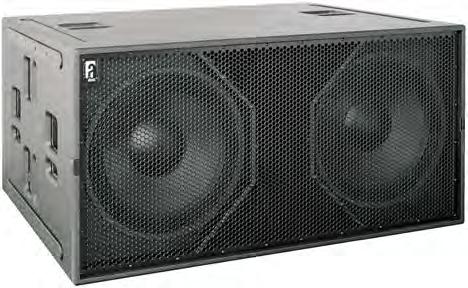
most compact self-contained cardioid in Alcons’ range. Its front- and rearlocated woofer configuration, along with dedicated processing, means the system can offer selectable cardioid low-frequency pattern control with up to 42dB of rearward rejection without the need for additional cabinets. This is achieved by using a biamp power configuration in the amplified loudspeaker controller, so dual-DSP channels are available for dedicated processing.
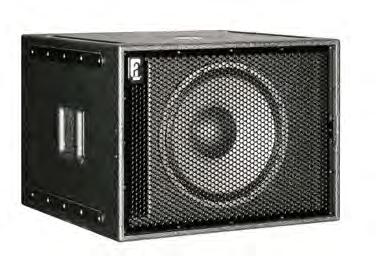
www.alconsaudio.com
Dynacord reveals first member of new amplifier series
DYNACORD HAS created its V600:4 multichannel power amplifier for small and mid-sized installations. It has a total power of 600W and a compact 1U form factor, along with multiple power drive options using Dynacord’s patented VLD (Variable Load Drive) technology. It allows the amplifier channels to be driven in 4Ω, 8Ω, 70V or 100V, without compromising the available output power.
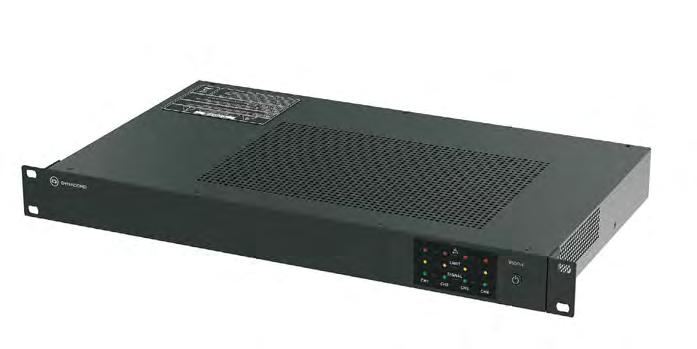
The newly developed Dynacord powerTANK technology is said to add even more installation flexibility, working like a power reservoir for the amplifier. With direct access to the 600W of power, the V600:4 can deliver asymmetric power across all channels (up to 300W per single channel) as needed. There is reportedly no waste of
energy, which promotes greater
ecoRAIL. This technology delivers
signal is detected, auto wake-up will immediately enable the amplifier to be fully operational.
The V600:4 also incorporates Dynacord’s new dualCOOL technology. Designed as a convection-cooled power amplifier, the device operates silently, making the V600:4 also suitable for installations in quiet environments. Thanks to dualCOOL, a built-in multi-stage fan is activated under extreme thermal conditions, preventing the device from limiting while maintaining full operation, even at temperatures of up to 45°C.
loudspeakers in a small zone such as a kitchen area as well as for larger loudspeakers with up to 300W such as in an auditorium.
Overall power consumption can be significantly reduced thanks to
background music. APD (Auto Power Down) contributes to further optimise efficiency, reducing energy consumption by automatically powering down the amplifier when no audio signal is present. As soon as a
Power Factor Correction (PFC) for the power supply has also been added for unstable power conditions with large voltage swings.
www.dynacord.com
May–June 2023 WORSHIP AVL 47 PRODUCTS
BC272
RØDE covers all the bases
WITH A wide range of applications, the NT-USB+ from RØDE is a professional-grade USB microphone designed for recording directly into a computer, tablet or mobile device. It features a condenser capsule with a tight cardioid pickup pattern for focused recording and has USB-C plug-and-play connectivity, while a zero-latency 3.5mm headphone output offers dedicated volume and mix controls for monitoring.
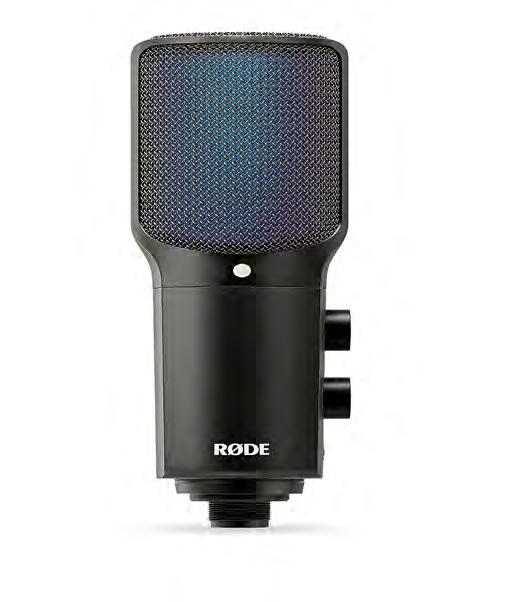
The NT-USB+ also features internal DSP to enable additional audio processing. This can be unlocked with RØDE’s Connect podcasting and streaming software, the RØDE Central companion app for desktop and mobile, RØDE Reporter or Unify. With an integral pop filter and desktop stand, the NT-USB+ is designed for recording vocals, instruments, podcasting and streaming.
Designed for on-the-go content creators, RØDE has upgraded pointed at while reducing background

Audio-Technica goes boom with the AT8700
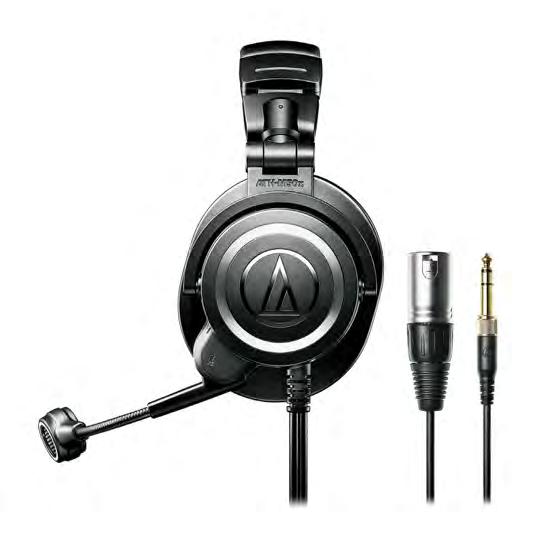

ORIGINALLY DESIGNED for its 20 Series microphones for use in podcasting, streaming and content creation, Audio-Technica is expanding its reach with the AT8700 boom arm. With a 5⁄8 -inch-27 thread and heavy-duty suspension allowing 360° rotation, the table-mounted arm accepts microphones from a wide variety of manufacturers. This means users can attach their favourite mics to add versatility to any recording or streaming setup and free up space. The unit comes standard with six USB cable clips, six XLR cable clips
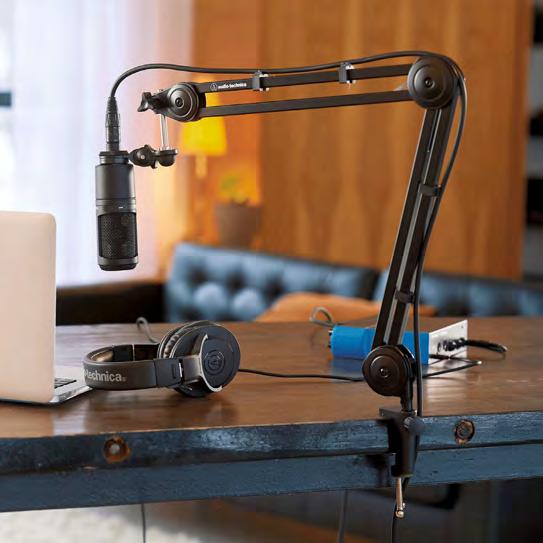
and a table clamp, and folds for easy transportation.
Designed for vocalists onstage, Audio-Technica has also announced the launch of its ATS99 hypercardioid dynamic microphone. The manufacturer reports the ATS99 has been engineered for responsiveness and fast transient delivery, with particularly enhanced capture of lowto midrange sounds at high volume, which allows singers to perform across a broad frequency range.
The company claims that a combination of the ATS99’s high-
redesigned, utilising
transparency, while the circuitry has also been overhauled to provide enhanced sensitivity and
The mic introduces RØDE’s HELIX isolation mount, a shockmount system developed specifically for the VideoMicro II and crafted to the exact specifications of the microphone. Moulded from a single piece of Hytrel, it fully isolates the capsule from vibrations that occur from knocks, bumps and general handling, which can result in rumbles and other audio artefacts in a recording. It features cable management slots and a standard mount for attaching to a camera cold shoe,
accessories. The VideoMicro II also comes with foam and furry windshields for protection from wind noise, making it suitable for recording in a wide range of environments, indoors or in the elements. Also included is a 3.5mm TRS-to-TRS cable for connecting to cameras and a 3.5mm TRSto-TRRS cable for connecting to
the world’s first headsets specifically developed to address the needs of livestreaming content creators. The ATH-M50xSTS and ATH-M50xSTSUSB StreamSet are equipped with the same 45mm large-aperture drivers and incorporate technology from the company’s 20 Series microphones. The headsets are designed to deliver full-spectrum, studio-quality sound for users and listeners on the receiving end. They come with two sets of distinct earpads: M50x earpads that stress audio quality and sound isolation, and mesh and leatherette earpads that emphasise breathability and comfort.
Both models use a cardioid condenser capsule on a flexible background noise. The headsets’ flipping the boom arm into the up position.
The ATH-M50xSTS uses a 2m cable with 3.5mm headphone input (with a 6.3mm adapter) and an XLR microphone output. The ATHM50xSTS-USB uses a 2m cable with a USB-A connection (with a USB-A to USB-C adapter) for plug-and-play connectivity to PCs and Macs. The ATH-M50xSTS-USB also includes an A/D converter with a sample rate up to 24-bit/96kHz and sidetone circuitry that lets vocals be heard in the headset (with volume controlled by a dial on the earcup) for a more natural, conversational feel.
PRODUCTS
www.audio-technica.com
NT-USB+ II
VideoMicro
AT8700
ATH-M50xSTS
Lectrosonics ups the game with M2Ra
THE M2RA digital wireless monitor receiver from Lectrosonics expands the M2 Duet digital wireless IEM family with improvements and new features. The M2Ra receiver is a successor to the M2R and has a low latency of 1.6ms.
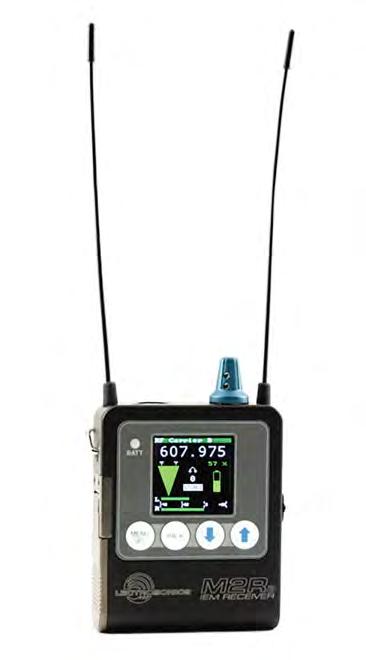
The transmitter and receiver housings are all-metal for durability, and both analogue and Dante digital signal sources are supported. The unit also introduces several key new features, including phantom power protection on the headphone jack so that the receiver can be safely used as a camera hop receiver and improved IFB analogue compatibility. Its internal power supply allows for headphones or earphones with impedances as low as 9Ω to be used.
Decreased overall RF noise floor and less RF gain in the front end reduce overloads from strong interference sources and out-of-band signals. Meanwhile, the increased IP3 and 1dB RF compression points are said to provide improved handling of high signal levels.
L-Acoustics finds space in Windows
The M2Ra also provides D2 and HDM mono digital compatibility modes so that it can be used as a small portable receiver or monitor device with mono digital transmitters from the D Squared product line. With an integral USB jack for firmware updates, users can also update their units in
Two versions of the M2Ra receiver are available: one covering the A1B1 frequency range (470–614MHz) and one covering the B1C1 frequency range (537–691MHz). This allows a e selection of operating frequencies for larger systems and helps avoid interference, even in crowded RF environments.
Another key feature of the Duet system is the Flexlist, allowing users to build a list, by name, of up to 24 feeds. With the Flexlist function, users can easily browse these feeds on an M2Ra, providing an important tool for monitor engineers and location sound mixers.
www.lectrosonics.com
L-ACOUSTICS HAS expanded access to spatial audio with the launch of L-ISA Studio 2.5, an object-based audio mixing tool designed for use with both Windows and macOS computers. The L-ISA Studio 2.5 release on Windows includes both the L-ISA Controller and L-ISA Processor Desktop applications
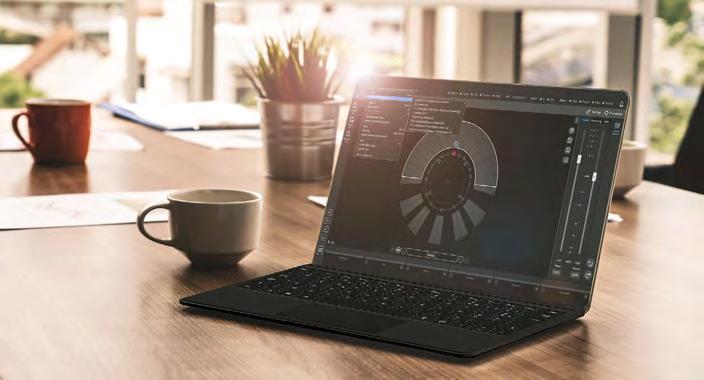
for immersive loudspeaker configurations.

Additional enhancements include graphical updates to the L-ISA Controller, freeing up additional screen real estate. Creators can now also load standard loudspeaker templates for configurations in Atmos, BluSpace and more. Preproduction
a custom virtual sound card for Windows. The Audio Bridge includes both Bridge Out and Device Out pathways for audio output. The Bridge Out allows 12 outputs to be sent through any DAW for multichannel recording, while simultaneous Device Out allows audio to be sent to either headphones or a multichannel sound card for rendering
KLANG’s KOS 5.3 heads offline
KLANG’S LATEST software version 5.3 introduces a flexible offline editor and simulator. This enables users to prepare a show remotely without requiring access to KLANG processor hardware. Built into the KLANG:app, the offline editor emulates any existing KLANG processor from the smallest :vier to the flagship :conductor, including network communication for DiGiCo SD and Quantum console integration, as well as to connect other KLANG:apps or the personal mixer :kontroller on a local network. The offline editor also offers full compatibility with DiGiCo consoles’ offline editor, making it possible to set up the console remotely without having a console and KLANG processor on hand.
KOS 5.3 also offers improved Remote Management, adding an extra layer of security to the KLANG system. Administrators are now able to fully restrict access to the system with password protection, and help musicians to connect and
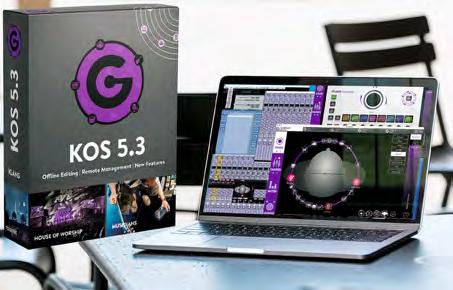
configure their :apps remotely. In addition, musicians can be locked to their mix to prevent them from changing another mix. Users can also hide and protect certain channels – such as a talkback channel – that should be audible
speaker muting and the ability to snap objects to specific active or muted speakers, which facilitates previewing different loudspeaker configurations in diverse spaces. The free version of L-ISA Studio 2.5 with binaural capability can be downloaded from the L-Acoustics website.
www.l-acoustics.com
in the musician’s mix, but only be controlled by an engineer. Hiding channels also helps to maintain a clean channel list for all musicians, for example when working with the :kontroller interface.
Another feature of the update includes the ability to sort and search through all KLANG devices found on the network and indicate which devices need attention. Also, the workflow to collect Logs has also been improved. The KLANG:app now collects all Logs of all devices, and even other :apps on the network, to get a detailed overview of the system with just one push of a button.
www.klang.com
May–June 2023 WORSHIP AVL 49 PRODUCTS
Drag and drop with Meyer Sound’s Nebra
MEYER SOUND’S Nebra is a software platform that aims to simplify the monitoring of complex networked audio systems using a graphical UI. Nebra is focused on connectivity for endpoints in Milan AVB networks, such as Meyer Sound’s Panther line array, ULTRA-X series loudspeakers and the USW-112P subwoofer. The platform also provides comprehensive system monitoring directly via the AVB network or through the existing RMS network via an RMServer. Furthermore, Nebra provides connectivity for Meyer’s Galileo Galaxy network platform and
AES67 support with ArmoníaPlus v2.5

for third-party network devices using the Milan protocol.
System health information is collected from all connected devices, with sensor data combined from multiple sources and displayed in one summary. A traffic light indicator displays overall system status, while critical system messages are displayed as banner alerts. Certified by the Avnu Alliance, the platform is available for Windows and Mac operating systems as a free download from the Meyer Sound website.
www.meyersound.com
VERSION 2.5 of Powersoft’s ArmoníaPlus software adds support for its Mezzo A+ and Duecanali/ Quattrocanali DSP+ amplifiers. The A+ range of models are the latest additions to the company’s Mezzo range. They offer the same remote control and monitoring functions as the A versions, but further extend networking capabilities with the addition of AES67. Similarly, Duecanali DSP+ and Quattrocanali DSP+ are AES67-compatible versions of the fixed-install amplifier platforms. The ArmoníaPlus update gives users the ability to design systems with the Mezzo A+ models and convert and share any kind of signal, including Dante, via AES67. In addition, v2.5 enables ArmoníaPlus to configure Dynamic Music Distribution (DMD) sources to receive an AES67 stream.
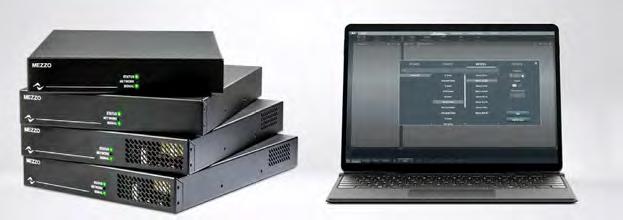
Accu-Cable guaranteed for life
Said to be four times more powerful than the existing Pixie Driver 2000, ADJ’s Pixie Driver 8000 model features eight independent output ports for connecting Pixie Strip fixtures using the system’s proprietary four-pin combined power and data connections. Each port is capable of driving up to 1,020 pixels of Pixie Strip fixtures using the KlingNet, Art-Net or sACN protocols. This means that up to 34 Pixie Strip 30s, 17 Pixie Strip 60s or eight Pixie Strip 120s can be connected to each port.
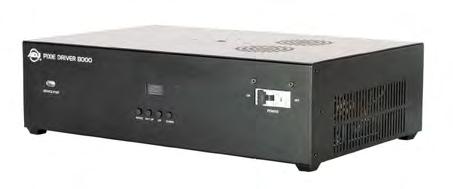
DMD gives Powersoft customers the ability to dynamically route music and other signal sources between different zones and across multiple amplifiers independently of source location and without the need for a centralised DSP. DMD systems also benefit from a Priority Input feature, which allows users to configure a GPI port to play a specific input to one or more zones by applying a differential voltage or closing a contact. The function is useful for passing an advertisement or voice alert that must be played by the whole system without having to manually change the source. Other features include an update to the embedded speaker preset and an updated version of the Sys Control app for iOS and Android.
www.powersoft.com
fixtures and chosen control protocol as well as providing access to manual RGB mode, which is suitable for testing, and internal programs that allow for standalone operation without the need for an external control system. The front panel is also home to a power switch and USB port, which can be used to load future updates.
AVAILABLE IN eight lengths, ADJ has expanded its range of touringgrade audio cables with the XLPRO Series. Available in sizes ranging from 0.3–30m, each cable features a male and female XLR connection with gold-plated contacts, an 8mm jacket, low-loss 20g copper conductors and a fully braided shield.
The XLPRO Series is designed to be flexible and easy to coil while delivering an audio signal with very
low noise. Each cord is supplied with a reusable tie wrap and a colourcoded ring on each XLR connection which identifies its length.
ADJ is so confident in the quality of the cables that they are supplied with a limited lifetime warranty. This covers the cable and component parts for the lifetime of the original owner’s use of the product, and any cable that proves defective will be replaced.

On the front panel is an OLED display screen which provides a menu interface, navigated using the four push buttons below. This provides easy configuration of the connected
The Pixie Driver 8000 weighs 6.1kg and measures 294mm x 480mm x 120mm (LxWxH). The unit is fitted with rubber feet and is also supplied with rack ears, which allow it to mount in a standard 19-inch equipment rack using 2U of space. Along with a standard power input cable, it is supplied with a 3m four-pin cable for connecting between the device and a Pixie Strip fixture – further fixtures can either be daisy-chained from the first or connected to another port. A range of cables are available (sold separately), varying in length from 30cm to 15m.
www.adj.com
50 WORSHIP AVL May–June 2023 PRODUCTS
XLPRO Series
Pixie Driver 8000
THE DEFINITIVE CONSTANT CURVATURE ARRAY
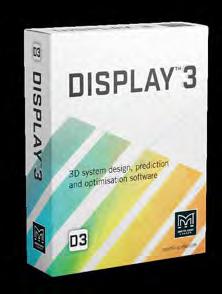
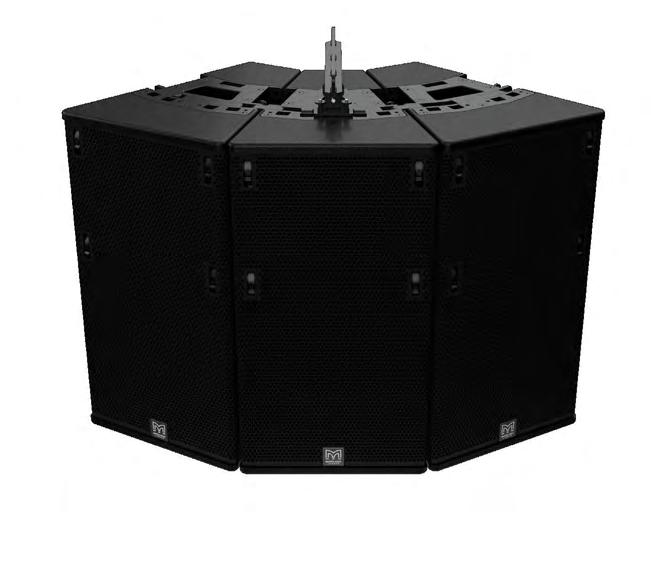
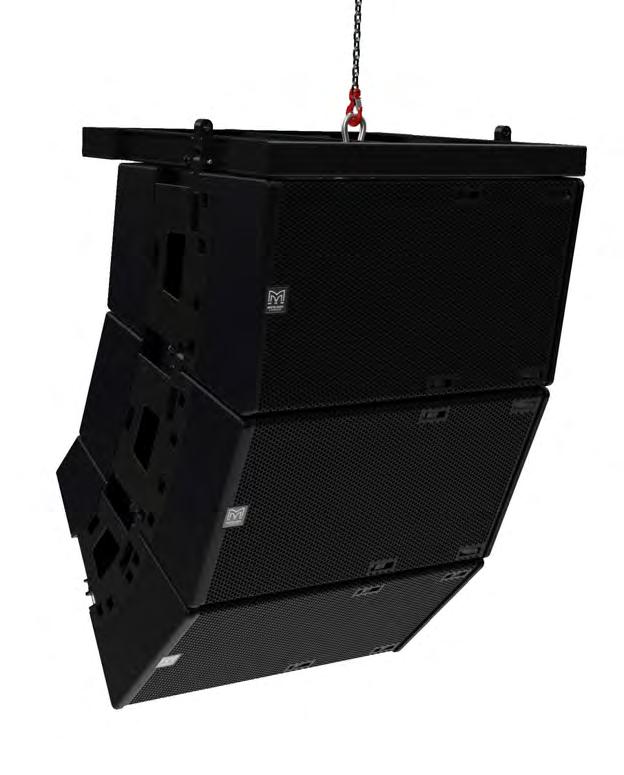

Optimised consistency, coverage and control thanks to two angled cabinets, a Dynamic Horn Flare™ and DISPLAY 3. A phase plug mounted in front of the 12” driver increases mid-band sensitivity, vocal clarity and projection, and with three 1.4” HF drivers the sonic performance is not compromised even when driven at higher SPL.
martin-audio.com
Unite Your Audience
Martin Audio Experience
The
Bigger is better for Williams AV
ASSISTIVE COMMUNICATION
specialist Williams AV has announced its WAV Pro Wi-Fi Receiver, a secondgeneration dedicated Wi-Fi audio receiver for assistive listening. It uses a mobile device optimised to be a dedicated assistive listening device. The company says its 6.8-inch HD+ Infinity display and long runtime allow for easier readability during setup. Meanwhile, the unit’s 6,000mAh
AtlasIED lightens the Atmosphere
ATLASIED IS growing its Atmosphere audio processing and control platform with the addition of three hardware units and a substantial software upgrade. The US manufacturer has expanded the ecosystem with two combined signal processor and amplification products, the Atmosphere AZMP4 (four-zone) and AZMP8 (eight-zone), as well as the Atmosphere X-ZPS, a multizone paging station accessory. Atmosphere combines digital audio processors, amplifiers, GUIs, programming software and controls to offer scalable systems to a range of applications.
The AZMP4 and AZMP8 combine audio processing and amplification in one product
and build on the AZM series of signal processors. The AZMP4 is powered by a single 600W fourchannel amplifier module, while the AZMP8 provides 1,200W of total power. Any channel can be configured to provide different wattages; for example, if there are multiple zones but one has more speakers, the AZMP can divide the power to better suit a zone with more or fewer speakers.
The Atmosphere X-ZPS adds a multi-zone paging station to AtlasIED’s AZM and AZMP processors. The X-ZPS is plugand-play using Cat5e cabling and can daisy-chain with other accessories. With a 4.3-inch touchscreen display and
gooseneck microphone, it can be configured as a full Atmosphere system controller with access to features including zone volume, source select, message recall, scene select and bell schedule.
Meanwhile, the Atmosphere 3.0 software update allows for continuous monitoring and supervision of system health and performance. A self-test feature measures system performance over time and provides notifications of any degradation of loudspeaker load. The update also introduces sound masking to provide enhanced speech privacy and reduce distracting noise for increased focus and productivity.
www.atlasied.com
to 40 hours of continuous streaming to reduce charging frequency. The receiver meets ADA hearing compliance for a dedicated assistive listening device, and it is also Bluetoothenabled to provide streaming audio to headphones, speakers and hearing aid telecoils when used with a Williams AV neck loop.
Built on a hardware-based DSP architecture, the WaveCAST C real-time audio over Wi-Fi transmitter integrates with third-party room control systems for control and monitoring using Telnet commands via Ethernet. Custom presets can also be established for specific performance applications. Inputs include ¼-inch XLR connectors, phantom power and a line level output jack on the rear of the 1U half-rack unit. In addition to multi-stage gain control inputs, the DSP features include AGC, limiters, high- and low-pass filters, and adjustable range compressor control. The WaveCAST C supports both unicast and multicast network configurations and up to four WaveCAST C systems can be connected to the same Wi-Fi network to provide multiple listening channels. Most settings can be changed via the front panel or from the hosted web interface.
www.williamsav.com
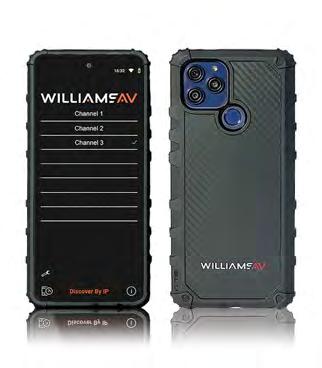
JVC extends NDI beyond PTZ
integrated 20x zoom lens with built-in ND filters and manual zoom, focus and iris control rings. Additional features include a 4-inch high-resolution LCD screen for menu navigation; LCOS viewfinder; dual XLR inputs; 3G-SDI and HDMI video outputs; and an M.2 drive slot for external SSD recording. With built-in streaming and connectivity, the cameras provide low-latency video for streaming live to Facebook and YouTube.
cameras, JVC has announced a trio of NDI-compatible broadcast cameras in the GY-HC500UN, GY-HC550UN and GY-HC500SPCN.
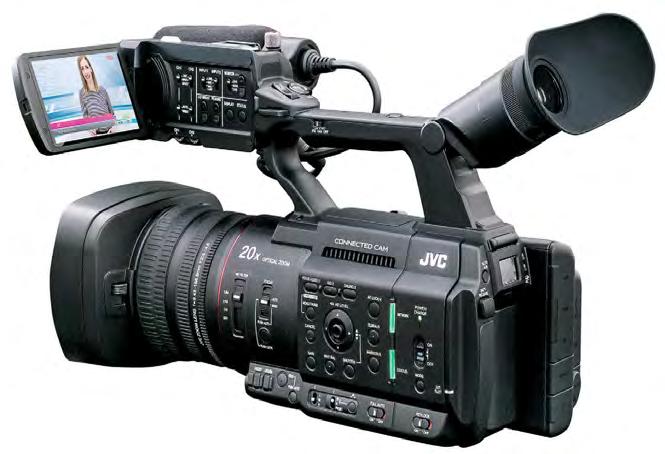
Joining JVC’s Connected Cam line of cameras, the NDI-compatible versions have been designed in response to requests from houses of worship to incorporate the cameras within their existing IP infrastructure as a source for live video with tally and IP remote control capability. Current HC500
cameras to implement the new NDI capabilities.
NDI allows devices to communicate over standard Ethernet-based networks and provides the ability to send multiple video streams over a single connection. It also allows users to integrate a combination of JVC PTZ and broadcast cameras into one workflow.

The HC500 Series cameras feature a 1-inch 4K CMOS imager and
Like all HC500 Series cameras, they can record to SSD media in 10-bit ProRes 422 at 4K resolution and 50/60p frame rates when not in NDI mode, as well as recording to other native 4K UHD and HD file formats. They are capable of recording HDR footage in hybrid log gamma (HLG) or 10-bit J-Log modes, and support 120fps slow-motion HD recording.
The GY-HC500SPCN adds the ability to provide sports graphic overlay with real-time updates via the Sportzcast/ Genius Sports SCORELINK devices, a feature exclusive to JVC.
52 WORSHIP AVL May–June 2023 PRODUCTS
www.pro.jvc.com
GY-HC500SPCN
WAV Pro Wi-Fi Receiver
Sony expands PTZ line-up
TWO 4K PTZs with built-in AI analytics have been added to the Sony catalogue. The SRG-A40 and SRG-A12 cameras automatically and consistently track, and naturally frame presenters, regardless of movement or posture, for seamless content creation and control – all without operating a computer. The new
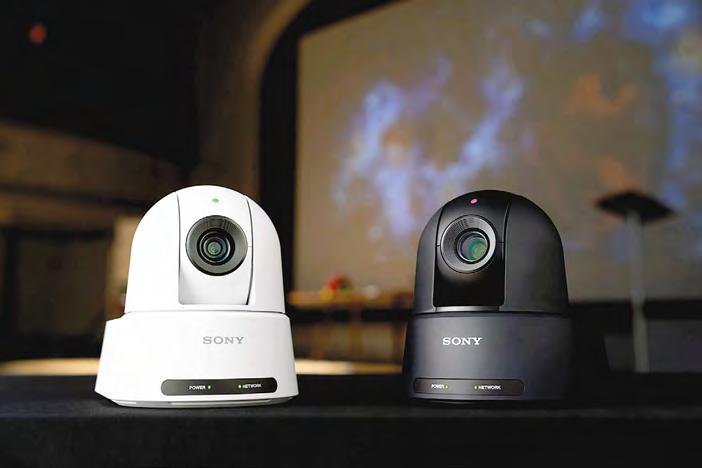
which digitally doubles the optical zoom from 20x to 30x in 4K or 40x in Full HD, while the SRG-A12 provides up to 12x zoom. With tele convert mode, the SRG-A40 can extend up to 80x zoom, while the SRG-A12 can extend up to 24x, all while offering smooth, fast PTZ movement between cameras. Day mode and night mode help optimise
Canon CR-N700 4K gets auto tracking and auto loop add-on

CANON HAS upcoming Add-On Applications System for PTZ (Pan-Tilt-Zoom) remote cameras that will provide access to add new paid video production features, beginning with auto tracking and auto loop applications for the company’s 4K PTZ camera, the CR-N700. The auto tracking application will give the CR-N700 the ability to automatically pan, tilt and zoom to track moving subjects, and the auto loop application will allow users to program and automate repeated camera movements. The Add-On Applications System will be added to the CR-N700 via a future firmware update. Going forward, Canon plans to expand the line-up of its Add-On Applications System, as well as the line-up of compatible remote camera models.
rediscovery, as well as multiple Auto Framing options. Highlights of the cameras include image quality with automation, the flexibility of IP, powerful zoom, remote control, and easy configuration and operation. They are suitable for faith applications, as well as for live events.
Both the SRG-A40 and SRG-A12 adopt a highly sensitive Exmor R CMOS sensor for high-quality, naturally vivid images with less noise that support 4K30p and Full HD 60p. The SRG-A40 offers Clear Image Zoom technology
available through optional licence) and can be controlled remotely through VISCA/VISCA over IP, using a single network cable for power, output and control. They also incorporate PoE++, allowing for simplified integration into new or existing environments, without separate power supply cabling. Support for Real Time Streaming Protocol (RTSP) allows for remote viewing, while Security Reliable Transport (SRT) protocol enables safe, smooth, stable video streaming.
pro.sony
Magmatic introduces high-output fogger
THE MAGMA Fog 1500 IP is the first dedicated fog generator in Magmatic’s Magma series of haze and fog machines. The unit is described as a durable, IP65-rated, water-based fog machine with a high output fog for a wide range of professional applications. It is designed to be an all-purpose fogger to add atmosphere to stages in busy venues and demanding rental projects
alike, indoors or out. A thermally protected, 1,500W heat exchanger produces an output of 60,000 CFM (cubic feet per minute) and, when operating at 100%, the unit can shoot a 40s burst of dense fog. Housing a
These initial paid add-on applications run from within the camera itself, while competitive models may require end users to run an external device to operate the auto tracking and auto loop applications. With the addition of the Add-On Applications System, customers can now directly add the new capabilities to the PTZ camera.
The auto tracking is described as responsive, allowing for full body, upper body and head and torso tracking at both slow and normal walking speeds, and full body and upper body tracking at fast walking speed. In addition, the auto
with a wide range of adjustment functions, such as composition, tracking sensitivity, priority display area, fixed viewing angle area, tracking target auto select, pan/ tilt halting area, initial position, auto select exclusion and pan/tilt operation control. The auto tracking add-on application is particularly suited to end users in markets such as houses of worship.
The auto loop paid add-on app helps automate repeated camera movements, potentially lessening the burden on camera operators. Camera operators will now have the flexibility to select between two repeated movements, loop or backand-forth, based on needs and the shooting environment.
www.canon.co.uk
5l tank, the Magma Fog 1500 IP has a fluid consumption rate of 200ml/min and comes in an aluminium housing with carrying handles and a hanging bracket for truss mounting.
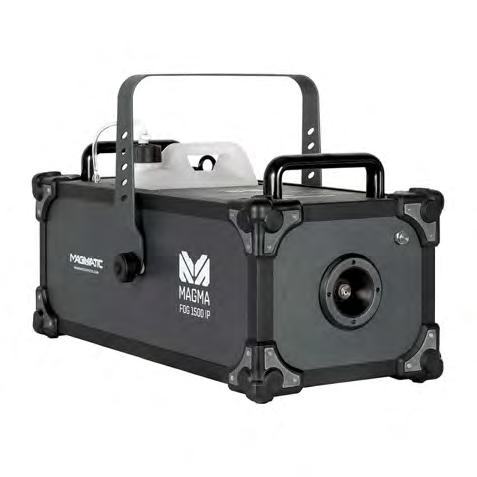
It also features an onboard LCD touchscreen control panel with manual and timer control options, DMX-512 and RDM control, and optional wired and wireless remote control options. It comes with IP65 locking power in and IP65 locking XLR connectors (DMX I/O) for safe and reliable operation outdoors.
www.magmaticfx.com
May–June 2023 WORSHIP AVL 53 PRODUCTS
CR-N700
SRG-A40
Hippotizer v4.8 brings integration enhancements
GREEN HIPPO has unveiled a Hippotizer v4.8 software update for its range of media servers, adding a range of upgraded features designed to power-up real-time media manipulation, playback and mapping. One enhancement is Show Manager, said to facilitate control of
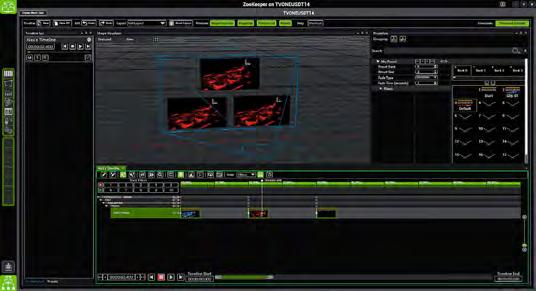
referencing. For productions run by multiple users of one machine, shows can be locked to protect them from any unwanted edits, and HippoLauncher can now be controlled by TCP Commands allowing users to start up or switch into the designed show.
Analog Way upgrades its Midra 4K series
multiple productions and installations at once. It allows users to easily save and load various shows on one Hippotizer media server, simplifying show management and switching between events. Within this, shows can be duplicated to enable quick modifications without affecting the primary show data, and each show can be labelled for one-glance
In TimelinePlus, pre-recorded looks can be transferred onto the Preset Timeline for show programming. The Hippotizer SHAPE tool introduces Dockable Windows, aiding customisable workspace management and enhancing 3D project visibility.
www.green-hippo.com
WITH THE release of a v3.0 software update for the Midra 4K range of presentation switchers, Analog Way has enhanced livestreaming capabilities together with support for HDR workflows and 3D Lookup Tables (LUTs) used for colour conversion and correction. With v3.0, the livestreaming performance of Midra 4K presentation switchers enables Full HD quality livestreaming at 30Hz, providing an improved image quality during hybrid events.
A further improvement is the support of High Dynamic Range (HDR) and Wide Colour Gamut (WCG) workflows for live presentations. Bypassing the need for external converters, v3.0 converts SDR to HDR, HDR to SDR and HDR to HDR for dynamic range and wide colour gamut needs.
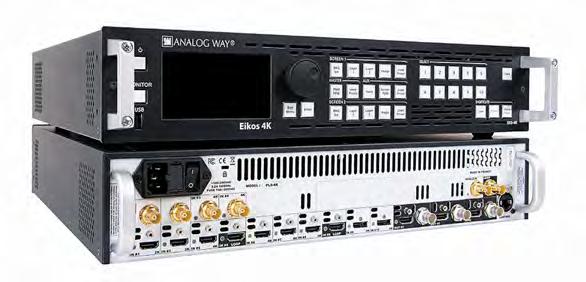
Allowing for advanced colour space and dynamic range conversions in addition to custom colour correction, Midra 4K presentation switchers feature a video processing architecture based on 3D LUTs. Once updated, Midra 4K switchers contain predefined 3D LUTs for all automatic colour adjustments and transformations. Custom 3D LUTs can be imported and applied from other vendors or those generated by specific third-party tools for bespoke colour management. Designed for small and medium-sized fixed installations and live event spaces, the Midra 4K series currently includes four products: QuickVu 4K, QuickMatrix 4K, Pulse 4K and Eikos 4K.
www.analogway.com
Titan v16.0 focuses on speed and efficiency
DESCRIBED AS a major new release, v16.0 of Avolites Titan lighting and media control software platform introduces two new main features developed to assist programmers and operators by providing better access to the data they need.
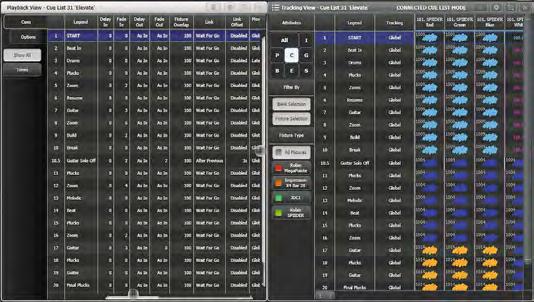
The new Freeform Layout view provides the ability to arrange and select fixtures in a 2D layout either manually or automatically from the integrated Capture visualiser –streamlining the workflow from design to programming. It provides a visual representation of the current state of the fixtures and can be accessed from a new Layouts window and Layout handle type. With this new function, group handles can be included in layouts to further assist fixture selection. Multiple layouts can also be created providing the ability to have more than one arrangement of fixtures
or to separate fixtures into specific layouts. Additionally, the view supports multitouch gesture controls for zoom and pan.
A new window called Cue List Tracking View provides a way to view and edit the values and tracking of individual fixtures and attributes in a cue list. A View Tracking button has
also been added to the Playback View context menu. Selecting it opens the Tracking View window with the associated playback cues. Selecting the Select Cue List option from the Tracking View context menu will open a menu where users can select other cue lists. The window will remember the last selected cue
list when opened and, if it is opened without a cue list, it will prompt to select one. With additional bug fixes and improvements, the update can be downloaded for free from the Avolites website.
The manufacturer has also called time on its Titan Mobile professional lighting control surface with the launch of the T3. Created in collaboration with leading lighting designers, Avolites says the T3 is the lightest, smallest and most portable console the company has ever produced. It shares a design language first seen in Avolites’ Diamond 9 and joins the T1 and T2 to expand the company’s range of PCpowered T-Series consoles. Although production on the Titan Mobile has now ceased, the Titan Mobile Wing is still available to purchase for use with a Quartz console.
www.avolites.com

54 WORSHIP AVL May–June 2023 PRODUCTS
Titan v16.0
Ovation CYC 3 FC does more with less
DESIGNED FOR broadcast
vertical beam spread. Chauvet

down time. Both are fully compatible with each other, which means they can be used together, and both are low profile to enable them to be placed discretely.
The unit’s built-in kick stand and
and its CRI at 3,200K is 90. Other features include three independent pixel sections and 16-bit dimming of the master dimmer and individual colours, while its convection cooling allows it to operate silently.
AV RANGERS,
25–50° zoom lens, the Ovation E-2 FC aims to deliver the kind of performance associated with larger fixtures, but in a compact body that makes it ideally suited for small and mid-sized applications.
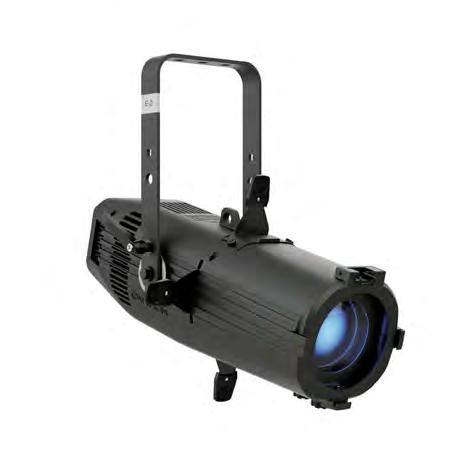
Weighing less than 6.8kg and measuring 461mm x 310mm x 445mm, the fixture puts out 1,107
in addition to rendering colours, it projects sharp gobos intended to add depth. A dedicated focus mode button allows one-touch focusing without the aid of a board operator. A virtual colour wheel and preset white CCTs have also been added. The fixture can be controlled via DMX or RDM.
Other features include selectable PWM, ±green adjustment and emulated red-shift, a built-in gobo

PRODUCTS
By AV-ICN Expo
in DELIVERING BUSINESS.
for AV-ICN
Display, Digital
top industry
display a wide range of state-of-art AV technology. INDIA’S EMERGING EXPO ON PRO AV SOLUTIONS. SCAN QR CODE TO REGISTER. 25 - 27.05.2023 : NESCO, MUMBAI, INDIA www.av-icn.in ASSEMBLE! Ovation CYC 3 FC Ovation E-2 FC
believes
The Theme
is
Signage, Projection. This is your chance to meet
players who will
Lighting to the CORE
EQUIPSON BRAND LightShark has unveiled its LS CORE iO lighting console which offers a web-based interface accessible from smart devices such as phones, tablets and computers that supports most protocols (DMX512, Art-Net, sACN, MIDI, UDP, OSC and HTTP). The console is compatible with integration systems such as Crestron, AMX or Control 4, incorporates GPIO ports and implements RS-232 and RS-485 protocols. It also features a dedicated alarm port which offers the possibility of prioritising a specific state over the scenes playing at that time and incorporates a real-time clock that maintains accuracy for up to five years. The LS W1 remote control completes the system – a wall-mount touch device with eight programmable buttons to control scenes and trigger any other action from the console. With the LS W1, users doesn’t have to access the software interface to
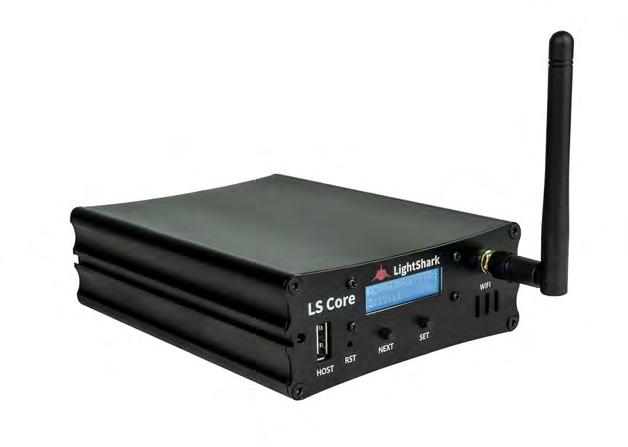
the manufacturer says provides the ability to interface with other pieces of equipment. The upgrade also includes improvements to Autosave, Go To Cue/Preload Cue and Channel/Fixture Parking features, as well as being able to assign custom icons to palettes. Designed for use in environments from small theatres to large stadia, the LightShark range includes the LS-1 hardware console, the LS-Core, the LS-Wing Open Sound Control (OSC) hardware controller and three multiprotocol DMX streaming devices
Ayrton releases IP65rated Domino Wash
AYRTON HAS taken the wraps off its first IP65-rated product, the Domino Wash. Described as a smart luminaire providing versatility for live events, the fixture has a 210mm Fresnel lens with a specific optical structure designed to accurately adapt the diffusion level according to requirements. This optical combination not only favours the use of framing shutter blades or geometric gobos, but is said to significantly improve colour mix and can produce 10% more light than with a classic Fresnel lens.

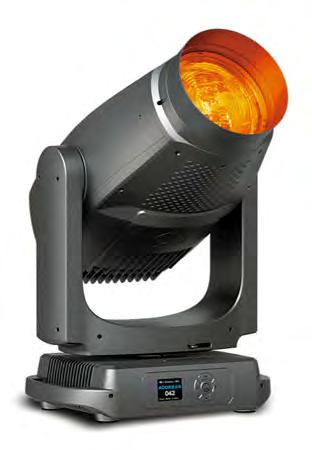
the Domino Wash is available in three flicker-free versions: S, TC and ST or “Stage and Theatre” version. The ST version is fitted with a monochromatic LED source that delivers a light output of 45,000 lumens and a D65 white point that allows colour reproduction with a CRI greater than 80. The S, or “Stage”, version provides a cooler, metallic light with a luminous flux of 52,000 lumens, a colour temperature of 7,000K and a CRI of 70. The TC, or “True Colour”, version offers a colourrendering index greater than 95 with high TM30 values and a colour temperature of 6,000K. The fixture’s proprietary optical system delivers a 12:1 zoom ratio and a zoom range of 6.2° (at half peak) to 75° (at one-tenth peak).
It shares the same colour-mixing system with Ayrton’s Huracán Wash, offering a double level of CMY saturation that can obtain 281 trillion colours and a triple corrector for variable colour temperature, allowing subtle adjustment from 2,700K to 15,000K and significant CRI improvement.
www.ayrton.eu
at the same time as playing different cues, allowing users to control other equipment directly from LightShark. It includes the devices’ personalities already developed for the LS-Wing, which the company says makes LightShark the first lighting controller that has OSC and UDP control personalities for other devices such as audio controllers and media servers. The software also adds OSC messages including TAP button command of a Playback and adjustment of its tempo; commands
to reset aspects of the speed master and the Chase speed master; and messages to give users fine control of the Go To Cue button including the ability to preload it. Users can now send OSC commands from a Cue and to deploy a keyboard to control LightShark using a variety of shortcuts. AutoSave is improved by making it possible to exclude fixtures from a show without having to unpatch them; freeze a fixture or specific channel with an existing value in the programmer; automatically scroll the CueList to show Active Cue and exclude a playback from being controlled by the Grand Master.
Lighting engineers can now also Go To Cue in the next Go, renumber a cue as 0.x, change the fixture ID in the patch window and set the value of both Playbacks and the programme window in percentage or decimal.
www.lightshark.es
Claypaky heads outdoors
LIGHTING SOLUTIONS
Claypaky has added a raft of products to its growing catalogue. The Aqua Series has been designed for outdoor installations and also for rental companies with outdoor productions. The units offer IP66 protection, with some fixtures offering marine-grade C5-M protection. The Mini-B Aqua has been created to meet the demand from lighting professionals for a weather-resistant, lightweight, compact, agile mini-washlight. The unit can also be used indoors since it does not require the same levels of maintenance as ordinary IP20 lights thanks to the fixture’s protection against dust.
The manufacturer has also entered the effects market. The Mini-B Spot can be combined with the Mini-B and Mini-B Aqua and provides a 70W white LED engine capable of delivering 4,300 lumens, but with a power consumption of only 150W. Claypaky has also developed a proprietary optical unit that optimises light intensity and light output. The Mini-B Spot has been created for the installation where versatile, small fixtures with a big impact are sought after.
The Tambora Linear 60 is a compact, 60mm static LED pixel bar designed for versatile lighting effects and artistic set decorations. It offers all the features of the Tambora Linear
LED bar range and is particularly suitable for applications in narrow environments.
The Volero Wave is a LED bar made up of a system of eight moving heads, each one independently capable of a 220° tilt, producing three-dimensional volumetric projections. Each of these heads contains a mirror-based optical system combined with 40W RGBW LEDs. Their synchronised movement produces a wave of light, which can be enhanced by adding more Volero Waves as they can be connected to each other.
www.claypaky.it
56 WORSHIP AVL May–June 2023 PRODUCTS
Mini-B Aqua
Elation shines more light in more locations
SHINING A light on a wider range of locations, the full-colour-spectrum soft light of Elation’s KL Panel XL is now available in an IP65 version. The weatherproof design allows it to function in harsh environments and adverse conditions, eliminating the need for frequent cleaning and maintenance and saving both time and cost.
Elation says the 840mm x 366mm KL Panel XL IP offers precise control over colour temperature and fullspectrum colour rendering for an even wash coverage. Optimised for the white light requirements of broadcasting, it is designed to
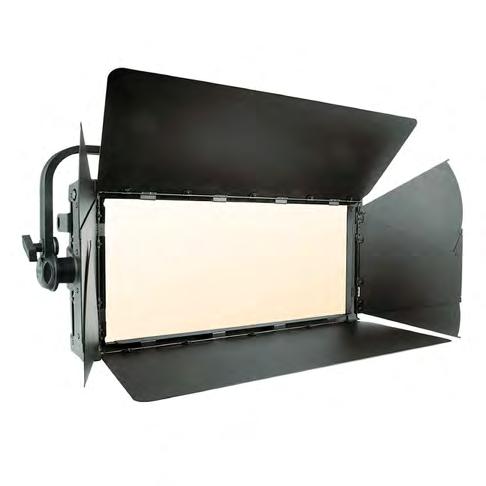
provide highly variable lighting for key, fill and backlight.
It uses a 570W RGBW, lime and cyan LED array and can produce soft white or full-colour washes up to 40,000 field lumens at a 100° half-peak angle. Colour reproduction is accurate with a CRI of 95, while colour temperature is adjustable from 2,000–10,000K for a wide range of variable colour or white shade projections. Additional colour tuning is possible through a green-shift adjustment and virtual gel library to precisely match the white balance for the camera.

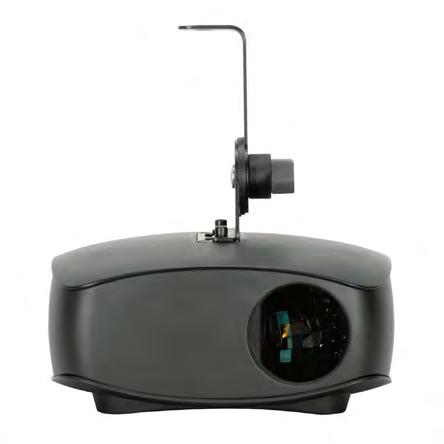
Take flight with
OBSIDIAN CONTROL Systems has introduced two compact wings as companions to its NX1 console and ONYX PC systems. Designed for the ONYX lighting control platform, the NX P is a portable and compact motorised fader wing, while the NX K is a small USBpowered control surface. A simple magnetic alignment system allows attachment to any side of an NX1 console, NX K command pad or NX P motorised fader wing. functionality of Obsidian’s NX1 and
such as fire, lightning, emergency vehicle flashes and strobes. It features smooth 16-bit dimming and selectable dimming curve modes, and comes with a diffuser as well as adjustable and removable eight-leaf barn doors to customise beam shape
and reduce light spill. Meanwhile, the KL Panel XL IP has a 900Hz–25kHz LED refresh rate adjustment
The KL Panel XL IP can be powered remotely through its integrated fourpin XLR 24–36 VDC battery input and consumes 681W at maximum power. Control options include DMX/RDM, Art-Net and sACN.
www.elationlighting.com
NX4 console surfaces, the NX P expands the NX1 console and ONYX PC systems. Its four integrated DMX ports provide connectivity to the lighting system and its button array can be mapped to playback control or function keys. Multiple NX P wings can be connected to expand direct access with 20 playbacks at a time.
Vortex creates a blaze of colour
DESIGNED TO create a blaze of colour and movement, Eliminator
Lighting’s Vortex is a compact lighting fixture that combines a gobo flower effect with a rotating mirror barrel. Measuring 312mm x 282mm x 157mm and weighing 3.2kg, it is easy to store, transport and set up, with a mounting bracket that locks into place using a pair of thumb-tightening screws and either mounted to the top of a tripod or hung from a truss or T-bar.
The Vortex uses an 80W white light LED engine positioned behind a combined colour and gobo wheel to offer 10 colour and gobo pairings
capable of generating both aerial beam effects and surface pattern projections. A manual focus knob can be used to ensure sharp gobos at variable projection distances. The light from the LED engine is directed through the colour/ gobo wheel onto a bidirectional rotating mirror dish, which multiplies the single 5° beam, while any patterns generated by the mirror dish are reflected from the external rotating mirror barrel to output a myriad of animated beams. In addition to continuous 360° rotation, the mirror barrel can also pan through 180°, which allows the fixture’s beams to fill an entire room.
Featuring a 10W laser module with a 10,000-hour projected operational life, the Cosmic Burst is Eliminator Lighting’s latest effects fixture. It generates a unique effect with a massive beam spread and its laser output is diffracted into hundreds of separate beams that are reflected by two separate mirror dishes. Each dish offers independent bidirectional rotation at variable speed, allowing for the creation of a variety of different effects.
High energy patterns are formed when both dishes rotate at speed. This will create a blaze of fast-moving beams in a haze-filled atmosphere or project intricate patterns onto a wall or ceiling comprised of countless coloured dots weaving in and out of each other at different speeds. The fixture can also strobe, while a more
The NX P has 10 motorised playbacks and 10 playback/function hybrids, as well as a Master Go section. The NX K is a portable and compact USB keypad which replicates the full keypad and command section of larger consoles. Four encoders with push and LED feedback complete the programming experience for fast and direct parameter access.
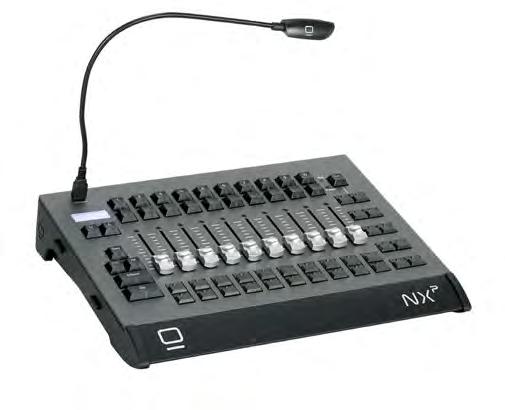
www.obsidiancontrol.com
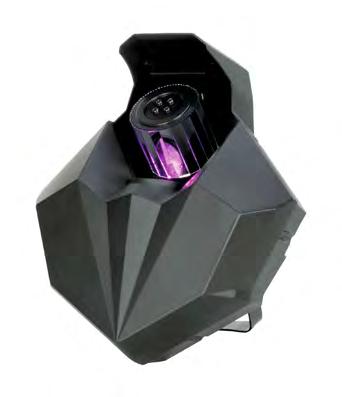
subtle effect can be created using the pulse/twinkle function. Instead of moving, this involves hundreds of static beams flashing momentarily off and back on to create a “night sky” effect.
www.adj.com/eliminator-lighting
May–June 2023 WORSHIP AVL 57 PRODUCTS
Vortex
NX P
Cosmic Burst
Keeping it simple
BEGINNING TO PLAN FOR
retirement, David Lusk sold his highend residential company Audio Video Technologies to his partner four years ago. “But God had different plans for me,” he laughs. At the start of the pandemic, he established AVTECH
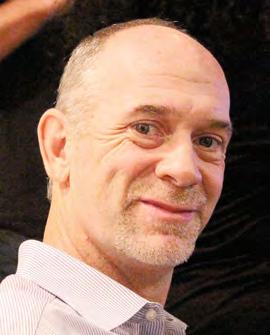
Integrations with his brother, focusing on video conferencing. However, as a devout Catholic, he also wanted to use his talents to help churches find the most suitable – and budgetfriendly – audio systems. “I quickly figured out that some of the systems being sold into Catholic churches were too sophisticated. I started asking myself whether there was a simpler way of doing things, so I began designing systems that were easier to use and had a high impact on the intelligibility of the Gospel.”
Lusk carried out his first church installation at Saint Columban in Garden Grove, California, in 2016 where he took an older 1970’s system of 32 speakers and consolidated it down to a two-cabinet array design. “Those two arrays evenly filled the whole church and gave them intelligibility that was 10 times better than the original design.” A second church – Saint Kilian in Mission Viejo, California –followed a similar concept. “They had a huge vertical array hanging from the centre with another 20-plus speakers trying to cover the wings. And it wasn’t even an old system – it had only been in place for a little over four years but it had been overdesigned and it was just way too much for their needs. So, we took everything out and replaced it with an Active Audio two-column vertical array design.”
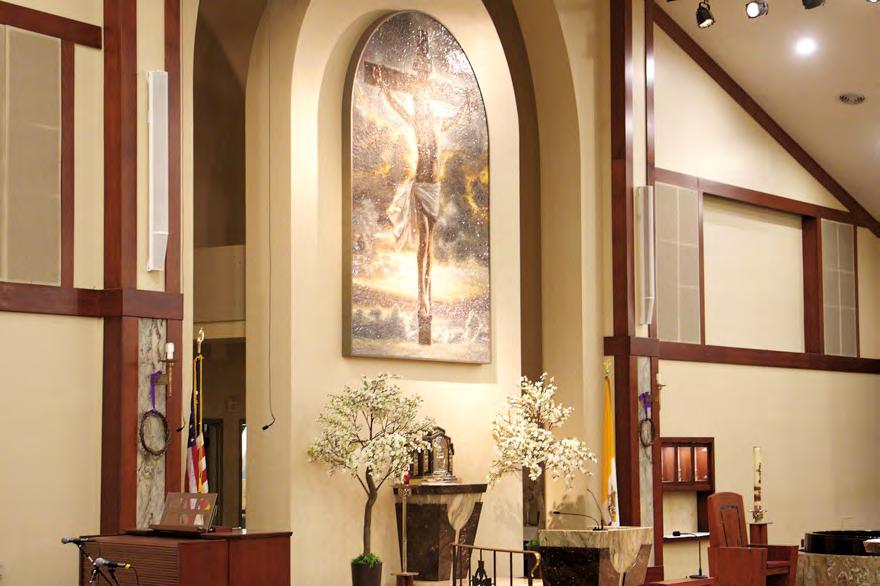
Lusk’s affiliation with Active Audio stretches as far back as his first house of worship installation. “I met Jeff [Miranda, sales manager at Allied ProTech] through our work at Saint Columban – he was working for Renkus-Heinz at the time. He was brought in as a consultant on the
project and I agreed with everything he was proposing – we were on the same wavelength.” The slender column design and beam-steering technology of the Active Audio speakers allows Lusk to design a system that will cover the spoken word evenly, without imposing too much on the aesthetics. The Active Audio columns are a vertical design allowing for different levels of height depending on how much space needs to be covered. Lusk will also boost the low frequencies of the speakers with subwoofers but these can be easily hidden and placed out of sight.
After his first installation at Saint Columban, word got out of his work at the Catholic churches. “It’s a small community,” Lusk explains.
“All the priests talk to one another and if there’s something good going on, word spreads quickly.” And a good job too, because Lusk says that he’s yet to come across a Catholic church that has been built
for sound. He describes his most recent project – Saint Martin de Porres in Yorba Linda, California – as a struggle. “When they remodelled the interior of the church, all the changes went completely against sound support. They replaced carpet on the main walkways with reflective marble, which, along with all the other beautiful but reflective changes around the altar area combined with the existing glass windows at the front, side and back of the church, made the new environment harmful to the sound. One of our solutions was to acoustically treat some of the areas of the church to help absorb the reflections that were being created.”
One of the other challenges Lusk often faces in his house of worship installations is the congregation. “There’s such a diversity of people in the Catholic church,” he explains. “The priest is there to bring the word of God but sometimes a church will have seven different
masses a day and each mass will have a different choir – a Spanish choir, a Vietnamese choir – each with their own instruments and sound requirements. They all want to hear the word but their priorities on what is important to them specifically are so diverse – it’s always a challenge. You need to hear the word – that’s the primary focus. All the different choirs are beautiful and add to the service but the intelligibility of the Gospel has to come first.”
It doesn’t look like retirement is on the cards for Lusk any time soon. In September last year, he acquired Audio Video Technologies back after former clients started contacting him directly asking for help. “I hadn’t planned on going back into residential but I’ve merged it in with the church projects and some of the other commercial work we do. I guess God isn’t done with me yet.”
www.avtechintegrations.com
58 WORSHIP AVL May–June 2023 THE TECH VIEW
David Lusk
Co-founder at AVTECH Integrations, David Lusk has been designing audio systems for Catholic churches that focus on the intelligibility of the spoken word
Active Audio speakers at Saint Kilian
The Adamson Fletcher Machine Remote software offers an easy-to-use yet complete set of mixing functionalities, including EQ, compression, auxiliary sends, and much more. To learn more about the Adamson Fletcher Machine visit our website at www.adamsonsystems.com

MIXER PAGE

Send on Fader for Speakers, Aux, Reverb and VCAs


Dedicated Page for Solo in Place
Custom Fader Page
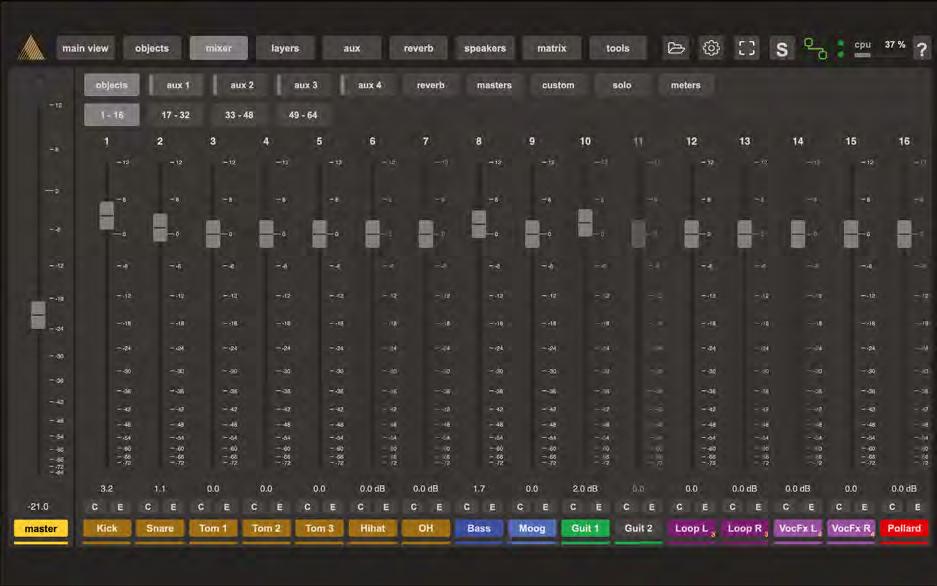
Mixdown
OBJECT TRAJECTORY
Embedded 2D/3D Trajectory Generator


Single / Loop Modes


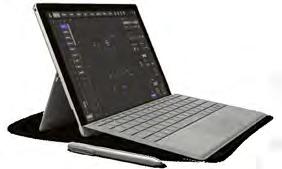

Trajectory recall

VIRTUAL FLETCHER MACHINE Connects with the Fletcher Machine Remote software without the requirement of a dedicated hardware engine. Download now | Free of charge!
SOKA
INTEGRATE DISCREETLY
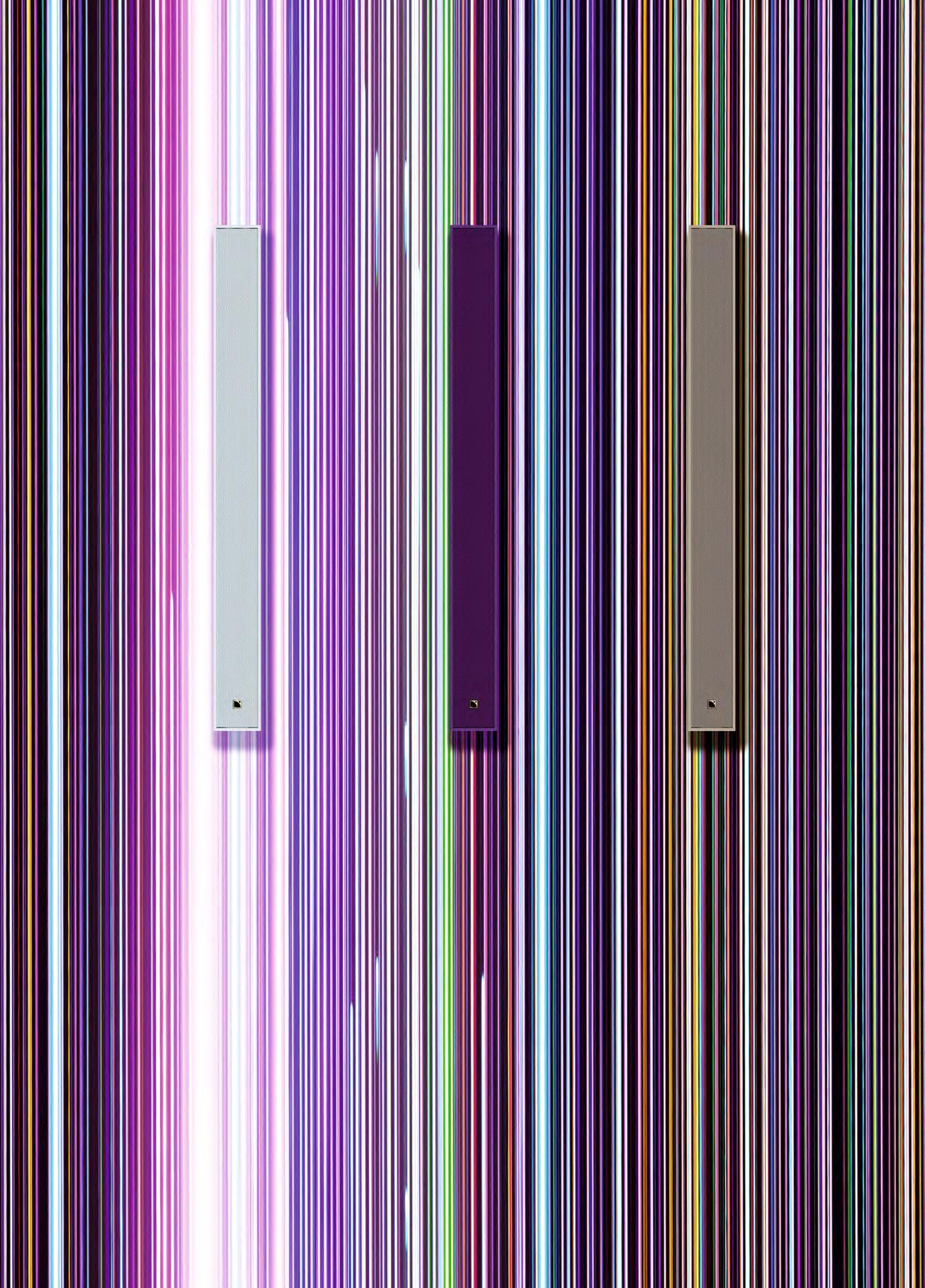










































































































































 Active Audio an Arbane Groupe brand
Active Audio an Arbane Groupe brand

























































 Professional AudioVisual manufacturers
Professional AudioVisual manufacturers












































































